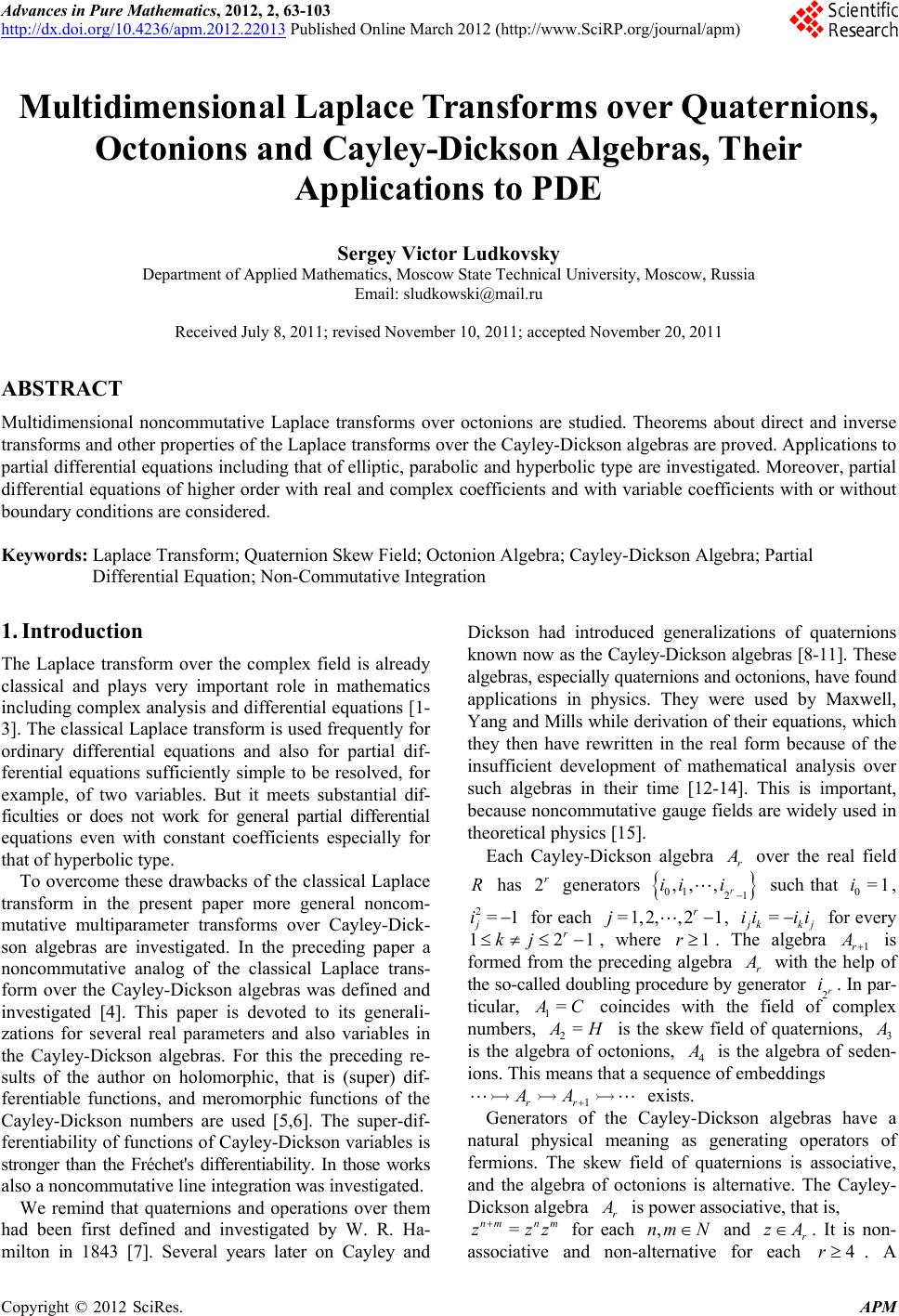 Advances in Pure Mathematics, 2012, 2, 63-103 http://dx.doi.org/10.4236/apm.2012.22013 Published Online March 2012 (http://www.SciRP.org/journal/apm) Copyright © 2012 SciRes. APM Multidimensional Laplace Transforms over Quaternions, Octonions and Cayley-Dickson Algebras, Their Applications to PDE Sergey Victor Ludkovsky Department of Applied Mathematics, Moscow State Technical University, Moscow, Russia Email: sludkowski@mail.ru Received July 8, 2011; revised November 10, 2011; accepted November 20, 2011 ABSTRACT Multidimensional noncommutative Laplace transforms over octonions are studied. Theorems about direct and inverse transforms and other properties of the Laplace transforms over the Cayley-Dickson algebras are proved. Applications to partial differential equations including that of elliptic, parabolic and hyperbolic type are investigated. Moreover, partial differential equations of higher order with real and complex coefficients and with variable coefficients with or without boundary conditions are considered. Keywords: Laplace Transform; Quaternion Skew Field; Octonion Algebra; Cayley-Dickson Algebra; Partial Differential Equation; Non-Commutative Integration 1. Introduction The Laplace transform over the complex field is already classical and plays very important role in mathematics including complex analysis and differential equations [1- 3]. The classical Laplace transform is used frequently for ordinary differential equations and also for partial dif- ferential equations sufficiently simple to be resolved, for example, of two variables. But it meets substantial dif- ficulties or does not work for general partial differential equations even with constant coefficients especially for that of hyperbolic type. To overcome these drawbacks of the classical Laplace transform in the present paper more general noncom- mutative multiparameter transforms over Cayley-Dick- son algebras are investigated. In the preceding paper a noncommutative analog of the classical Laplace trans- form over the Cayley-Dickson algebras was defined and investigated [4]. This paper is devoted to its generali- zations for several real parameters and also variables in the Cayley-Dickson algebras. For this the preceding re- sults of the author on holomorphic, that is (super) dif- ferentiable functions, and meromorphic functions of the Cayley-Dickson numbers are used [5,6]. The super-dif- ferentiability of functions of Cayley-Dickson variables is stronger than the Fréchet's differentiability. In those works also a noncommutative line integration was investigated. We remind that quaternions and operations over them had been first defined and investigated by W. R. Ha- milton in 1843 [7]. Several years later on Cayley and Dickson had introduced generalizations of quaternions known now as the Cayley-Dickson algebras [8-11]. These algebras, especially quaternions and octonions, have found applications in physics. They were used by Maxwell, Yang and Mills while derivation of their equations, which they then have rewritten in the real form because of the insufficient development of mathematical analysis over such algebras in their time [12-14]. This is important, because noncommutative gauge fields are widely used in theoretical physics [15]. Each Cayley-Dickson algebra r over the real field R has 2r generators 01 21 ,, ,r ii i such that 0=1i, 2=1 j i for each =1,2,,21 r j, = kkj ii ii for every 121 r kj , where 1r. The algebra 1r is formed from the preceding algebra r with the help of the so-called doubling procedure by generator 2r i. In par- ticular, 1= C coincides with the field of complex numbers, 2= H is the skew field of quaternions, 3 is the algebra of octonions, 4 is the algebra of seden- ions. This means that a sequence of embeddings 1rr AA exists. Generators of the Cayley-Dickson algebras have a natural physical meaning as generating operators of fermions. The skew field of quaternions is associative, and the algebra of octonions is alternative. The Cayley- Dickson algebra r is power associative, that is, = nmn m zzz for each ,nm N and r zA. It is non- associative and non-alternative for each 4r. A 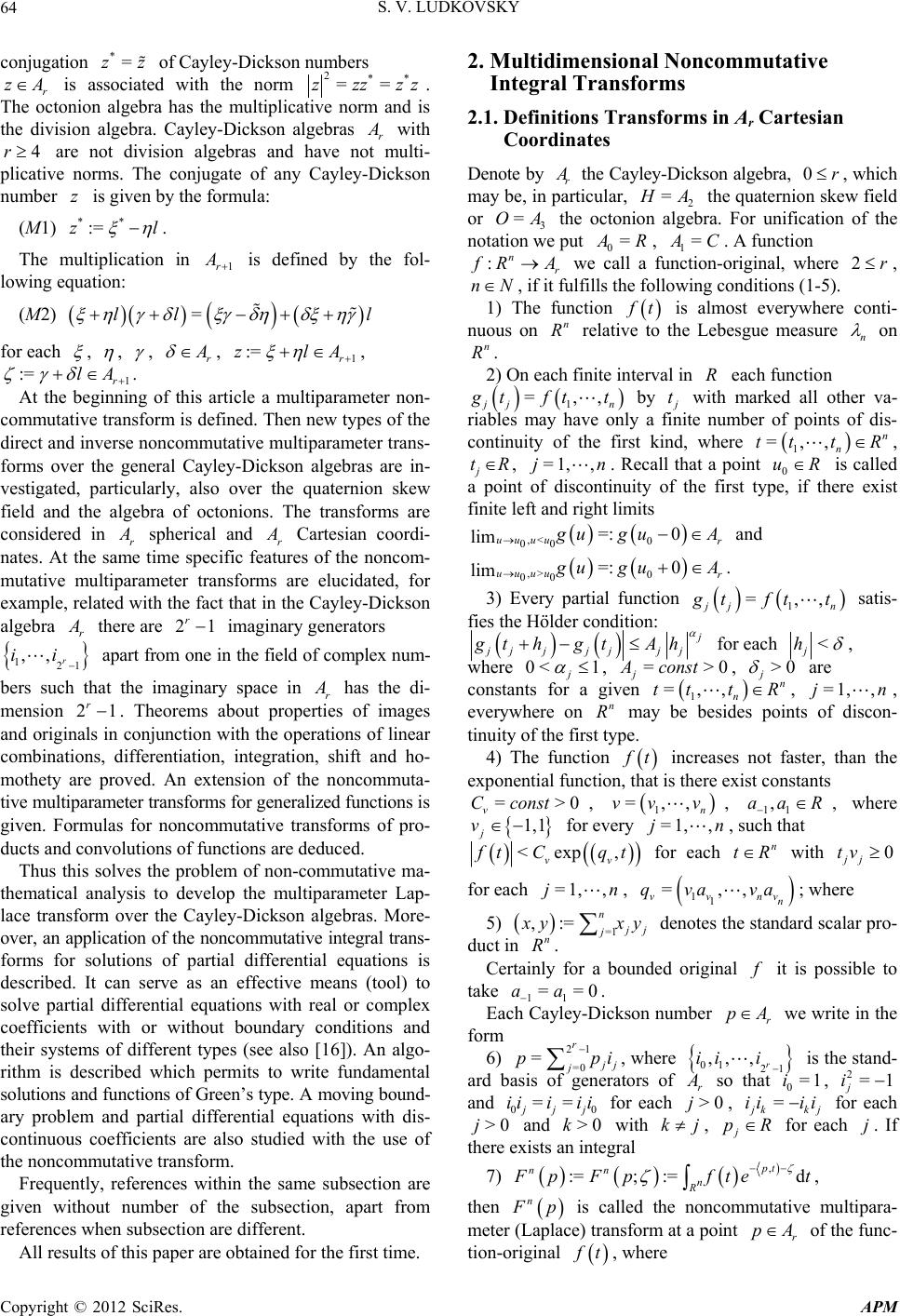 S. V. LUDKOVSKY Copyright © 2012 SciRes. APM 64 conjugation *=zz of Cayley-Dickson numbers r zA is associated with the norm 2** ==zzzzz . The octonion algebra has the multiplicative norm and is the division algebra. Cayley-Dickson algebras r with 4r are not division algebras and have not multi- plicative norms. The conjugate of any Cayley-Dickson number z is given by the formula: (M1) ** :=zl . The multiplication in 1r is defined by the fol- lowing equation: (M2) =ll l for each , , , r , 1 := r zlA , 1 := r lA . At the beginning of this article a multiparameter non- commutative transform is defined. Then new types of the direct and inverse noncommutative multiparameter trans- forms over the general Cayley-Dickson algebras are in- vestigated, particularly, also over the quaternion skew field and the algebra of octonions. The transforms are considered in r spherical and r Cartesian coordi- nates. At the same time specific features of the noncom- mutative multiparameter transforms are elucidated, for example, related with the fact that in the Cayley-Dickson algebra r there are 21 r imaginary generators 121 ,, r ii apart from one in the field of complex num- bers such that the imaginary space in r has the di- mension 21 r. Theorems about properties of images and originals in conjunction with the operations of linear combinations, differentiation, integration, shift and ho- mothety are proved. An extension of the noncommuta- tive multiparameter transforms for generalized functions is given. Formulas for noncommutative transforms of pro- ducts and convolutions of functions are deduced. Thus this solves the problem of non-commutative ma- thematical analysis to develop the multiparameter Lap- lace transform over the Cayley-Dickson algebras. More- over, an application of the noncommutative integral trans- forms for solutions of partial differential equations is described. It can serve as an effective means (tool) to solve partial differential equations with real or complex coefficients with or without boundary conditions and their systems of different types (see also [16]). An algo- rithm is described which permits to write fundamental solutions and functions of Green’s type. A moving bound- ary problem and partial differential equations with dis- continuous coefficients are also studied with the use of the noncommutative transform. Frequently, references within the same subsection are given without number of the subsection, apart from references when subsection are different. All results of this paper are obtained for the first time. 2. Multidimensional Noncommutative Integral Transforms 2.1. Definitions Transforms in Ar Cartesian Coordinates Denote by r the Cayley-Dickson algebra, 0r , which may be, in particular, 2 = A the quaternion skew field or 3 =OA the octonion algebra. For unification of the notation we put 0= R, 1= C. A function :nr RA we call a function-original, where 2r , nN , if it fulfills the following conditions (1-5). 1) The function t is almost everywhere conti- nuous on n R relative to the Lebesgue measure n on n R. 2) On each finite interval in R each function 1 =,, jn tftt by t with marked all other va- riables may have only a finite number of points of dis- continuity of the first kind, where 1 =,,n n ttt R, j tR , =1, ,jn. Recall that a point 0 uR is called a point of discontinuity of the first type, if there exist finite left and right limits ,< 0 00 =: 0 limuuuu r ugu A and ,> 0 00 =: 0 limuuuu r ugu A . 3) Every partial function 1 =,, jn tftt satis- fies the Hölder condition: jj jjjjj gt hgtAh for each < j h , where 0< 1 j , =>0 j Aconst , >0 j are constants for a given 1 =,,n n ttt R, =1, ,jn, everywhere on n R may be besides points of discon- tinuity of the first type. 4) The function t increases not faster, than the exponential function, that is there exist constants =>0 v Cconst , 1 =,, n vv v, 11 ,aa R , where 1,1 j v for every =1, ,jn, such that <exp , vv tC qt for each n tR with 0 jj tv for each =1, ,jn, 11 =,, vvnv n qvava; where 5) =1 ,:=n j j yxy denotes the standard scalar pro- duct in n R. Certainly for a bounded original it is possible to take 11 ==0aa . Each Cayley-Dickson number r pA we write in the form 6) 21 =0 =r j j ppi , where 01 21 ,, ,r ii i is the stand- ard basis of generators of r so that 0=1i, 2=1 j i and 00 == jj iiiii for each >0j, = kkj ii ii for each >0j and >0k with kj , j pR for each j. If there exists an integral 7) , :=; :=d pt nn n R pFpfte t , then n p is called the noncommutative multipara- meter (Laplace) transform at a point r pA of the func- tion-original t, where 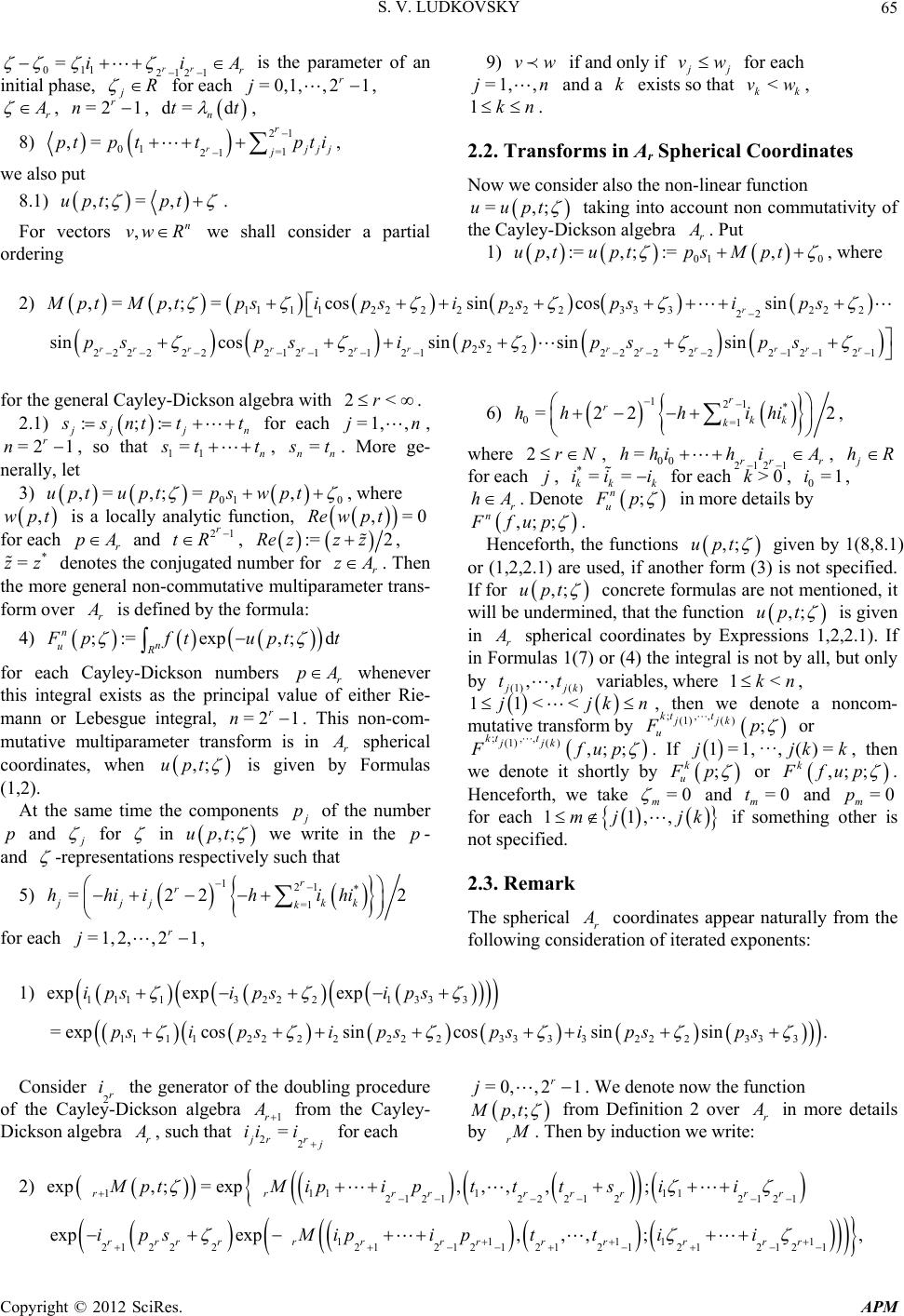 S. V. LUDKOVSKY Copyright © 2012 SciRes. APM 65 011 2121 =rr r iiA is the parameter of an initial phase, jR for each =0,1, ,21 r j, r , =2 1 r n, d= d n tt , 8) 21 01 =1 21 ,= r r jj j ptp ttpti , we also put 8.1) ,;=,upt pt . For vectors ,n vw R we shall consider a partial ordering 9) vw if and only if j vw for each =1,,jn and a k exists so that < kk vw, 1kn . 2.2. Transforms in Ar Spherical Coordinates Now we consider also the non-linear function =,;uupt taking into account non commutativity of the Cayley-Dickson algebra r . Put 1) 01 0 ,:=,; :=,uptuptps Mpt , where 2) 111122 2 222233322 2 22 ,=, ;=cossincossin r Mpt Mptpsipsipspsips 22 2 2222 222121 21 212222 222121 21 sincossin sinsin rrrrr rrrrrrr r pspsipspsps for the general Cayley-Dickson algebra with 2<r . 2.1) :;: jjn snt tt for each =1, ,jn, =2 1 r n, so that 11 =n tt, = nn t. More ge- nerally, let 3) 01 0 ,=,; =,uptuptps wpt , where ,wpt is a locally analytic function, ,=0Rewp t for each r pA and 21 r tR , := 2Re zzz, * =zz denotes the conjugated number for r zA. Then the more general non-commutative multiparameter trans- form over r is defined by the formula: 4) ;:=exp,; d nn uR pftuptt for each Cayley-Dickson numbers r pA whenever this integral exists as the principal value of either Rie- mann or Lebesgue integral, =2 1 r n. This non-com- mutative multiparameter transform is in r spherical coordinates, when ,;upt is given by Formulas (1,2). At the same time the components p of the number p and for in ,;upt we write in the p- and -representations respectively such that 5) 121 * =1 =22 2 r r jjj kk k hhiih ihi for each =1,2, ,21 r j, 6) 121 * 0=1 =22 2 r rkk k hhhihi , where 2rN , 002121 =rr r hhihi A , j hR for each j, *== kk k iii for each >0k, 0=1i, r hA . Denote ; n u Fp in more details by ,; ; n Ffup . Henceforth, the functions ,;upt given by 1(8,8.1) or (1,2,2.1) are used, if another form (3) is not specified. If for ,;upt concrete formulas are not mentioned, it will be undermined, that the function ,;upt is given in r spherical coordinates by Expressions 1,2,2.1). If in Formulas 1(7) or (4) the integral is not by all, but only by (1)( ) ,, jk tt variables, where 1<kn, 11<<jjkn , then we denote a noncom- mutative transform by ;,, (1)( ); kt t jjk u Fp or ;,, (1)( ),; ; kt t jjk Ffup . If 1=1,j···, ()=jk k, then we denote it shortly by ; k u Fp or ,; ; k Ffup . Henceforth, we take =0 m and =0 m t and =0 m p for each 11,,mjjk if something other is not specified. 2.3. Remark The spherical r coordinates appear naturally from the following consideration of iterated exponents: 1) 1111 3222 1333 exp expexpips ipsips 111122 2 2222333322 2333 = expcossincossinsin.psipsipspsi psps Consider 2r i the generator of the doubling procedure of the Cayley-Dickson algebra 1r from the Cayley- Dickson algebra r , such that 22 = jr r iii for each =0, ,21 r j . We denote now the function ,; pt from Definition 2 over r in more details by r . Then by induction we write: 2) 111111 212122 2122121 exp,;= exp,,,,; rrrrrrrrr MptM ipiptttsii 11111 21222 2121212121212121 expexp,, ,;, rrrrrr rrrr r rr ipsMipipt tii 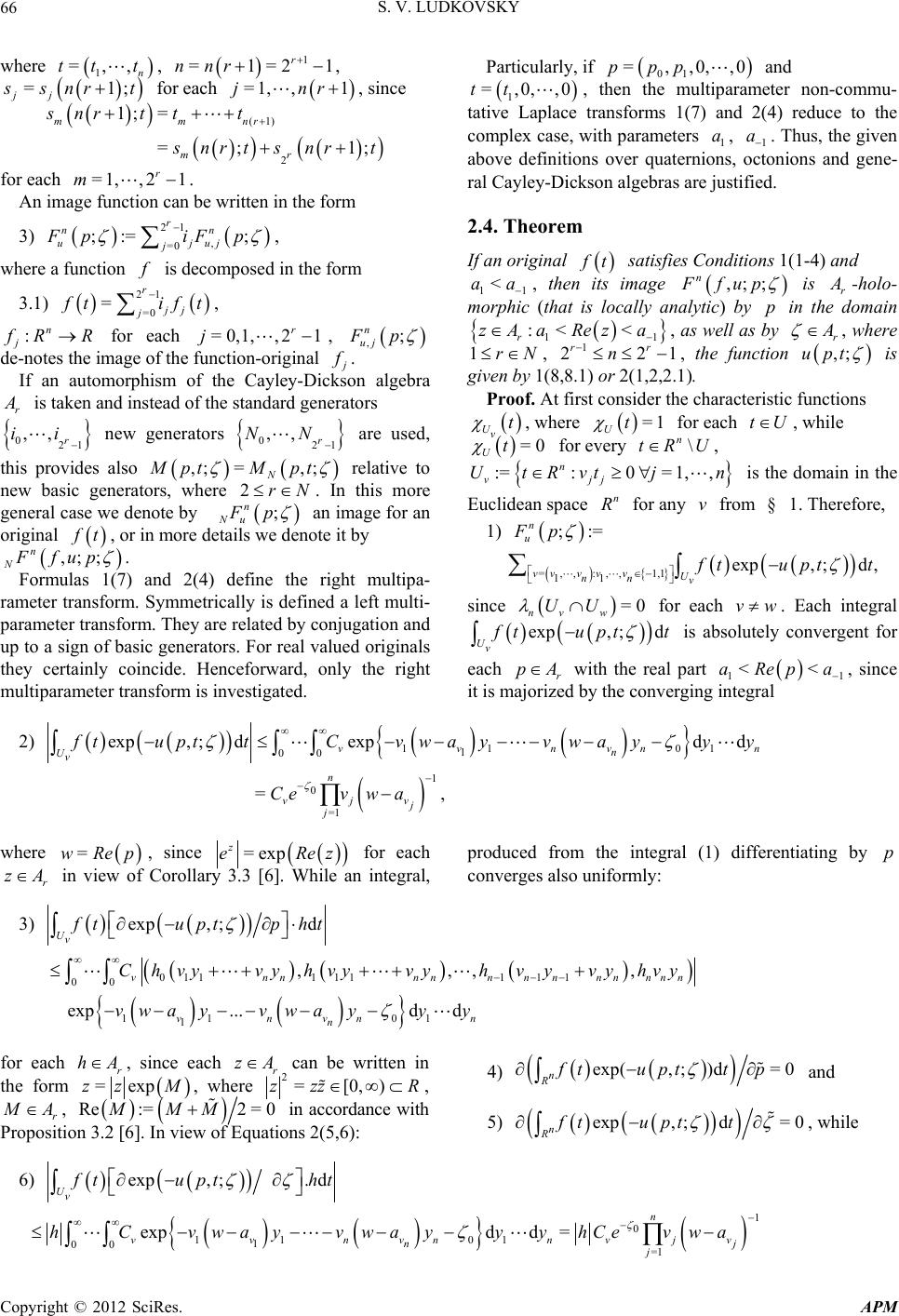 S. V. LUDKOVSKY Copyright © 2012 SciRes. APM 66 where 1 =,, n tt t, 1 =1=21 r nnr , =1; jj snr t for each =1, ,1jnr, since (1) 2 1;= =; 1; mmnr mr snrt tt nr tsnrt for each =1,,21 r m. An image function can be written in the form 3) 21 , =0 ;:= ; r nn ujuj j FpiF p , where a function is decomposed in the form 3.1) 21 =0 =r jj j tift , :n j RR for each =0,1,,21 r j, ,; n uj Fp de-notes the image of the function-original . If an automorphism of the Cayley-Dickson algebra r is taken and instead of the standard generators 021 ,, r ii new generators 021 ,, r NN are used, this provides also ,;=,; N ptM pt relative to new basic generators, where 2rN. In this more general case we denote by ; n Nu Fp an image for an original t, or in more details we denote it by ,; ; n NFfup . Formulas 1(7) and 2(4) define the right multipa- rameter transform. Symmetrically is defined a left multi- parameter transform. They are related by conjugation and up to a sign of basic generators. For real valued originals they certainly coincide. Henceforward, only the right multiparameter transform is investigated. Particularly, if 01 =,,0,,0ppp and 1 =,0,,0tt, then the multiparameter non-commu- tative Laplace transforms 1(7) and 2(4) reduce to the complex case, with parameters 1 a, 1 a. Thus, the given above definitions over quaternions, octonions and gene- ral Cayley-Dickson algebras are justified. 2.4. Theorem If an original t satisfies Conditions 1(1-4) and 11 <aa , then its image ,; ; n Ffup is r -holo- morphic (that is locally analytic) by p in the domain 11 :< < r zAa Reza , as well as by r , where 1rN , 1 221 rr n , the function ,;upt is given by 1(8,8.1) or 2(1,2,2.1). Proof. At first consider the characteristic functions Uvt , where =1 Ut for each tU, while =0 Ut for every \ n tRU, :=:0 =1,, n vjj UtRvt jn is the domain in the Euclidean space n R for any v from § 1. Therefore, 1) ;:= n u Fp =,,:,,1,1 11 exp,;d, vv vv vU nn vftupt t since =0 nv w UU for each vw. Each integral exp,;d Uvftupt t is absolutely convergent for each r pA with the real part 11 <<aRepa , since it is majorized by the converging integral 2) 11 01 1 00 exp,;dexpdd vvnvnn n UvftupttCvw ayvw ayyy 1 0 =1 =, n vjv j j Cevw a where =wRep , since =exp z eRez for each r zA in view of Corollary 3.3 [6]. While an integral, produced from the integral (1) differentiating by p converges also uniformly: 3) exp,;d Uvftuptp ht 01111111 1 00 11 01 1 ,,, , exp...dd vnnnnnnnnnnnn vnvn n n Chvy vyhvy vyhvyvyhvy vwa yvwayyy for each r hA, since each r zA can be written in the form =expzz M , where 2=[0,)zzz R , r A, Re:=2 = 0MMM in accordance with Proposition 3.2 [6]. In view of Equations 2(5,6): 4) exp(,;)d= 0 n Rftupttp and 5) exp,;d= 0 n Rftupt t , while 6) exp,;.d Uvft uptht 1 0 11 01 1 00 =1 expdd = n vvnvnnvjv nj j hCvwayvwayyyhCevwa 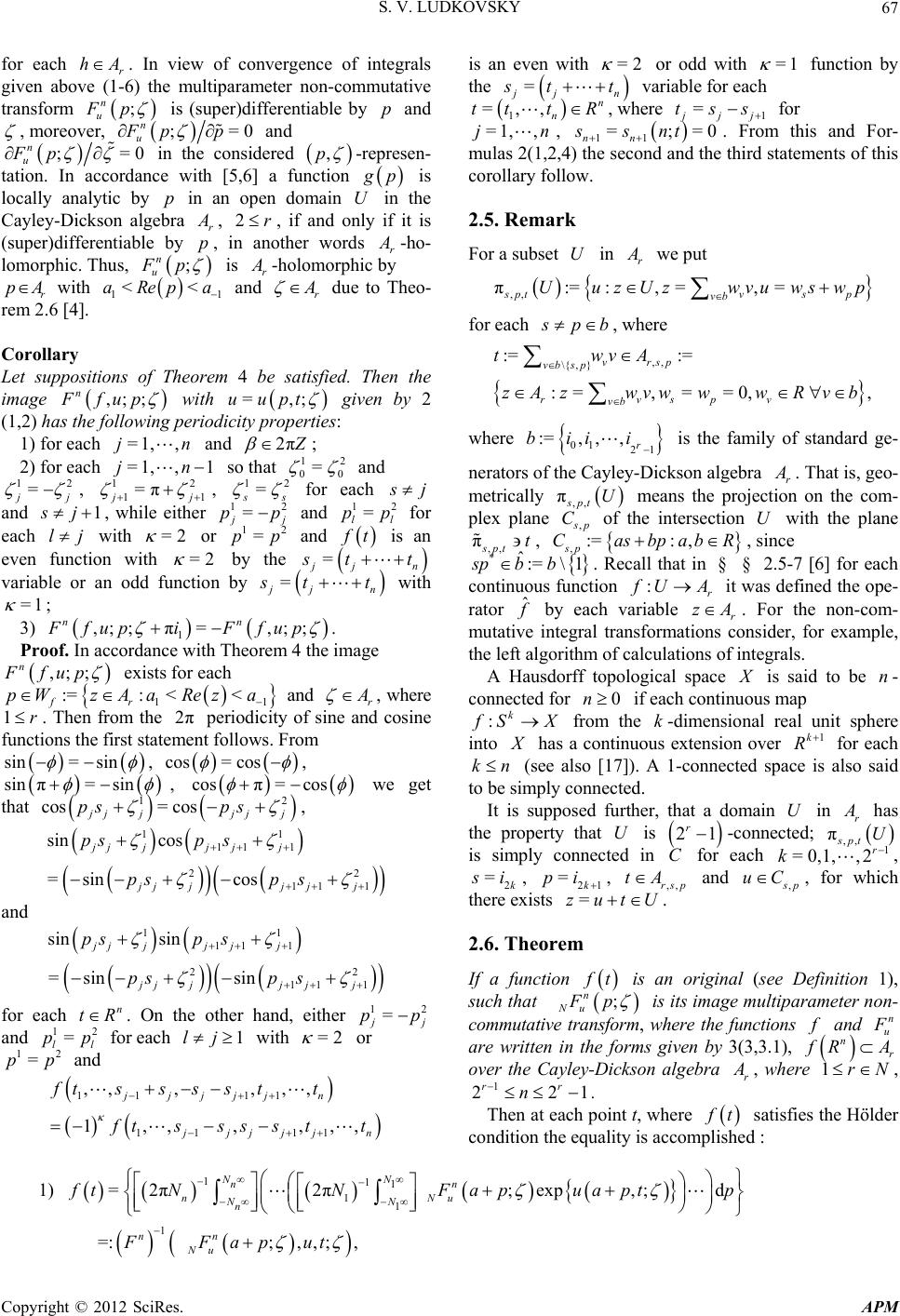 S. V. LUDKOVSKY Copyright © 2012 SciRes. APM 67 for each r hA. In view of convergence of integrals given above (1-6) the multiparameter non-commutative transform ; n u Fp is (super)differentiable by p and , moreover, ;=0 n u Fp p and ;=0 n u Fp in the considered ,p -represen- tation. In accordance with [5,6] a function p is locally analytic by p in an open domain U in the Cayley-Dickson algebra r , 2r, if and only if it is (super)differentiable by p, in another words r -ho- lomorphic. Thus, ; n u Fp is r -holomorphic by r pA with 11 <<aRepa and r due to Theo- rem 2.6 [4]. Corolla ry Let suppositions of Theorem 4 be satisfied. Then the image ,; ; n Ffup with =,;uupt given by 2 (1,2) has the following periodicity properties: 1) for each =1, ,jn and 2π ; 2) for each =1,,1jn so that 12 00 = and 12 = j , 12 11 =π j , 12 = s for each j and 1 j, while either 12 = j pp and 12 = ll pp for each lj with =2 or 12 =pp and t is an even function with =2 by the = jn tt variable or an odd function by = jn tt with =1 ; 3) 1 ,; ;π=,;; nn Ffupi Ffup . Proof. In accordance with Theorem 4 the image ,; ; n Ffup exists for each 11 :=: << fr pWz AaReza and r , where 1r. Then from the 2π periodicity of sine and cosine functions the first statement follows. From sin= sin , cos= cos , sin π=sin , cos π=cos we get that 12 cos= cos jj jjj ps ps , 11 11 1 22 11 1 sin cos =sincos jjjj jj jjjj jj psps psp s and 11 111 22 111 sin sin =sinsin jjjjjj jjjjjj psps psp s for each n tR. On the other hand, either 12 = j pp and 12 = ll pp for each 1lj with =2 or 12 =pp and 11 11 11 11 ,, ,, 1,, , ,,, ,, jjjj jjjj n jn ftsss s tt ftsss s tt is an even with =2 or odd with =1 function by the = jn tt variable for each 1 =,,n n ttt R, where 1 = jj tss for =1,,jn, 11 =;=0 nn ssnt . From this and For- mulas 2(1,2,4) the second and the third statements of this corollary follow. 2.5. Remark For a subset U in r we put ,, π:=:,=, = sptvs p vb UuzUzwvuwswp for each pb , where ,, \{ ,} := := :=, ==0,, vrsp vb sp rvspv vb twvA zAzwvwww Rvb where 01 21 :=,,, r bii i is the family of standard ge- nerators of the Cayley-Dickson algebra r . That is, geo- metrically ,, πspt U means the projection on the com- plex plane , p C of the intersection U with the plane ,, πspt t , ,:=: , sp CasbpabR, since *ˆ:=\ 1spb b. Recall that in § § 2.5-7 [6] for each continuous function :r UA it was defined the ope- rator ˆ by each variable r zA. For the non-com- mutative integral transformations consider, for example, the left algorithm of calculations of integrals. A Hausdorff topological space is said to be n- connected for 0n if each continuous map :k SX from the k-dimensional real unit sphere into has a continuous extension over 1k R for each kn (see also [17]). A 1-connected space is also said to be simply connected. It is supposed further, that a domain U in r has the property that U is 21 r-connected; ,, πspt U is simply connected in C for each 1 =0,1, ,2 r k , 2 =k i, 21 =k pi , ,,rsp tA and , p uC, for which there exists =zutU . 2.6. Theorem If a function t is an original (see Definition 1), such that ; n Nu Fp is its imag e multiparameter non- commutative transform, where the functions and n u are written in the forms given by 3(3,3.1), nr RA over the Cayley-Dickson algebra r , where 1rN , 1 221 rr n . Then at each point t, where t satisfies the Hölder condition the equality is accomplished : 1) 111 11 =2π2π;exp ,; d NN nn nNu NN n tNNFapuapt p 1 =:;,, ;, nn Nu FFaput 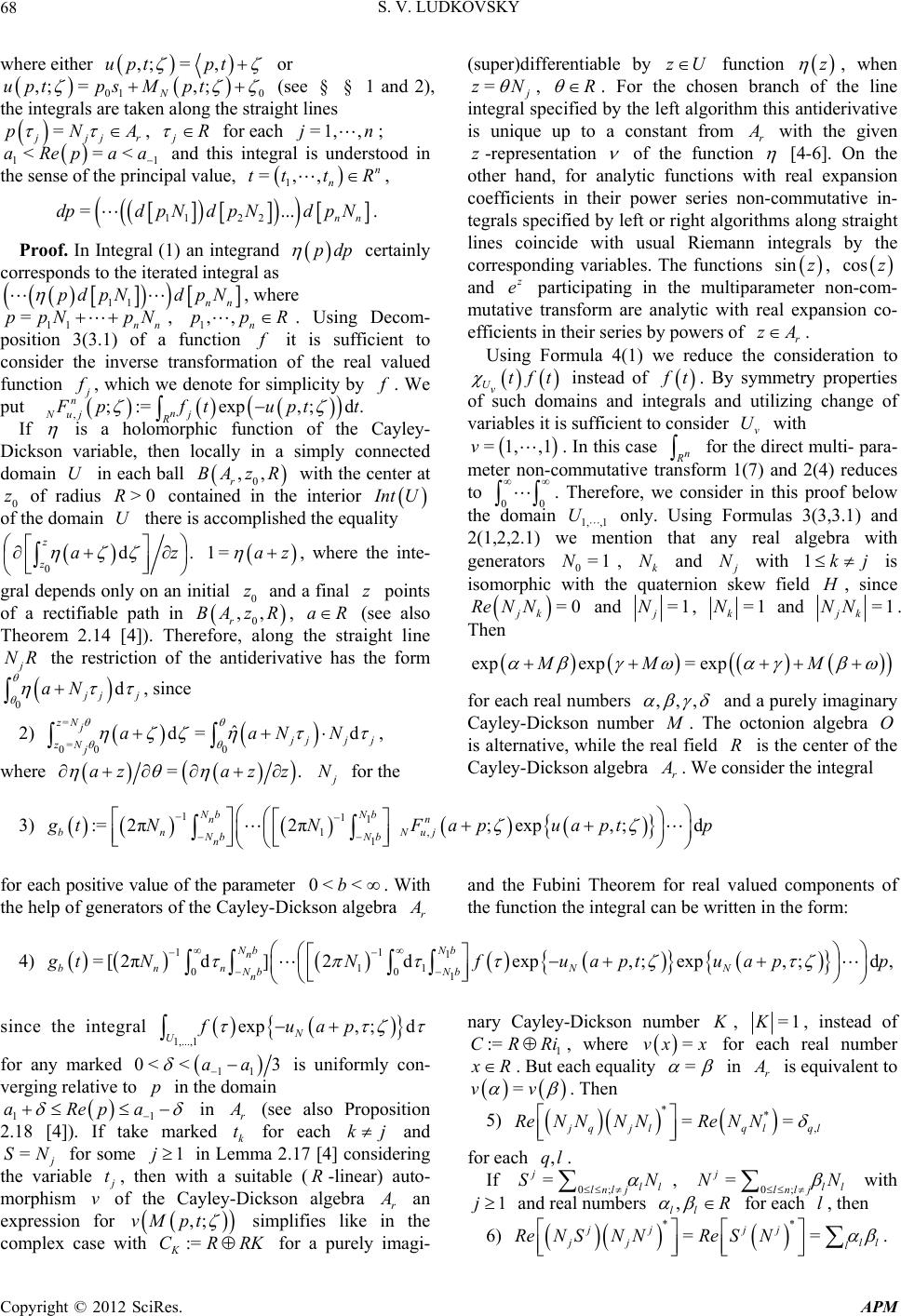 S. V. LUDKOVSKY Copyright © 2012 SciRes. APM 68 where either ,;= ,upt pt or 01 0 ,; =,; N uptps Mpt (see § § 1 and 2), the integrals are taken along the straight lines = jj r pNA , jR for each =1, ,jn; 11 <=<aRepaa and this integral is understood in the sense of the principal value, 1 =,,n n ttt R, 112 2 =... nn dpdp NdpNdpN. Proof. In Integral (1) an integrand pdp certainly corresponds to the iterated integral as 11 nn pdpN dpN , where 11 =nn ppN pN, 1,, n ppR. Using Decom- position 3(3.1) of a function it is sufficient to consider the inverse transformation of the real valued function , which we denote for simplicity by . We put ,;:=exp,; d. nn Nuj j R pftuptt If is a holomorphic function of the Cayley- Dickson variable, then locally in a simply connected domain U in each ball 0 ,, r BAz R with the center at 0 z of radius >0R contained in the interior nt U of the domain U there is accomplished the equality 0 d. z zaz 1= az , where the inte- gral depends only on an initial 0 z and a final z points of a rectifiable path in 0 ,, r BAz R, aR (see also Theorem 2.14 [4]). Therefore, along the straight line NR the restriction of the antiderivative has the form 0 d jj aN , since 2) = = 00 0 ˆ d= d zN j jjj zN jaaNN , where =.azaz z N for the (super)differentiable by zU function z , when = zN , R . For the chosen branch of the line integral specified by the left algorithm this antiderivative is unique up to a constant from r with the given z-representation of the function [4-6]. On the other hand, for analytic functions with real expansion coefficients in their power series non-commutative in- tegrals specified by left or right algorithms along straight lines coincide with usual Riemann integrals by the corresponding variables. The functions sin z, cos z and e participating in the multiparameter non-com- mutative transform are analytic with real expansion co- efficients in their series by powers of r zA. Using Formula 4(1) we reduce the consideration to Uvtft instead of t. By symmetry properties of such domains and integrals and utilizing change of variables it is sufficient to consider v U with =1, ,1v. In this case n for the direct multi- para- meter non-commutative transform 1(7) and 2(4) reduces to 00 . Therefore, we consider in this proof below the domain 1, ,1 U only. Using Formulas 3(3,3.1) and 2(1,2,2.1) we mention that any real algebra with generators 0=1N, k N and N with 1kj is isomorphic with the quaternion skew field , since =0 jk ReNN and =1 j N, =1 k N and =1 jk NN . Then expexp= expMM M for each real numbers ,,, and a purely imaginary Cayley-Dickson number . The octonion algebra O is alternative, while the real field R is the center of the Cayley-Dickson algebra r . We consider the integral 3) 111 1, 1 := 2π2π;exp ,; d Nb Nb nn bn Nuj Nb Nb n tNNFapuaptp for each positive value of the parameter 0< <b . With the help of generators of the Cayley-Dickson algebra r and the Fubini Theorem for real valued components of the function the integral can be written in the form: 4) 111 11 00 1 =[ 2πd]2dexp,;exp,; d, Nb Nb n bnnN N Nb Nb n t NNfuaptuapp since the integral 1,...,1 exp, ;d N Ufuap for any marked 11 0< <3aa is uniformly con- verging relative to p in the domain 11 aRepa in r (see also Proposition 2.18 [4]). If take marked k t for each kj and = SN for some 1j in Lemma 2.17 [4] considering the variable t, then with a suitable (R-linear) auto- morphism v of the Cayley-Dickson algebra r an expression for ,;vMpt simplifies like in the complex case with := K CRRK for a purely imagi- nary Cayley-Dickson number , =1K, instead of 1 :=CRRi , where =vx x for each real number R . But each equality = in r is equivalent to =vv . Then 5) ** , == qjlql ql ReNNNNReNN for each ,ql. If 0; = jll lnl j SN , 0; = jll lnl j NN with 1j and real numbers , llR for each l, then 6) ** == jj jj jll l ReN SN NReSN . 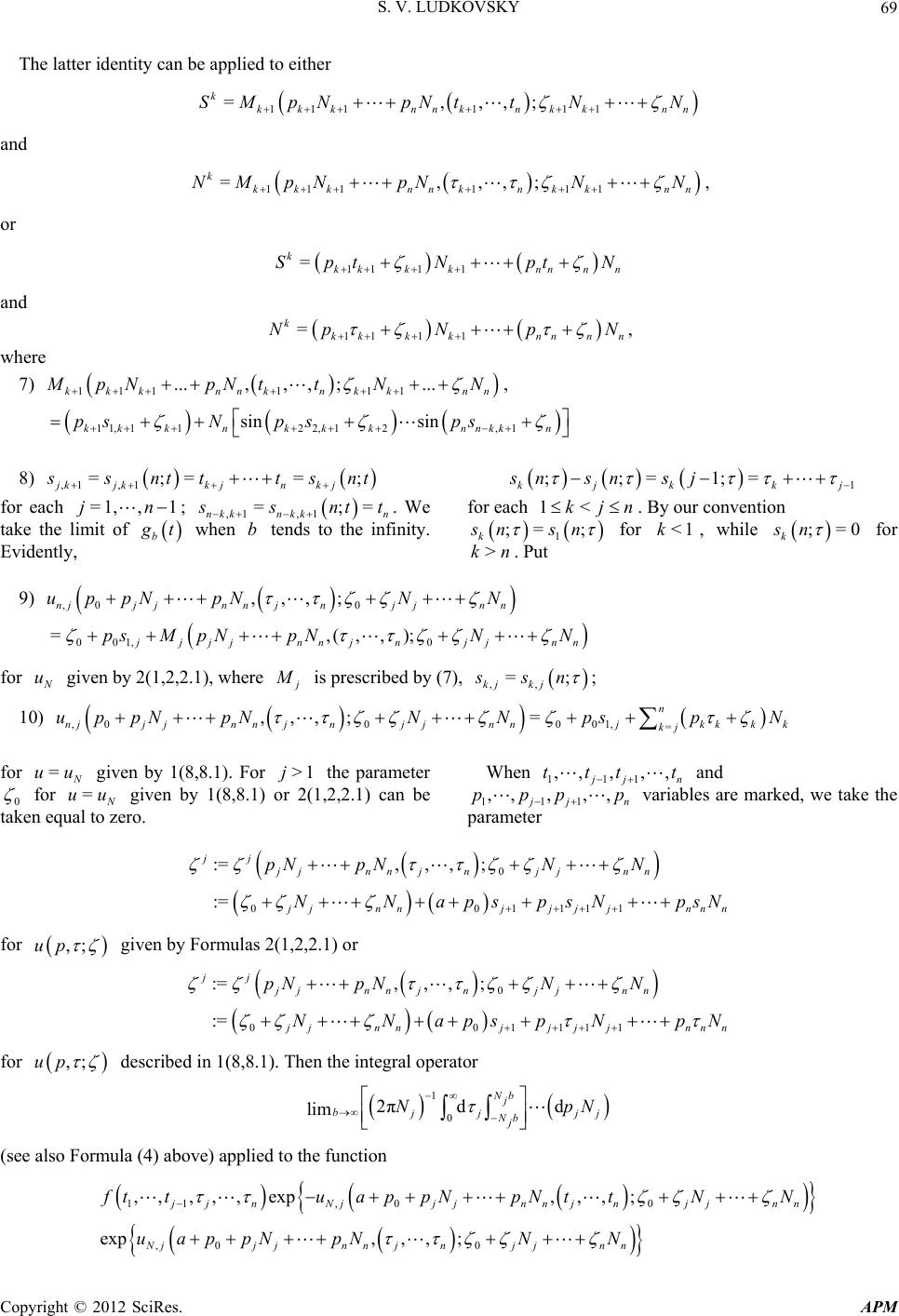 S. V. LUDKOVSKY Copyright © 2012 SciRes. APM 69 The latter identity can be applied to either 1111 11 =,,,; kkkknnk nkknn SMpNpNttNN and 111111 =,,,; kkkknnk nkknn NMpN pNNN , or 111 1 = kkkkknnn n SptNpt N and 111 1 = kkkkknnnn NpNp N , where 7) 1111 11 ...,, ,;... kkknnk nkknn pNpNttNN , 11,12 2,12,11 sin sin nkkk nnkk kkk n psN psps 8) ,1 ,1 =;==; jkjkkjnk j sntt tsnt for each =1,,1jn; ,1 ,1 =;= nkk nkkn sntt . We take the limit of b t when b tends to the infinity. Evidently, 1 ;;=1;= kjk kj snsns j for each 1<kjn . By our convention 1 ;=; k nsn for <1k, while ;=0 k sn for >kn. Put 9) ,0 0 ,,,; njj jnnjnj jnn uppNpNNN 001, 0 =,(,,); jjjnnj njjnn psM pNpNNN for u given by 2(1,2,2.1), where is prescribed by (7), ,, =; kj kj sn ; 10) ,00001, = ,,,;= n njjjnn jnjjnnjkkk k kj uppNpNNNpspN for = uu given by 1(8,8.1). For >1j the parameter 0 for = uu given by 1(8,8.1) or 2(1,2,2.1) can be taken equal to zero. When 111 ,, , ,, jn ttt t and 111 ,, , ,, jn pppp variables are marked, we take the parameter 0 001111 :=,, ,; := jj j jnnjnj jnn jnnjjjj nnn pN pNNN NNapspsNpsN for ,;up given by Formulas 2(1,2,2.1) or 0 001111 :=,, ,; := jj j jnnjnj jnn jnnjjjj nnn pN pNNN NNapspNpN for ,;up described in 1(8,8.1). Then the integral operator 1 0 2πdd lim Nb j b jjj Nb j NpN (see also Formula (4) above) applied to the function 11, 00 ,0 0 ,,,,,exp, ,,; exp,,,; jjnNjjjnnjnjjnn Njjjnn jnjjnn fttua ppNpNttNN uappN pNNN  S. V. LUDKOVSKY Copyright © 2012 SciRes. APM 70 with the parameter instead of treated by Theo- rems 2.19 and 3.15 [4] gives the inversion formula cor- responding to the real variable t for t and to the Cayley-Dickson variable 00 j pN pN restricted on the complex plane = j j CRRN , since = j dcd for each (real) constant c. After inte- grations with =1, ,jk with the help of Formulas (6- 10) and 3(1,2) we get the following: 11) 11 1 11 00 1 =2πd2πd lim NN nk bnn kk NN bnk gt ReNN 11,10111011 ,101 11011 ,,,,,exp,,,; exp...,,,;...d. kknNkk knnknkknn Nkkknn knkknn fttua pp NpNttNN uappNpNNNp Moreover, = qq Reff for each q and in (11) the function =q f stands for some marked q in accor- dance with Decompositions 3(3,3.1) and the beginning of this proof. Mention, that the algebra ,, jkl algN N N over the real field with three generators N, k N and l N is alternative. The product kl NN of two generators is also the corresponding generator (,) 1kl m N with the de- finite number =,mmkl and the sign multiplier (,) 1kl , where ,0,1kl . On the other hand, 1212 = kjjklkkl NNNNNNNN . We use decom- positions (7-10) and take 2=kl due to Formula (11), where Re stands on the right side of the equality, since =0 kl ReN N and =0 jjkl ReNNNN for each kl . Thus the repeated application of this procedure by =1,2, ,jn leads to Formula (1) of this theorem. Corolla ry If the conditions of Theorem 6 are satisfied, then 1) 1 1 =2π;exp,;dd=;,,;. nnnn nunNu R ftFa pua ptppFF a put Proof. Each algebra ,, jkl algN N N is alternative. Therefore, in accordance with § 6 and Formulas 1(8,8.1) and 2(1-4) for each non-commutative integral given by the left algorithm we get 2) 1exp, ;exp,;d Nb j NNjj Nb j Nfuaptuap pN 21 =0 exp, ;exp,;d =exp,;exp ,;d rNb j jj llNNj Nb j l b NNj b NNNfuaptuapp fuaptuap p for each =1, ,jn, since the real field is the center of the Cayley-Dickson algebra r , while the functions sin and cos are analytic with real expansion coeffi- cients. Thus 3) 1 1 00 =2πddexp,;exp,;dd bb n bnNN n bb tfuaptuapp p hence taking the limit with b tending to the infinity im- plies, that the non-commutative iterated (multiple) inte- gral in Formula 6(1) reduces to the principal value of the usual integral by real variables 1,, n and 1,, n pp 6.1(1). 2.7. Theorem An original t with nr RA over the Cayley- Dickson algebra r with 1rN is completely de- fined by its image ; n Nu Fp up to values at points of discontinuity, where the function ,;upt is given by 1(8,8.1) or 2(1,2,2.1). Proof. Due to Corollary 6.1 the value t at each point t of continuity of t has the expression throughout ; n Nu Fp prescribed by Formula 6.1(1). Moreover, values of the original at points of discontinuity do not influence on the image ; n Nu Fp , since on each bounded interval in R by each variable t a number of points of discontinuity is finite and by our supposition above the original function t is n — 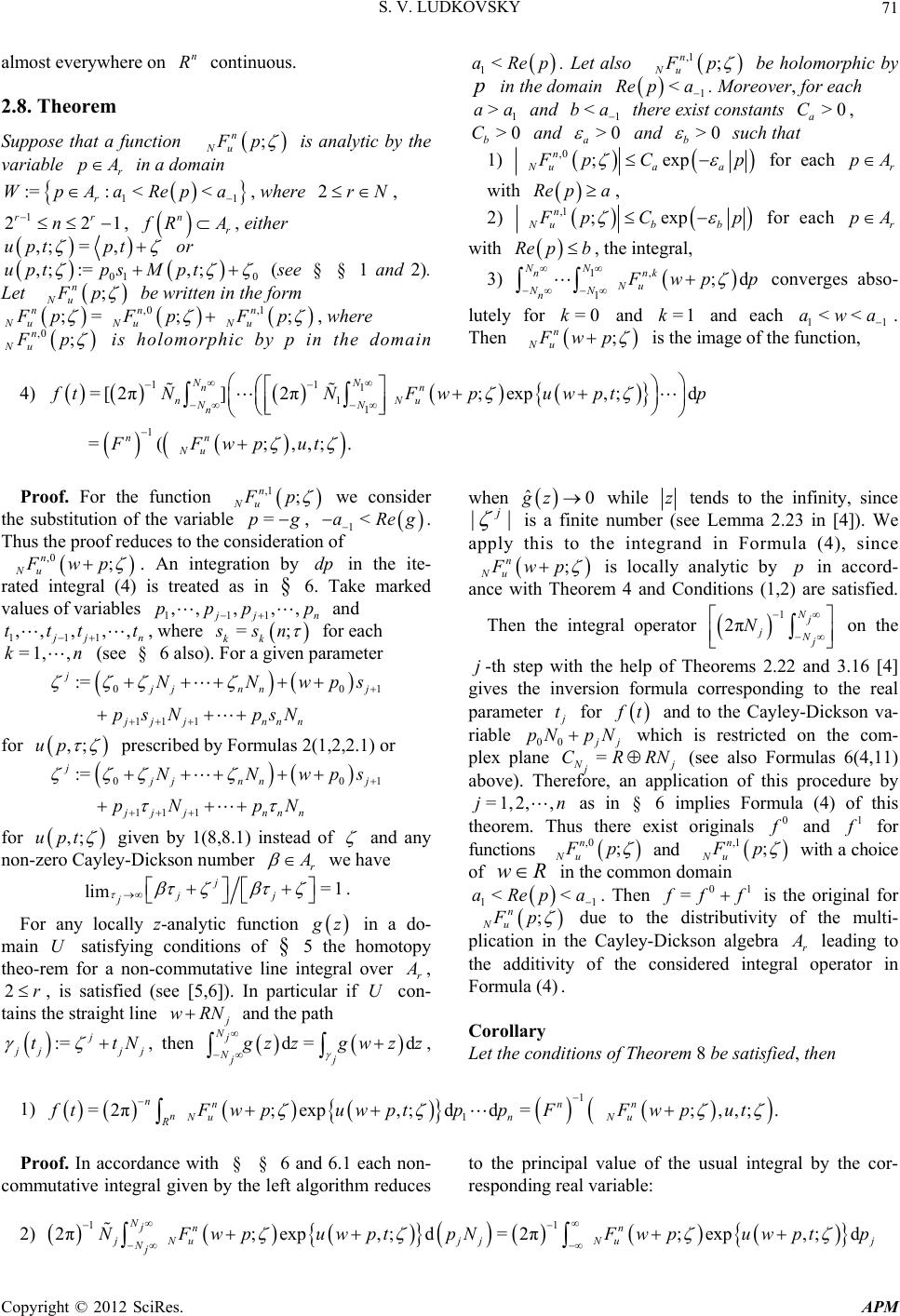 S. V. LUDKOVSKY Copyright © 2012 SciRes. APM 71 almost everywhere on n R continuous. 2.8. Theorem Suppose that a function ; n Nu Fp is analytic by the variable r pA in a domain 11 :=: << r WpAaRepa , where 2rN , 1 221 rr n , nr RA, either ,;= ,upt pt or 01 0 ,; :=,;uptps Mpt (see § § 1 and 2). Let ; n Nu Fp be written in the form ,0 ,1 ;= ;; nn n Nu NuNu FpFpF p , where ,0 ; n Nu Fp is holomorphic by p in the domain 1<aRep. Let also ,1 ; n Nu Fp be holomorphic by in the domain 1 <Re pa. Moreover, for each 1 >aa and 1 <ba there exist constants >0 a C, >0 b C and >0 a and >0 b such that 1) ,0 ;exp n Nua a pCp for each r pA with Re pa, 2) ,1 ;exp n Nub b pCp for each r pA with Re pb , the integral, 3) 1, 1 ;d NN nnk Nu NN n wp p converges abso- lutely for =0k and =1k and each 11 <<awa . Then ; n Nu Fwp is the image of the function, 4) 11 1 11 =[ 2π]2π;exp,;d NN nn nNu NN n tN NFwpuwptp 1 =( ;,,;. nn Nu FFwput Proof. For the function ,1 ; n Nu Fp we consider the substitution of the variable =pg, 1<aReg . Thus the proof reduces to the consideration of ,0 ; n Nu Fwp . An integration by dp in the ite- rated integral (4) is treated as in § 6. Take marked values of variables 111 ,, , ,, jn ppp p and 111 ,, , ,, jn ttt t , where =; kk sn for each =1, ,kn (see § 6 also). For a given parameter 001 11 1 := j jnn j jj jnnn NNwps psN psN for ,;up prescribed by Formulas 2(1,2,2.1) or 001 11 1 := j jnn j jj jnnn NNwps pN pN for ,;upt given by 1(8,8.1) instead of and any non-zero Cayley-Dickson number r we have =1 lim j jj j . For any locally z-analytic function z in a do- main U satisfying conditions of § 5 the homotopy theo-rem for a non-commutative line integral over r , 2r, is satisfied (see [5,6]). In particular if U con- tains the straight line wRN and the path := j jjj ttN , then d= d Nj Njj zz gwzz , when ˆ0gz while z tends to the infinity, since ||j is a finite number (see Lemma 2.23 in [4]). We apply this to the integrand in Formula (4), since ; n Nu Fwp is locally analytic by p in accord- ance with Theorem 4 and Conditions (1,2) are satisfied. Then the integral operator 1 2πNj jNj N on the j-th step with the help of Theorems 2.22 and 3.16 [4] gives the inversion formula corresponding to the real parameter t for t and to the Cayley-Dickson va- riable 00 j pN pN which is restricted on the com- plex plane = j j CRRN (see also Formulas 6(4,11) above). Therefore, an application of this procedure by =1,2, ,jn as in § 6 implies Formula (4) of this theorem. Thus there exist originals 0 and 1 for functions ,0 ; n Nu Fp and ,1 ; n Nu Fp with a choice of Rw in the common domain 11 <<aRepa . Then 01 = ff is the original for ; n Nu Fp due to the distributivity of the multi- plication in the Cayley-Dickson algebra r leading to the additivity of the considered integral operator in Formula (4) . Corolla ry Let the conditions of Theorem 8 be satisfied, the n 1) 1 1 =2π;exp,;dd=;,,;. nnnn nNun Nu R ftFw puw ptppFFw put Proof. In accordance with § § 6 and 6.1 each non- commutative integral given by the left algorithm reduces to the principal value of the usual integral by the cor- responding real variable: 2) 1 1 2π;exp,;d=2π;exp,;d Njn n Nuj jNuj Nj NFwp uwptpNFwp uwptp  S. V. LUDKOVSKY Copyright © 2012 SciRes. APM 72 for each =1, ,jn. Thus Formula 8(4) with the non- commutative iterated (multiple) integral reduces to For- mula 8.1(1) with the principal value of the usual integral by real variables 1,, n pp. 2.9. Note In Theorem 8 Conditions (1,2) can be replaced on 1) () ˆ=0, sup limnpC Rn Fp where ()1 1 :=:=, << Rn r CzAzRnaReza is a sequence of intersections of spheres with a domain W, where <1Rn Rn for each n, = limnRn . Indeed, this condition leads to the accomplishment of the r analog of the Jordan Lemma for each 2r (see also Lemma 2.23 and Remark 2.24 [4]). Subsequent properties of quaternion, octonion and general r multiparameter non-commutative analogs of the Laplace transform are considered below. We denote by: 2) 11 =: << fr WpAafRepaf a domain of ; n Nu Fp by the p variable, where 11 =aaf and 11 =aaf are as in § 1. For an original 3) 1, ,1 U ft t we put 1 =: <, fr WpAafRep that is 1=a . Cases may be, when either the left hy- perplane 1 =Repa or the right hyperplane 1 =Re pa is (or both are) included in W. It may also happen that a domain reduces to the hyperplane 11 =: == f WpRepaa . 2.10. Proposition If images ; n Nu Fp and ; n Nu Gp of functions originals t and t exist in domains W and W with values in r , where the function ,;upt is given by 1(8,8.1) or 2(1,2,2.1), then for each ,r in the case 2= H; as well as f and with values in R and each ,r or f and with values in r and each ,R in the case of r with 3r; the function ;; NuN u Fp Gp is the image of the func- tion tgt in a domain g WW. Proof. Since the transforms ; n Nu Fp and ; n Nu Gp exist, then the integral exp,;d=exp,;dexp, ;d nnn RRR tgtu pttftu pttgtu ptt converges in the domain 1111 =: max,<<min, fg r WWpAafag Repafag . We have n tR, 1 221 rr n , while R is the center of the Cayley-Dickson algebra r . The qua- ternion skew field is associative. Thus, under the imposed conditions the constants , can be carried out outside integrals. 2.11. Theorem Let =>0const , let also ; n Fp be an image of an original function t with either =,upt or u given by Formulas 2(1,2) over the Cayley-Dickson algebra r with 2<r, 1 221 rr n . Then an image ; nn Fp of the function t exists. Proof. Since == jj jjjjjj psp sps for each =1,,jn, where = j s , =; jj snt, =; jj sn , = j t for each =1,,jn. Then changing of these variables implies: ,; (,/ ;) d= d =; uptupn nn RR nn ftetf e Fp due to the fact that the real filed R is the center Z(Ar) of the Cayley-Dickson algebra r . 2.12. Theorem Let t be a function-original on the domain 1, ,1 U such that k tt also for =1kj and =kj satisfies Conditions 1(1-4). Suppose that ,;upt is given by 2(1,2,2.1) or 1(8,8.1) over the Cayley-Dickson algebra r with 2<r , 1 221 rr n . Then 1) 1; 1,11,,1 ,; ;=,,;; ; j nntjj jU U FftttupFfttupt p , 01, ,1 =1 ,; ; jn ke U k k ppSFfttup in the r spherical coordinates or  S. V. LUDKOVSKY Copyright © 2012 SciRes. APM 73 1.1) 1; 1, ,11,,1 ,; ;=,,;; ; j nntjj jU U FftttupFfttupt p 01, ,1,; ; n je U j ppSFfttup in the r Cartesian coordinates in a domain 11 =: max,< rj WpAafaft Rep , where 1 :=,,,,: =0 jjnj ttttt , = ek k S for each 1k. Proof. Certainly, 2) 11 = tssft t and 2.1) =1 =1 == nj kkj k kk ft tftssstftss for each =2,,jn, since 1 = jj tss , 112 =tss , where =; jj snt, =0 nl s for each 1l. From Formulas 30(6,7) [4] we have the equality in the r spherical coordinates: 3) 01, exp,;= exp,;exp,; jj je j uptspuptpSupt , since 01 0 exp,;=expexp, ;uptps Mpt , 01001,010 exp=exp jj pss pps , cossin= exp =exp= expπ2 =cos π2sinπ2=cossin, jj jjj jjjjjjjj jjjj jjjjjjj jjjjjj jjjejjjjj jj j psps isps is pipsippsi ppspsi pSpspsi since and k are real independent variables for each kj , where ,=0 jk for jk , while ,=1 jj , 3.1) cossin= cossin ejjj jjjjjjj jjjjj j Spsps ipsps i =cos π2sin π2 jjjjj j psps i In the r Cartesian coordinates we take t instead of in (3.1). If z is a differentiable function by z for each j, :rr A , = jjj zpt , then 3.2) = exp=d expd. jj zqtq zzp 1 1 =1 =1= =! =exp=exp, knk n jj nk jjjqe j qpzz zzn qpzpSz where either =1q or =1q, since =1 jj z . That is 3.3) exp= 0 x ekkk j Si for each 1jk and any positive number >0x, 3.4) exp= expπ2 x ejjjjjj j Sii x and exp= expπ2 xejjjjjj j Sii x for each non-negative real number 0x, k and kR , where = eej jj SS , the zero power 0= ej SI is the unit operator; 3.5) (,;) 01 0 0,1111,11111 =cos1sincos ps upt q qejjjjj jj j See Tipsipsps 22 11 111111 1 212121 21 = sin cossin sin r kkkkr rrr kj ipspsi psps 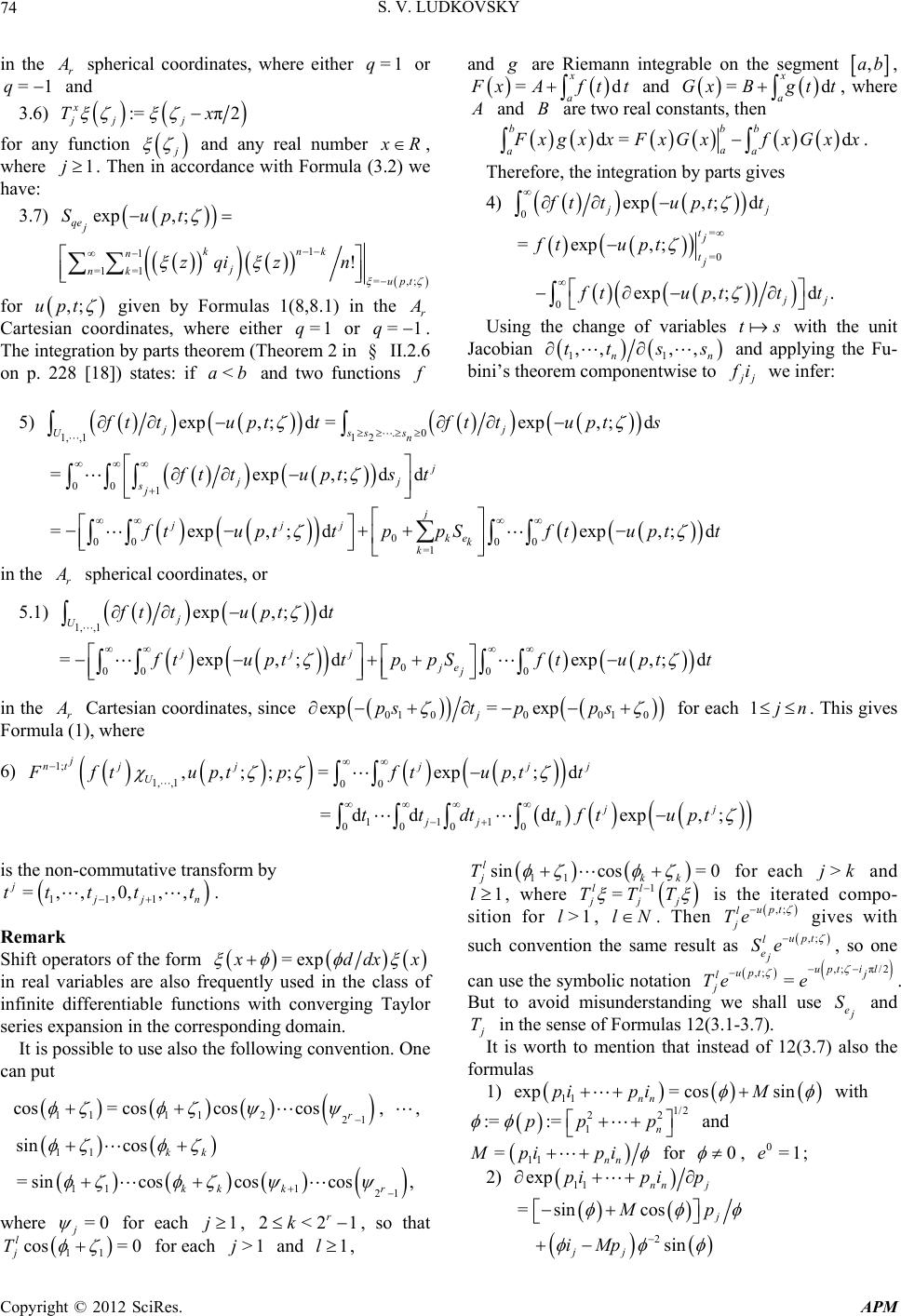 S. V. LUDKOVSKY Copyright © 2012 SciRes. APM 74 in the r spherical coordinates, where either =1q or =1q and 3.6) := π2 x jj j Tx for any function and any real number R , where 1j. Then in accordance with Formula (3.2) we have: 3.7) exp,; qej Supt 1 1 =1 =1=,; ! knk n j nk upt zqi zn for ,;upt given by Formulas 1(8,8.1) in the r Cartesian coordinates, where either =1q or =1q . The integration by parts theorem (Theorem 2 in § II.2.6 on p. 228 [18]) states: if <ab and two functions f and are Riemann integrable on the segment ,ab , =d x a xA ftt and =d x a GxBgt t, where and B are two real constants, then d= d bb b a aa xgx xFxGxfxGx x . Therefore, the integration by parts gives 4) 0exp, ;d j ttupt t = =0 0 =exp ,; exp,;d. tj tj j ft upt tupttt Using the change of variables ts with the unit Jacobian 11 ,, ,, nn tt ss and applying the Fu- bini’s theorem componentwise to j i we infer: 5) .0 1, ,112 exp,;d=exp,;d jj Usss n tt upttftt upts 00 1 0 00 00 =1 =exp,;dd =exp,;d exp,;d j jj sj j jjj ke k k ft tuptst tupttppS ftuptt in the r spherical coordinates, or 5.1) 1, ,1 exp, ;d j U ttupt t 0 00 00 =exp,;dexp,;d jjj je j tupttppS ftuptt in the r Cartesian coordinates, since 01 0001 0 exp= exp j pstpps for each 1jn. This gives Formula (1), where 6) 1; 1, ,100 ,,;;;=exp ,;d j nt jjjjj U ftupt pftuptt 111 0000 =d ddexp,; jj jj n ttdttft upt is the non-commutative transform by 111 =,,,0, ,, j jn ttt tt . Remark Shift operators of the form =exp ddxx in real variables are also frequently used in the class of infinite differentiable functions with converging Taylor series expansion in the corresponding domain. It is possible to use also the following convention. One can put 1111221 cos=coscoscosr , , 11 111 21 sin cos = sincoscoscos, kk kk kr where =0 j for each 1j, 2<21 r k, so that 11 cos=0 l j T for each >1j and 1l, 11 sincos=0 l jkk T for each >jk and 1l, where 1 = ll jjj TTT is the iterated compo- sition for >1l, lN . Then ,;upt l j Te gives with such convention the same result as ,;upt l ej Se , so one can use the symbolic notation ,; π/2 ,; =upti l uptj l j Te e . But to avoid misunderstanding we shall use e S and T in the sense of Formulas 12(3.1-3.7). It is worth to mention that instead of 12(3.7) also the formulas 1) 11 exp= cossin nn pi piM with 1/2 22 1 := :=n pp p and 11 =nn Mpi pi for 0 , 0=1e; 2) 11 exp nn j pipi p 2 =sincos sin j jj Mp iMp  S. V. LUDKOVSKY Copyright © 2012 SciRes. APM 75 and =1 jj jj pt can be used. 2.13. Theorem Let t be a function-original. Suppose that ,;upt is given by 2(1,2,2.1) or 1(8,8.1) over the Cayley-Dickson algebra r with 2<r. Then a (super) derivative of an image is given by the following formula: 1) 10 11 1 ,; ;=,; ;,; ;,; ; nnn n eenn n ftupphFftsuph SF ftsuphSF ftsuph in the r spherical coordinates, or 1.1) 10 11 1 ,; ;.=,; ;,; ;,; ; nn nn eenn n f tupphFf tsuphSFf ttuphS Ff ttuph in the r Cartesian coordinates for each 00 =nnr hhihi A, where 0,, n hhR, 1 221 rr n , pW. Proof. The inequalities 11 <<afRepa f are equivalent to the inequalities 11 <<a fttRepaftt , since || exp= 0 lim tbtt for each >0b. An image ,; ; n Fftup is a holomorphic function by p for 11 <<afRepa f by Theorem 4, also 0d< ct n ett for each >0c and =0,1,2,n. Thus it is possible to differentiate under the sign of the integral: 2) {1,1} exp,;=(exp, ;d) nUv RU v n v tuptdtphftupttph =exp,;d. n R tuptpht Due to Formulas 12(3,3.2) we get: 3) 10 11 1 exp,;=exp,;exp, ;exp, ; eenn n u ptphu ptshSu ptshSu ptsh in the r spherical coordinates, or 4) 10 11 1 exp,;=exp,;exp, ;exp,; eenn n u ptphu ptshSu ptthSu ptth in the r Cartesian coordinates. Thus from Formulas (2,3) we deduce Formula (1). 2.14. Theorem If t is a function-original, then 1) ,; ;=,; ;, nn Fft upFftupp for either i) 010 ,; =,;uptps Mpt or ii) ,;= ,upt pt over r with 2<r in a domain pW , where n R , 1 221 rr n , 2) 01 111 ,= nnn ppspsi psi with =; jj sn for each j in the first (i) and ,= ,pp in the second (ii) case (see also Formulas 1(8), 2(1,2,2.1)). Proof. For p in the domain 1 >Repa the iden- tities are satisfied: 3) (,;) 1,...,1 1 ,; ;=d nupt Un ftupftet ,;, 1, ,1 1,...,1 =d=,;;,, up pnU UfteFft upp due to Formulas 1(7,8) and 2(1,2,2.1,4), since 01001001 ;=; ;ps ntps nps n and = jj jjjjj pt pp and ;= ;; jjjjjj jj psntps npsn for each =1, ,21 r j, where =t . Symmetrically we get (2) for v U instead of 1, ,1 U. Naturally, that the mul- tiparameter non-commutative Laplace integral for an original can be considered as the sum of 2n in- tegrals by the sub-domains v U: 4) exp, ;d n R tuptt {1,1} =exp,;d. nUv R n v tupttt The summation by all possible 1,1 n v gives Formula (1).  S. V. LUDKOVSKY Copyright © 2012 SciRes. APM 76 2.15. Note In view of the definition of the non-commutative trans- form n and ,;upt and Theorem 14 the term 11 2121 rr ii has the natural interpretation as the initial phase of a retardation. 2.16. Theorem If t is a function-original with values in r for 2<r , 1 221 rr n , bR, then 1) 1.,; ;=,;; n bt t nn F eftupFftupb for each 11 >>abRepab , where u is given by 1(8,8.1) or 2(1,2). Proof. In accordance with Expressions 1(8,8.1) and 2(1,2,2.1) one has 1 ,;=,; . n uptbttup bt If 11 >>abRepab , then the integral 2) 11 ... ... ,; ;=exp,;d nn bt tbt t nUvUv efttup fteuptt =exp ,;d=,;; nUv Uvftupbtt Ffttupb converges. Applying Decomposition 14(4) we deduce Formula (1). 2.17. Theorem Let a function t be a real valued original, ;= ;;; n FpFftup , where the function ,;upt is given by 1(8,8.1) or 2(1,2,2.1). Let also ;Gp and qp be locally analytic functions such that 1) ,;;;=;exp,; n FgtupGpuqp for =,upt or 01 0 =,; n uptt Mpt , then 2) ,d;;; nn R Fgtf up =; ;Gp Fqp for each pW and qp W, where 2<r , 1 221 rr n . Proof. If pW and qp W, then in view of the Fubini’s theorem and the theorem conditions a change of an integration order gives the equalities: ,dexp,;d =,exp,;dd =;exp,;d =; exp(,;d =; ;, nn RR nn RR n R n R tfupt t gtupttf Gpuqp f Gp fuqp Gp Fqp since ,n tR and the center of the algebra r is R. 2.18. Theorem If a function 1, ,1 U ft is original together with its derivative 1 1,. ,1 nUn ttss or 1 1,. ,1 nUn tttt , where ; n u Fp is an image function of 1, ,1 U ft over the Cayley-Dickson algebra r with 2rN , 1 221 rr n , for 010 =,;upsMpt given by 2(1,2,2.1), then 1) 1 012 12 =0 ;1 lim nm n eeneu n pm ppSpS pSFp 10,0; () 01, 11 2 12 1<<; 1<<; , 11 ;=10, nu nm l jjejeje u jjnmj nm jjnllnlj nm m ppSpSpSFp fe or 1.1) 1 01 020 12 =0 ;1 lim nm n ee neu n pm ppS ppSppSFp 000 12 12 1<<; 1<<; , 11 10,0; ; =1 0 l nm jej ejeu jjnmj nm jjnllnlj nm m nu ppSppSppSF p fe for ,;upt given by 1(8,8.1), where ;0 1, ,1 0= limtU t ft , p tends to the infinity inside the angle <π2Arg p for some 0< <π2 , 121 r j , =0, =n l j jjl ppi , 1 =,, m lll. If the restriction 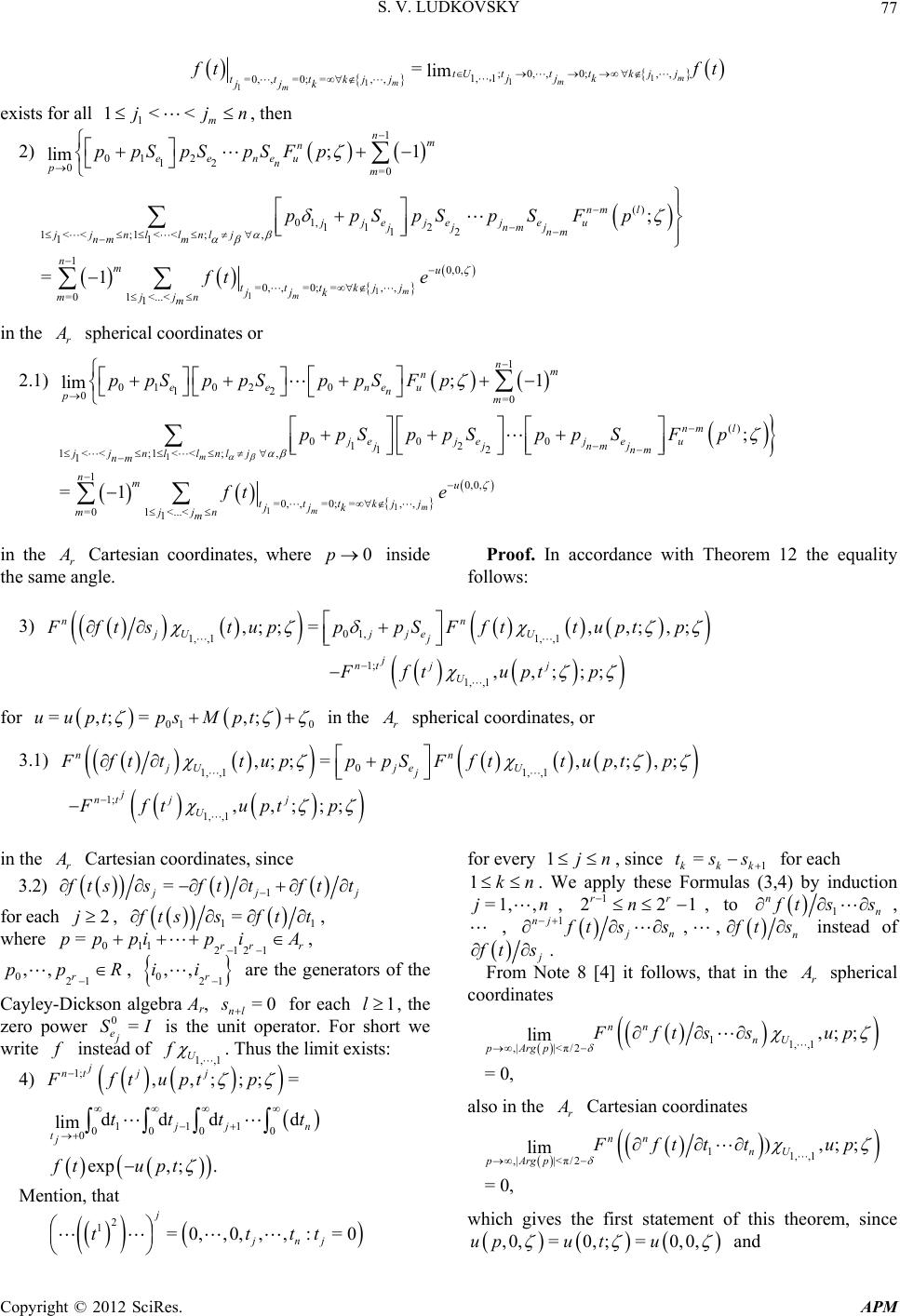 S. V. LUDKOVSKY Copyright © 2012 SciRes. APM 77 1 1 1 1 ;0,,0; ,, 1, 1 =0, ,=0;=, ,=lim m m m mtUtttkjj jjk tttkjj jjk tft , exists for all 1 1<< m jjn, then 2) 1 012 12 0=0 ;1 lim nm n eeneu n pm ppSpSpSFp 1 1 () 01, 11 2 12 1<<; 1<<; , 11 10,0, =0, ,=0;=, , =01 <...< 1 ; =1 m m nm l jjejeje u jjnmj nm jjnllnlj nm m nmu tttkjj jjk mjjn m ppSpSpSFp ft e in the r spherical coordinates or 2.1) 1 01 020 12 0=0 ;1 lim nm n ee neu n pm ppS ppSppSFp 1 1 1 () 000 12 12 1<<; 1<<; , 1 10,0, =0, ,=0;=,, =01 <...< 1 ; =1 m m m nml jej ejeu jjnmj nm jjnllnlj nm nmu tttkjj jjk mjjn m ppSppSppSF p ft e in the r Cartesian coordinates, where 0p inside the same angle. Proof. In accordance with Theorem 12 the equality follows: 3) 01, 1, ,11, ,1 ,; ;=,,;,; n n jUjjeU j FftstupppSFfttuptp 1; 1,,1 ,,;;; j nt jj U Fftuptp for 01 0 =,;= ,;uupt psMpt in the r spherical coordinates, or 3.1) 0 1, ,11, ,1 ,; ;=,,;, ; n n jUje U j Fftttup ppSFfttuptp 1; 1,,1 ,,;;; j nt jj U Fft uptp in the r Cartesian coordinates, since 3.2) 1 = jj tssft tft t for each 2j, 11 = tssft t, where 011 2121 =rr r pp pipiA , 021 ,,r ppR , 021 ,, r ii are the generators of the Cayley-Dickson algebra Ar, =0 nl s for each 1l, the zero power 0= ej SI is the unit operator. For short we write instead of 1, ,1 U f . Thus the limit exists: 4) 1; ,,;;;= j nt jj Fftuptp 111 0000 0 ddd d lim exp,;. jn tj tttt ft upt Mention, that 2 1=0,,0,,,:=0 j jnj tttt for every 1jn , since 1 = kkk tss for each 1kn . We apply these Formulas (3,4) by induction =1,,jn, 1 221 rr n , to 1 nn ts s, , 1nj n tss ,, n ts instead of ts . From Note 8 [4] it follows, that in the r spherical coordinates 11,,1 ,| |<π/2 ,; ; lim =0, nn nU pArgpFftssup also in the r Cartesian coordinates 11,,1 ,| |<π/2 ),;; lim =0, nn nU pArgpFfttt up which gives the first statement of this theorem, since ,0,=0,;= 0,0,upu tu and 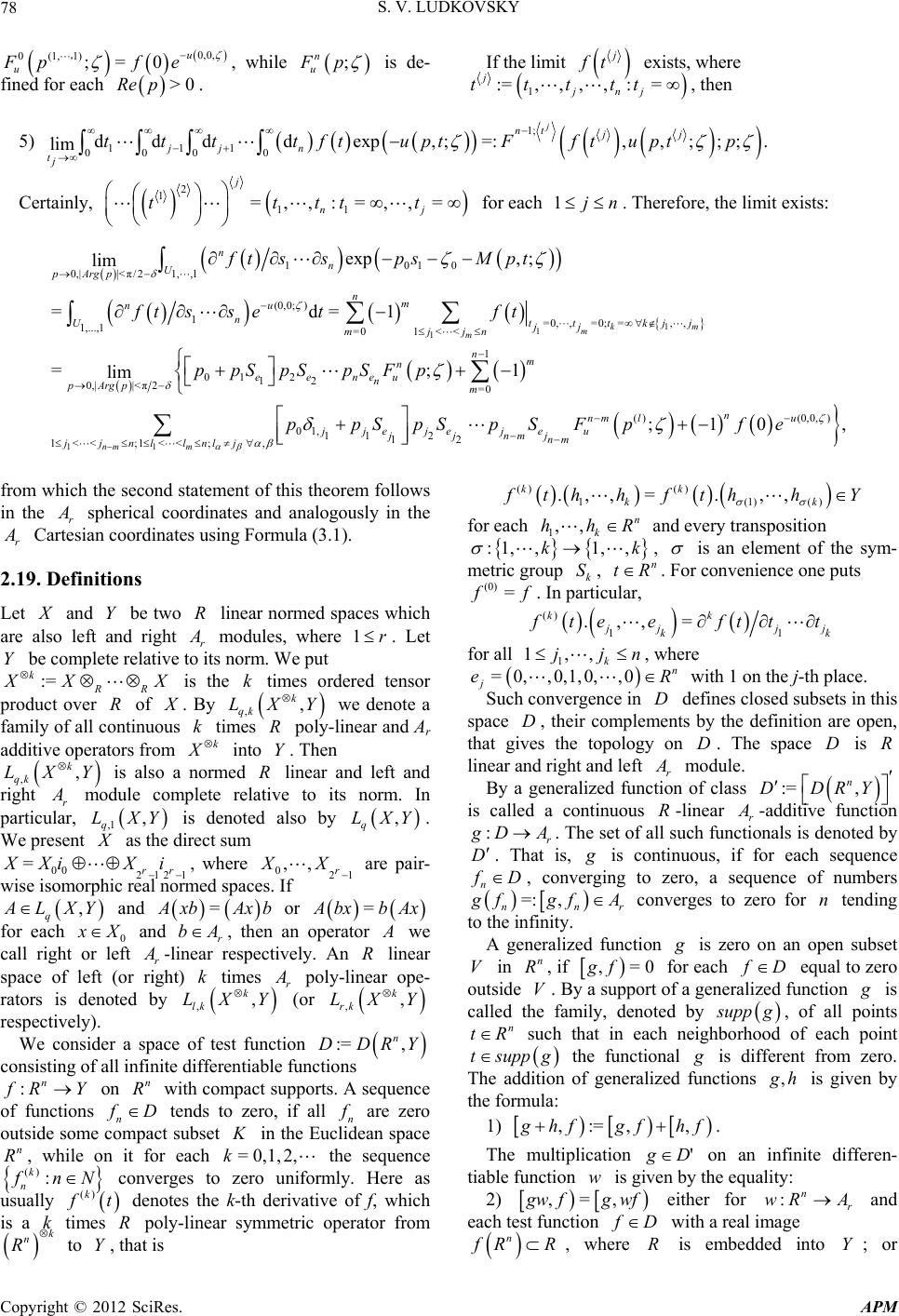 S. V. LUDKOVSKY Copyright © 2012 SciRes. APM 78 0,0, 0(1,1) ;=0u u Fpf e ,, while ; n u Fp is de- fined for each >0Rep. If the limit t exists, where 1 :=,,,,: = jjnj ttttt , then 5) 1; 111 000 0 ddddexp ,;=:,,;;;. lim j nt jj jjn tj ttttftuptFftuptp Certainly, 2 1 11 = ,,:=,,= j nj ttttt for each 1jn . Therefore, the limit exists: 1 1 1 1010 0,||< π/21,,1 (0,0; ) 1=0,,=0;= ,, 1,...,1 =01< < 1 012 12 0,| |<π2=0 exp,; lim =d=1 =;1 lim km m m nn U pArgp nm nu ntttkjj Ujj mjjn nm n eeneu n pArgp m ft sspsMpt ftss etft ppSpS pSFp 11 ()(0,0, ) 01, 11 2 12 1<<; 1<<; , ;10 , nm m n nm lu jjejeje u jjnmj nm jjnllnlj ppSpSpSFp fe from which the second statement of this theorem follows in the r spherical coordinates and analogously in the r Cartesian coordinates using Formula (3.1). 2.19. Definitions Let and Y be two R linear normed spaces which are also left and right r modules, where 1r . Let Y be complete relative to its norm. We put := kRR XX is the k times ordered tensor product over R of . By ,, k qk LXY we denote a family of all continuous k times R poly-linear and Ar additive operators from k into Y. Then ,, k qk LXY is also a normed R linear and left and right r module complete relative to its norm. In particular, ,1 , q LXY is denoted also by , q LXY. We present as the direct sum 00 2121 =rr XiX i , where 021 ,, r XX are pair- wise isomorphic real normed spaces. If , q LXY and = xbAxb or = bxb Ax for each 0 X and r bA, then an operator we call right or left r -linear respectively. An R linear space of left (or right) k times r poly-linear ope- rators is denoted by ,, k lk LXY (or ,, k rk LXY respectively). We consider a space of test function := , n DDRY consisting of all infinite differentiable functions :n RY on n R with compact supports. A sequence of functions n D tends to zero, if all n are zero outside some compact subset in the Euclidean space n R, while on it for each =0,1,2,k the sequence () : k n nN converges to zero uniformly. Here as usually ()k t denotes the k-th derivative of f, which is a k times R poly-linear symmetric operator from k n R to Y, that is () () 1(1)() .,, =.,, kk kk thhfthhY for each 1,, n k hhR and every transposition :1, ,1, ,kk , is an element of the sym- metric group k S, n tR. For convenience one puts (0) = f. In particular, () 11 .,, = kk jjj kk teeft tt for all 1 1,, k jjn , where = 0,,0,1,0,,0n j eR with 1 on the j-th place. Such convergence in D defines closed subsets in this space D, their complements by the definition are open, that gives the topology on D. The space D is R linear and right and left r module. By a generalized function of class := , n DDRY is called a continuous R-linear r -additive function :r DA. The set of all such functionals is denoted by D . That is, is continuous, if for each sequence n D , converging to zero, a sequence of numbers =: , nnr fgfA converges to zero for n tending to the infinity. A generalized function is zero on an open subset V in n R, if ,=0gf for each D equal to zero outside V. By a support of a generalized function is called the family, denoted by upp g, of all points n tR such that in each neighborhood of each point tsupp g the functional is different from zero. The addition of generalized functions , h is given by the formula: 1) ,:=, , hfgf hf. The multiplication ' D on an infinite differen- tiable function w is given by the equality: 2) ,=, wfgwf either for :nr wR A and each test function D with a real image n RR, where R is embedded into Y; or  S. V. LUDKOVSKY Copyright © 2012 SciRes. APM 79 :n wR R and :n RY. A generalized function prescribed by the equa- tion: 3) ,:= , fgf is called a derivative of a generalized function , where ,, nn q DRLR Y , ,, nn q gDRLRY . Another space := , n BBRY of test functions con- sists of all infinite differentiable functions :n RY such that the limit () || =0 lim mj ttf t exists for each =0,1,2,m, =0,1,2,j. A sequence n B is called converging to zero, if the sequence () mj n tf t converges to zero uniformly on \,0, nn RBR R for each ,=0,1, 2,mj and each 0< <R , where ,,:=: ,BZzRy ZyzR denotes a ball with center at z of radius R in a metric space with a metric . The family of all R-linear and r -additive functionals on B is denoted by B. In particular we can take =r A , =r YA with 1, . Analogously spaces ,DUY , ,DUY , ,BUY and ,BUY are defined for domains U in n R, for example, =v UU (see also § 1). A generalized function ' B we call a generalized original, if there exist real numbers 11 <aa such that for each 111 1 <,,,, < nn awwwwa the generalized function 4) exp , vU v ft qt is in , v BUY for all 1 =,, n vv v, 1,1 j v for every =1, ,jn for each n tR with 0 jj tv for each =1,,jn, where 11 1 =,, vvnvn n qvwvw. By an image of such original we call a function. 5) ,; ;:=,exp,; n Ffupf upt of the vari- able r pA with the parameter r , defined in the domain 11 =: << fr WpAaRepa by the fol- lowing rule. For a given pW choose 111 1 <,,<<,,< nn awwRepww a , then 6) ,exp, ;:=fupt exp,, exp,;, vvU vv fqt uptqt since exp,;,, vv uptqt BUY , where in each term exp,,exp,;, vvU v fqt uptqt the generalized function belongs to , v BU Y by Con- dition (4), while the sum in (6) is by all admissible vectors 1,1 n v . 2.20. Note and Examples Evidently the transform ,; ; n Ffup does not depend on a choice of 11 ,,,, nn ww ww , since exp(,, exp,;, =exp, ,,exp,;, , vvU v vv vvU v fqt uptqt fqtbt uptqtbt for each n bR such that 11 <<< < jjj j awbRepw ba for each =1,,jn, because exp , v bt R. At the same time the real field R is the center of the Cayley- Dickson algebra r , where 2rN. Let be the Dirac delta function, defined by the equation DF ,:=0tt for each B . Then 1) () () {1,1} ,; ;=[exp,,exp,;,) nj j nvvU vv Ftuptqt uptqt = =1 exp,; jj tt upt , since it is possible to take 11 <<0<<aa and =0 k w for each 1,1,2, 2,,,knn , where n R is the parameter, || 11 11 := j jj ttt . In parti- cular, for =0j we have 2) ,; ;=exp,; n Ftup up . In the general case: 3) 11 12 || 111 10120 1 1 2 01 ,; ;=exp,0; kj j kj n j jjk nj n neene n FtssupppSpSp jS kMp in the r spherical coordinates, or 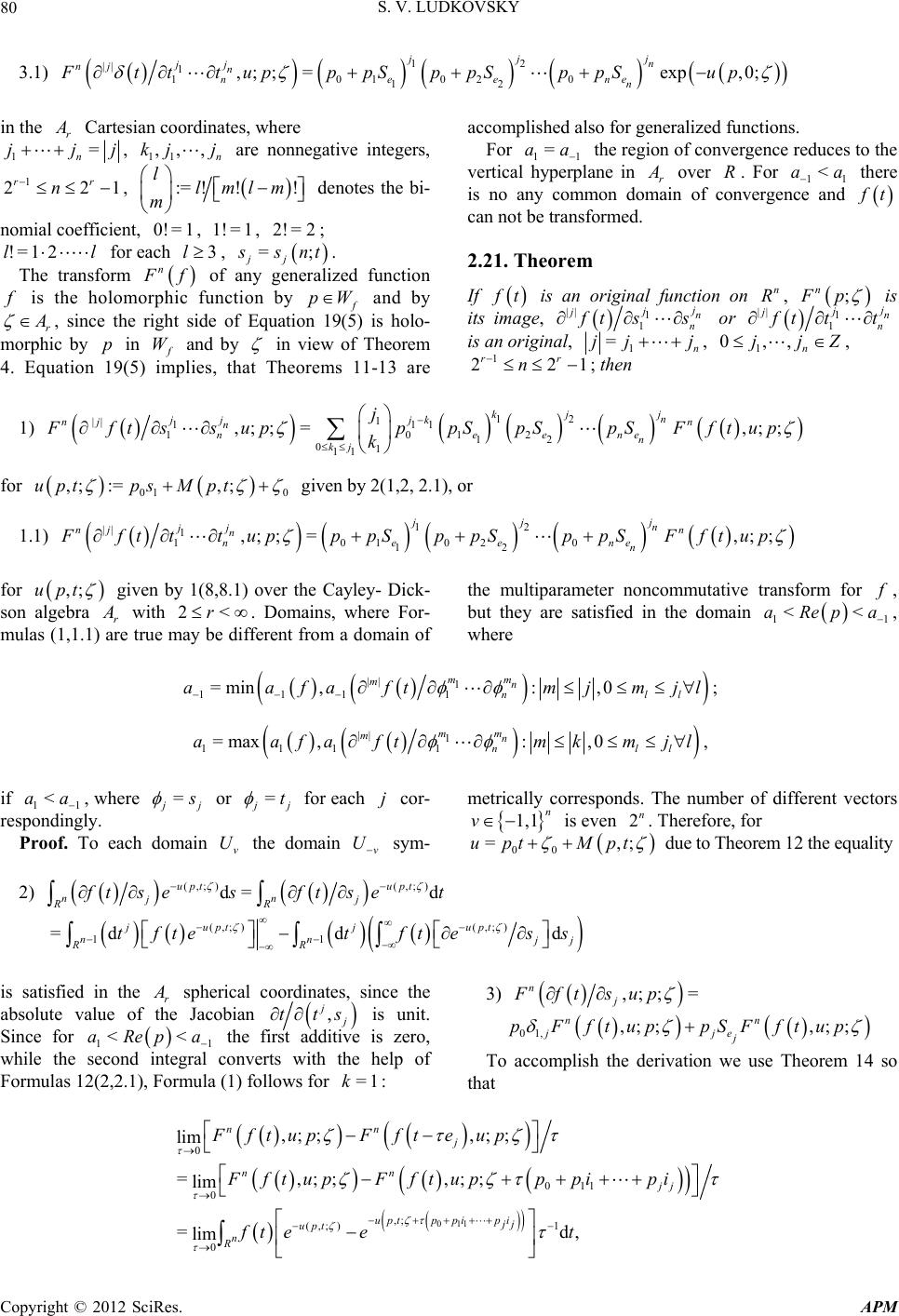 S. V. LUDKOVSKY Copyright © 2012 SciRes. APM 80 3.1) 12 || 1 101020 12 ,; ;=exp,0; j jj n j j nj n neene n Ftt tupppSppSppSup in the r Cartesian coordinates, where 1= n jjj, 11 ,,, n kj j are nonnegative integers, 1 221 rr n , := !!! llmlm m denotes the bi- nomial coefficient, 0! =1 , 1! = 1 , 2!=2; !=1 2ll for each 3l, =; jj snt. The transform n f of any generalized function is the holomorphic function by pW and by r , since the right side of Equation 19(5) is holo- morphic by p in W and by in view of Theorem 4. Equation 19(5) implies, that Theorems 11-13 are accomplished also for generalized functions. For 11 =aa the region of convergence reduces to the vertical hyperplane in r over R. For 11 <aa there is no any common domain of convergence and t can not be transformed. 2.21. Theorem If t is an original function on n R, ; n Fp is its image, || 1 1 j jn n ts s or || 1 1 j jn n tt t is an original, 1 =n jj j , 1 0,, n jjZ, 1 221 rr n ; then 1) 12 1 || 111 1012 12 01 11 ,; ;=,; ; j kj n j jjk nj n n neene n kj j FftssupppSpS pSFftup k for 010 ,; :=,;uptpsMpt given by 2(1,2, 2.1), or 1.1) 12 || 1 101020 12 ,; ;=,; ; j jj n j j nj n n neene n Fftttup ppSppSppSFftup for ,;upt given by 1(8,8.1) over the Cayley- Dick- son algebra r with 2<r. Domains, where For- mulas (1,1.1) are true may be different from a domain of the multiparameter noncommutative transform for , but they are satisfied in the domain 11 <<aRepa , where || 1 111 1 =min,: ,0 m m mn nll aafaft mjmjl ; || 1 111 1 =max,:,0 m m mn nll aafaftmkmjl , if 11 <aa , where = j or = j t for each j cor- respondingly. Proof. To each domain v U the domain v U sym- metrically corresponds. The number of different vectors 1,1 n v is even 2n. Therefore, for 00 =,;upt Mpt due to Theorem 12 the equality 2) (,;) (,;) d= d upt upt nn jj RR tse sftset (,;) (,;) 11 =dd d ju ptju pt nn j RR tftet ftess is satisfied in the r spherical coordinates, since the absolute value of the Jacobian , j tts is unit. Since for 11 <<aRepa the first additive is zero, while the second integral converts with the help of Formulas 12(2,2.1), Formula (1) follows for =1k: 3) ,; ;= nj Fftsup 01, ,; ;,;; nn jje j pFftup pSFftup To accomplish the derivation we use Theorem 14 so that 011 0 011 0 ,; (,;) 1 0 ,; ;,; ; lim =,;;,;; lim =d, lim nn j nn jj uptp pipi jj upt n R Fftup Ffteup FftupFftupppipi ft eet 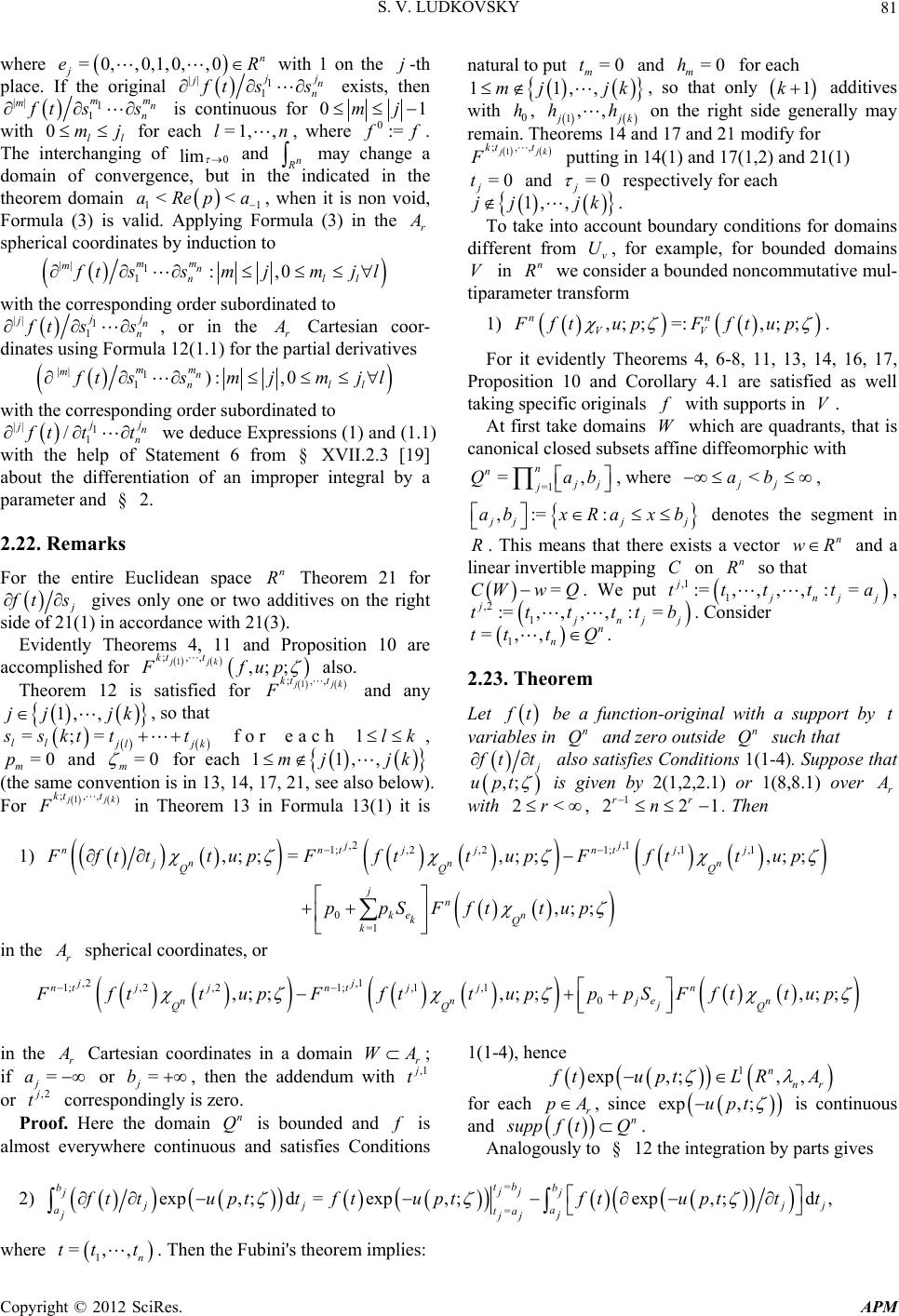 S. V. LUDKOVSKY Copyright © 2012 SciRes. APM 81 where = 0,,0,1,0,,0n j eR with 1 on the j-th place. If the original || 1 1 j jn n ts s exists, then || 1 1 m m mn n ts s is continuous for 01mj with 0ll mj for each =1, ,ln, where 0:= f. The interchanging of 0 lim and n may change a domain of convergence, but in the indicated in the theorem domain 11 <<aRepa , when it is non void, Formula (3) is valid. Applying Formula (3) in the r spherical coordinates by induction to || 1 1:,0 m m mn nll tss mjmjl with the corresponding order subordinated to || 1 1 j jn n ts s, or in the r Cartesian coor- dinates using Formula 12(1.1) for the partial derivatives || 1 1):,0 m m mn nll tss mjmjl with the corresponding order subordinated to || 1 1 / j jn n tt t we deduce Expressions (1) and (1.1) with the help of Statement 6 from § XVII.2.3 [19] about the differentiation of an improper integral by a parameter and § 2. 2.22. Remarks For the entire Euclidean space n R Theorem 21 for ts gives only one or two additives on the right side of 21(1) in accordance with 21(3). Evidently Theorems 4, 11 and Proposition 10 are accomplished for 1 ;,, ,; ; jjk ktt Ffup also. Theorem 12 is satisfied for 1 ;,, jk kt t and any 1, ,jjjk, so that =;= ll ljk skt tt for each 1lk , =0 m p and =0 m for each 11,,mjjk (the same convention is in 13, 14, 17, 21, see also below). For 1 ;,, jk kt t in Theorem 13 in Formula 13(1) it is natural to put =0 m t and =0 m h for each 11,,mjjk , so that only 1k additives with 0 h, 1,, jk hh on the right side generally may remain. Theorems 14 and 17 and 21 modify for 1 ;,, jjk kt t putting in 14(1) and 17(1,2) and 21(1) =0 j t and =0 j respectively for each 1, ,jjjk. To take into account boundary conditions for domains different from v U, for example, for bounded domains V in n R we consider a bounded noncommutative mul- tiparameter transform 1) ,; ;=:,; ; nn VV FftupFftup . For it evidently Theorems 4, 6-8, 11, 13, 14, 16, 17, Proposition 10 and Corollary 4.1 are satisfied as well taking specific originals with supports in V. At first take domains W which are quadrants, that is canonical closed subsets affine diffeomorphic with =1 =, n n j j Qab , where < jj ab , ,:=: jjj abx Raxb denotes the segment in R. This means that there exists a vector n wR and a linear invertible mapping C on n R so that =CWw Q. We put ,1 1 :=,,,,: = j nj j ttttta , ,2 1 :=,,,,: = j nj j tttttb . Consider 1 =,,n n ttt Q. 2.23. Theorem Let t be a function-original with a support by t variables in n Q and zero outside n Q such that tt also satisfies Conditions 1 (1-4). Suppose that ,;upt is given by 2(1,2,2.1) or 1(8,8.1) over r with 2<r , 1 221 rr n . Then 1) ,2 ,1 1;,2,21;,1 ,1 ,; ;=,; ;,; ; jj nntjjntjj jn nn QQ Q FftttupFfttup Ffttup 0 =1 ,; ; jn ke n kQ k ppSFfttup in the r spherical coordinates, or ,2 ,1 1;,2,21;,1 ,1 0 ,; ;,; ;,; ; jj ntjjntjjn nnjen j QQ Q Ff ttupFf ttupppSFfttup in the r Cartesian coordinates in a domain r WA; if = j a or = j b, then the addendum with ,1 t or ,2 t correspondingly is zero. Proof. Here the domain n Q is bounded and is almost everywhere continuous and satisfies Conditions 1(1-4), hence 1 exp,;,, nnr tuptLRA for each r pA , since exp,;upt is continuous and n upp f tQ. Analogously to § 12 the integration by parts gives 2) = = exp,;d=exp, ;exp, ;d, tb b b jj j j jjj a a ta j j jj t tupttftuptftupttt where 1 =,, n tt t. Then the Fubini's theorem implies:  S. V. LUDKOVSKY Copyright © 2012 SciRes. APM 82 3) 111 111 exp, ;d=exp,;dd bbbbb jjnj njjj Qaaaaa jjnj tt upttftt upttt ,2,2,1 ,1 , =, = 1 01 =1 =exp,;d][exp,;d exp,;d jjj jj nn tQ tbtQ ta jj jj jbb n ke kaa n k tu pttf tu ptt ppSft uptt in the r spherical coordinates or 3.1) exp,;d nj Q ttupt t ,2,2,1 ,1 , =, = 1 01 =exp,;d exp,;d exp,;d jjjjj nn tQ tbtQ ta jj jj bb n je jaa n tu pttf tu ptt ppSftupt t in the r Cartesian coordinates, where as usually 111 =,,,0, ,, j jn ttt tt , 111 d=dd dd jjj tttt t . This gives Formulas (1,1.1), where 4) , 1; ,,, ,,;;; jk n tjkjkjk n Q Fft tuptp 111,,, 111 =exp,;d bbbb jjn kjkjk aaaa jjn tuptt is the non-commutative transform by , k t, 1 221 rr n , , d k t is the Lebesgue volume element on 1n R. 2.24. Theorem If a function n Q tt is original together with its derivative 1 nnn Q ttss or 1 nnn Q tttt , where ; n u Fp is an image function of n Q tt over the Cayley-Dickson algebra r with 2rN , 1 221 rr n , for the function ,;upt given by 2(1,2,2.1) or 1(8,8.1), =1 =0, n n j Qb , >0 j b for each j, then 1) 1 01 2 12 =0 ;1 lim nm n eeneu n pm ppSpS pSFp 1 1 ()(0,0;) 01, 11 2 12 1<<; 1<<; , 1 ;=1 0 nmm n nm lu jjejeje u jjnmj nm jjnllnlj ppSpSpSFp fe in the r spherical coordinates, or 1.1) 1 01 020 12 =0 ;1 lim nm n ee neu n pm ppS ppSppSFp 1 1 ()(0,0;) 000 12 12 1<<; 1<<; , 1 ;=1 0 lm n nm lu jej ejeu jjnmj nm jjn lnlj nm ppSppSppSFpfe in the r Cartesian coordinates, where , 0 0= lim n tQ t ft , p tends to the infinity inside the angle <π2Arg p for some 0< <π2 . Proof. In accordance with Theorem 23 we have Equalities 23(1,1.1). Therefore we infer that 2) , 1; ,,, ,,;;; jk n tjkjkjk n Q Fft tuptp 111 111 011 1 , =ddddexp,;, lim bb bb jj n jj n aa aa tjjn jjk ttttftupt where ,1 ==0 jj a , ,2 =>0 jj b , =1,2k. Mention, that , 2, 2 1, 1 11, , 1 =: =,,= jl j l lljjl tttt for every 1jn. Analogously to § 12 we apply Formula (2) by induction =1, ,jn, 1 221 rr n , to 1 1,, ,, nnj njn n ts ssfts ss fts s  S. V. LUDKOVSKY Copyright © 2012 SciRes. APM 83 instead of ts s, =; jj snt as in § 2, or applying to the partial derivatives 1 1,, ,, nnj njnn tt tftttftt instead of tt correspondingly. If >0 j s for some 1j, then 1>0s for n Q and ,; =0 lim l upt pe for such ()l t, where 1 =,, n tt t, 1,, n lll, 1 =n ll l, () ()() 1 =,, ll l n tt t, () = l j ta for =1 j l and () = l j tb for =2 j l, 121 r j . Therefore, () || ()( ,; ) {1,2}; =1,, (0,0; ) 1 lim =1 0, l llupt pljn j nu ft e fe since ,0;= 0,0;up u , where () () ; =lim l ln tQ tt ft . In accordance with Note 8 [4] 1 ,|()|< π/2 ,,;;;=0 lim nn nn Q pArgpFftsstuptp in the r spherical coordinates and 1 ,|( )|<π/2 ,,;;;=0 lim nn nn Q pArgp Ffttt tuptp in the r Cartesian coordinates, which gives the state- ment of this theorem. 2.25. Theorem Suppose that n Q ftt is an original function, ; n Fp is its image, || 1 1 j jn nn Q tttt is an original, 1 =n jj j, 1 0,, n jjZ, 1 221 rr n , < kk ab for each =1, ,kn, 1 =,, n lll, 0,1, 2 k l, =r WA for bounded n Q. Let 1 =: < r WpAaRep for = k b for some k and finite k a for each k; 1 =: < r WpARepa for = k a for some k and finite k b for each k; 11 =: << r WpAaRepa when = k a and = l b for some k and l; () ()() 1 =,, ll l n tt t. We put () = l kk tt and =0 k q for =0 k l, () = l kk ta for =1 k l, () = l kk tb for =2 k l, 1 =,, n qqq, 1 =n qq q , || 1 111 1 =max,: ,0 m m mn nkk aafaftttmjmjk , || 1 111 1 =min,:,0 m m mn nkk aafaftttmjmjk if 11 <aa . If = k a and = k b for n Q with a given k, then =0 k l. If either > k a or < k b for a marked k, then 0,1, 2 k l. We also put == kk k hhlsignl for each k, where =1sign x for <0x, 0=0sign , =1sign x for >0x, =hhl, 1 =n hh h, 11 :=,,nn ljl signjlsignj. Let the vector l enumerate faces () n l Q in 1 n k Q for =1hlk, so that 1() |()|= = nn kl hl k QQ , ()() = nn lm QQ for each lm (see also more detailed notations in § 28). Let the shift operator be defined: ()1 1 ;:= ;π2 mnn TFpFp imim , also the operator > k a 1 () 1 ;:= ; m mn mee n SOSF pSSF p , where 1 =,, [0,) nn n mmm R, () () = k mkm SS for each positive number 0<kR, 0=SI is the unit operator for =0m (see also Formulas 12(3.1-3.7)). As usually let 1=1,0, ,0e, , =0, ,0,1 n e be the standard orthonormal basis in n R so that 11 =nn mme me. Theorem. Then 1) || 12 1 112 ,,;;;= ,;; j jjj j nj n n n nn n ee e n Q Q FfttttuptpRRRFfttup 1|()|; =;0; 0; =; =0fo=0,foreach=1,,; (){0,1,2} |( )||()| ||()() 12 1 1 12 () 1,;; n kkkkkkkkkkkk ljmqhjmqhsign ljqr ljknl lj mq mm q nhlj qljlj nn nn eee nQlj RRRFfttttup 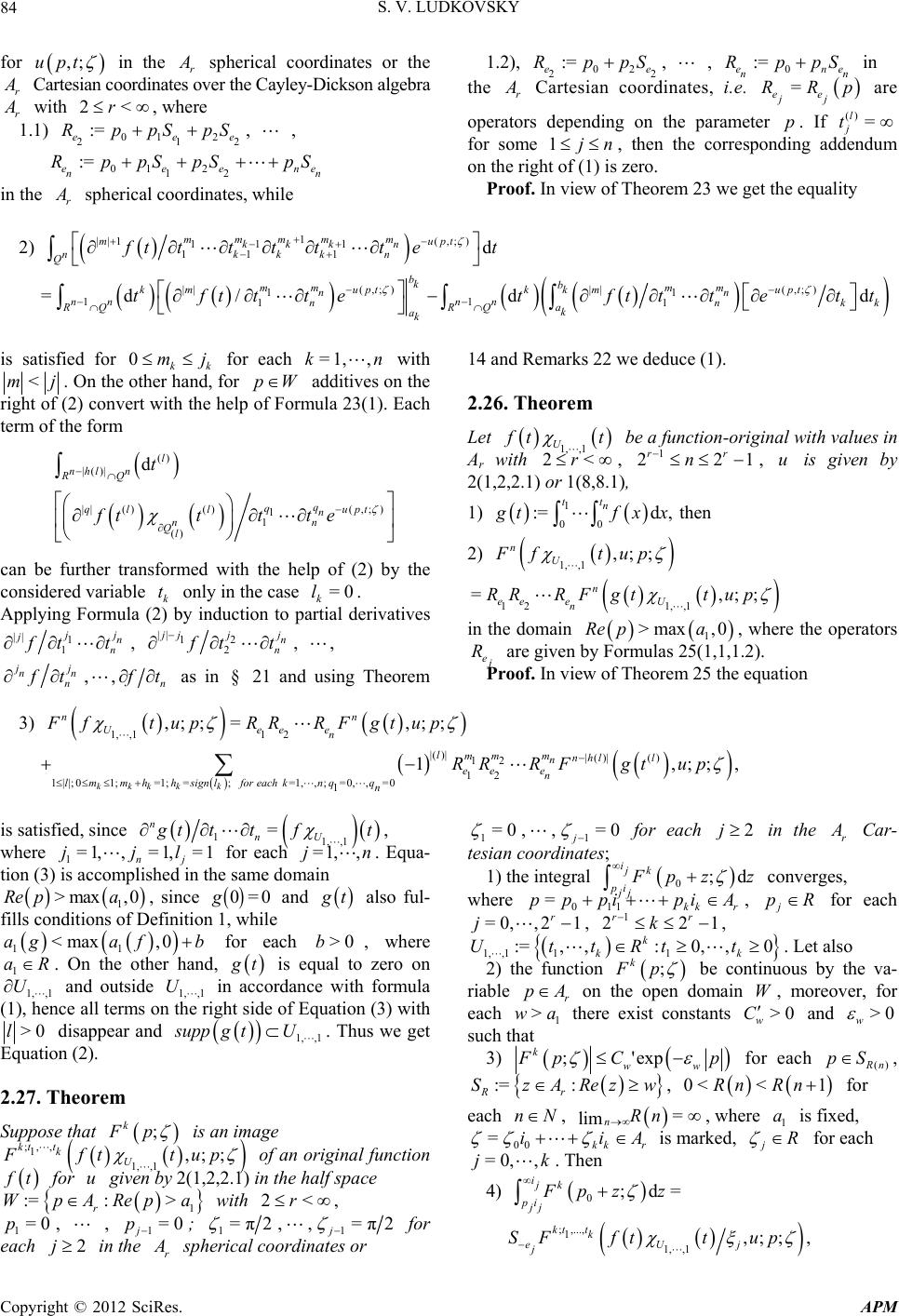 S. V. LUDKOVSKY Copyright © 2012 SciRes. APM 84 for ,;upt in the r spherical coordinates or the r Cartesian coordinates over the Cayley-Dickson algebra r with 2<r, where 1.1) 01 2 212 := eee RppSpS , , 01 2 12 := eeene nn RppSpS pS in the r spherical coordinates, while 1.2), 02 22 := ee RppS, , 0 := ene nn RppS in the r Cartesian coordinates, i.e. = ee jj RRp are operators depending on the parameter p. If () = l j t for some 1jn , then the corresponding addendum on the right of (1) is zero. Proof. In view of Theorem 23 we get the equality 2) 1 ||1 (,;) 11 1 11 1d mmm m m mupt kkk n nkkkn Q ttttttet || (,;)||(,;) 1 1 1 1 1 1 =d /dd bkb m m m m k kmuptkmupt n n nn nn nnkk RQRQ a k ak tftttetfttte tt is satisfied for 0kk mj for each =1, ,kn with <mj . On the other hand, for pW additives on the right of (2) convert with the help of Formula 23(1). Each term of the form () |()| | |()()(,;) 1 1 () dl nhln RQ q q ql lupt n nn Ql t fttt te can be further transformed with the help of (2) by the considered variable k t only in the case =0 k l. Applying Formula (2) by induction to partial derivatives || 1 1 j jn n tt, || 12 2 jj jn n tt , , j nn n t,,n t as in § 21 and using Theorem 14 and Remarks 22 we deduce (1). 2.26. Theorem Let 1, ,1 U tt be a function-original with values in Ar with 2<r , 1 221 rr n , u is given by 2(1,2,2.1) or 1(8,8.1), 1) 1 00 :=d,then tt n gtfxx 2) 1, ,1,;; n U Ff tup 12 1,,1 =,;; n ee eU n RRRFgttup in the domain 1 >max ,0Re pa, where the operators e R are given by Formulas 25(1,1,1.2). Proof. In view of Theorem 25 the equation 3) 1, ,112 ,; ;=,; ; nn Ueee n FftupRRRF gtup |( )||()| () 12 12 1||; 01; =1; =; =1,,; =0,,=0 1 1,;;, kkkk k lm mm nhll n eee n lm mh hsignl foreachknqq n RRR Fgtup is satisfied, since 11, ,1 = n nU tt tft , where 1=1, ,=1,=1 nj jjl for each =1,,jn. Equa- tion (3) is accomplished in the same domain 1 >max ,0Re pa, since 0=0g and t also ful- fills conditions of Definition 1, while 11 <max,0agafb for each >0b, where 1 aR. On the other hand, t is equal to zero on 1, ,1 U and outside 1, ,1 U in accordance with formula (1), hence all terms on the right side of Equation (3) with >0l disappear and 1, ,1 suppg tU. Thus we get Equation (2). 2.27. Theorem Suppose that ; k Fp is an image ;, , 1 1, ,1,;; kt t k U Fft tup of an original function t for u given by 2(1,2,2.1) in the half space 1 :=: > r WpARepa with 2<r, 1=0p, , 1=0 j p; 1=π2 ,,1=π2 j for each 2j in the r spherical coordinates or 1=0 ,,1=0 j for each 2j in the r Car- tesian coordinates; 1) the integral 0;d ijk pi jj pz z converges, where 011 =kk r pp pipiA , j pR for each =0, ,21 r j , 1 221 rr k , 1, ,111 :=,,: 0,, 0 k kk UttRtt . Let also 2) the function ; k Fp be continuous by the va- riable r pA on the open domain W, moreover, for each 1 >wa there exist constants >0 w C and >0 w such that 3) ;'exp k ww pC p for each () n pS , :=: Rr SzARezw, 0< <1Rn Rn for each nN , = limnRn , where 1 a is fixed, 00 =kk r iiA is marked, jR for each =0,,jk. Then 4) 0;d= ijk pi jj pz z ; ,..., 1 1, ,1,; ;, kt t k eUj j SFfttup 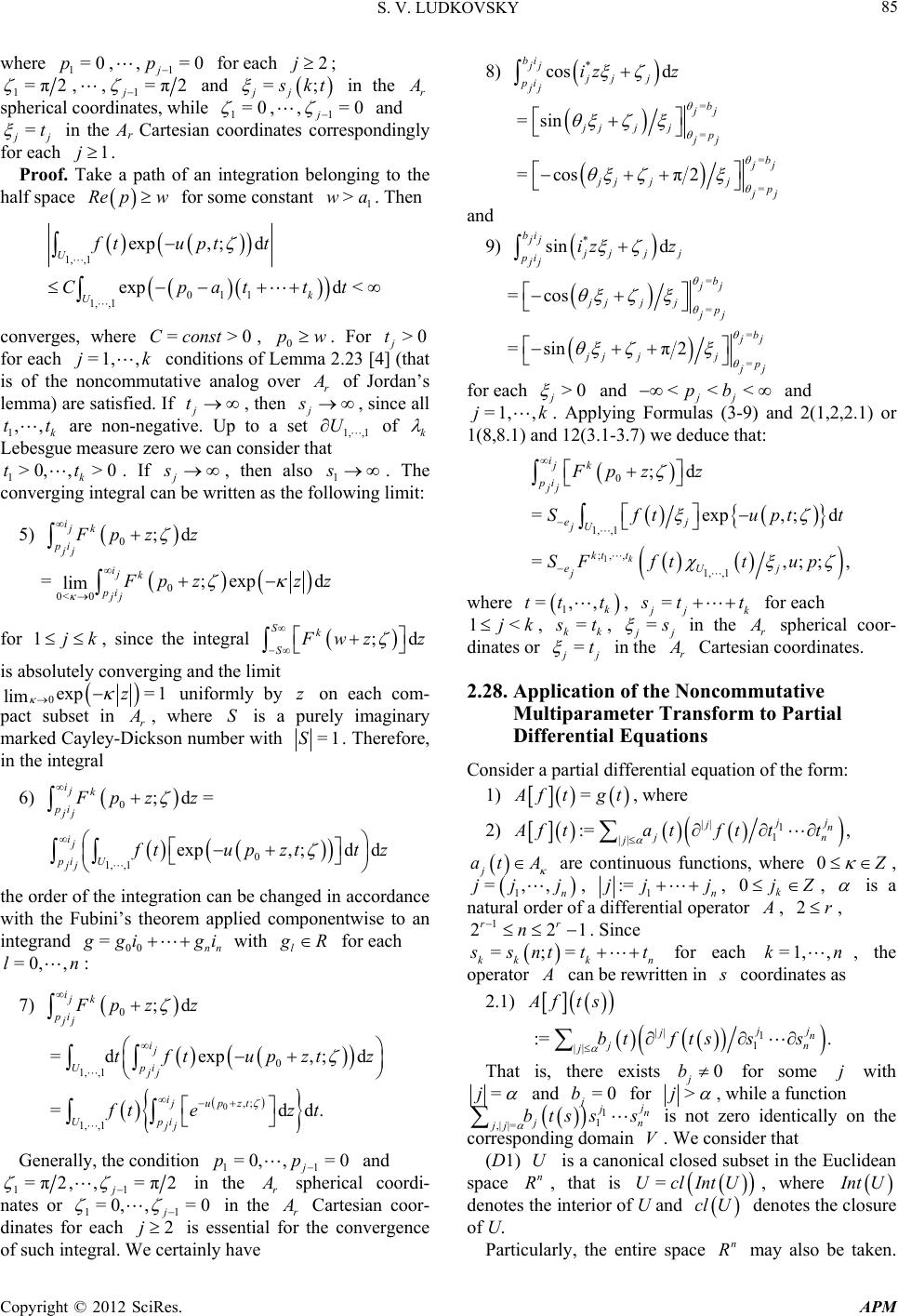 S. V. LUDKOVSKY Copyright © 2012 SciRes. APM 85 where 1=0p,,1=0 j p for each 2j; 1=π2 ,,1=π2 j and =; jj kt in the r spherical coordinates, while 1=0 ,,1=0 j and = j t in the Ar Cartesian coordinates correspondingly for each 1j. Proof. Take a path of an integration belonging to the half space Re pw for some constant 1 >wa. Then 1, ,1 011 1, ,1 exp, ;d expd < U k U ftupt t Cpattt converges, where =>0Cconst, 0 pw. For >0 j t for each =1, ,jk conditions of Lemma 2.23 [4] (that is of the noncommutative analog over r of Jordan’s lemma) are satisfied. If j t, then j s, since all 1,, k tt are non-negative. Up to a set 1, ,1 U of k Lebesgue measure zero we can consider that 1>0,, >0 k tt. If j s, then also 1 s. The converging integral can be written as the following limit: 5) 0;d ijk pi jj pz z 0 0<0 =;expd lim ijk pi jj pz zz for 1jk, since the integral ;d Sk S wzz is absolutely converging and the limit 0exp= 1 lim z uniformly by z on each com- pact subset in r , where S is a purely imaginary marked Cayley-Dickson number with =1S. Therefore, in the integral 6) 0;d= ijk pi jj pz z 0 1, ,1 exp, ;dd ij pi U jj tupzttz the order of the integration can be changed in accordance with the Fubini’s theorem applied componentwise to an integrand 00 =nn gi gi with l R for each =0, ,ln: 7) 0;d ijk pi jj pz z 0 0 1, ,1 ,; 1, ,1 =d exp,;d =dd. ij Upi jj iup zt j Upi jj tft upztz ftez t Generally, the condition 11 =0,,=0 j pp and 11 =π2,,= π2 j in the r spherical coordi- nates or 11 =0,,=0 j in the r Cartesian coor- dinates for each 2j is essential for the convergence of such integral. We certainly have 8) * cos d bi jj jj j pi jj iz z = = = = =sin =cos π2 b jj jjjjp jj b j jj jj j and 9) * sin d bi jj jjj pi jj iz z = = = = =cos =sinπ2 b jj jjjjp jj b j jj jj j for each > 0 j and <<< jj pb and =1,,jk. Applying Formulas (3-9) and 2(1,2,2.1) or 1(8,8.1) and 12(3.1-3.7) we deduce that: 1 0 1, ,1 ;,, 1, ,1 ;d =exp,;d =,;;, k ijk pi jj ej jU kt t eUj j Fp zz Sft uptt SFftt up where 1 =,, k tt t, = jk tt for each 1<jk , = kk t, = j in the r spherical coor- dinates or = j t in the r Cartesian coordinates. 2.28. Application of the Noncommutative Multiparameter Transform to Partial Differential Equations Consider a partial differential equation of the form: 1) = ft gt , where 2) || 1 1 || := , j j jn jn j Afta tfttt j at A are continuous functions, where 0 , 1 =,, n jj j, 1 := n jj j , 0k jZ, is a natural order of a differential operator , 2r , 1 221 rr n . Since =;= kkk n snt tt for each =1, ,kn, the operator can be rewritten in coordinates as 2.1) fts || 1 1 || := . j j jn jn jbtfts ss That is, there exists 0 j b for some j with =j and =0 j b for >j , while a function 1 1 ,| |= jn n jj btss s is not zero identically on the corresponding domain V. We consider that (D1) U is a canonical closed subset in the Euclidean space n R, that is =UclIntU, where nt U denotes the interior of U and cl U denotes the closure of U. Particularly, the entire space n R may also be taken. 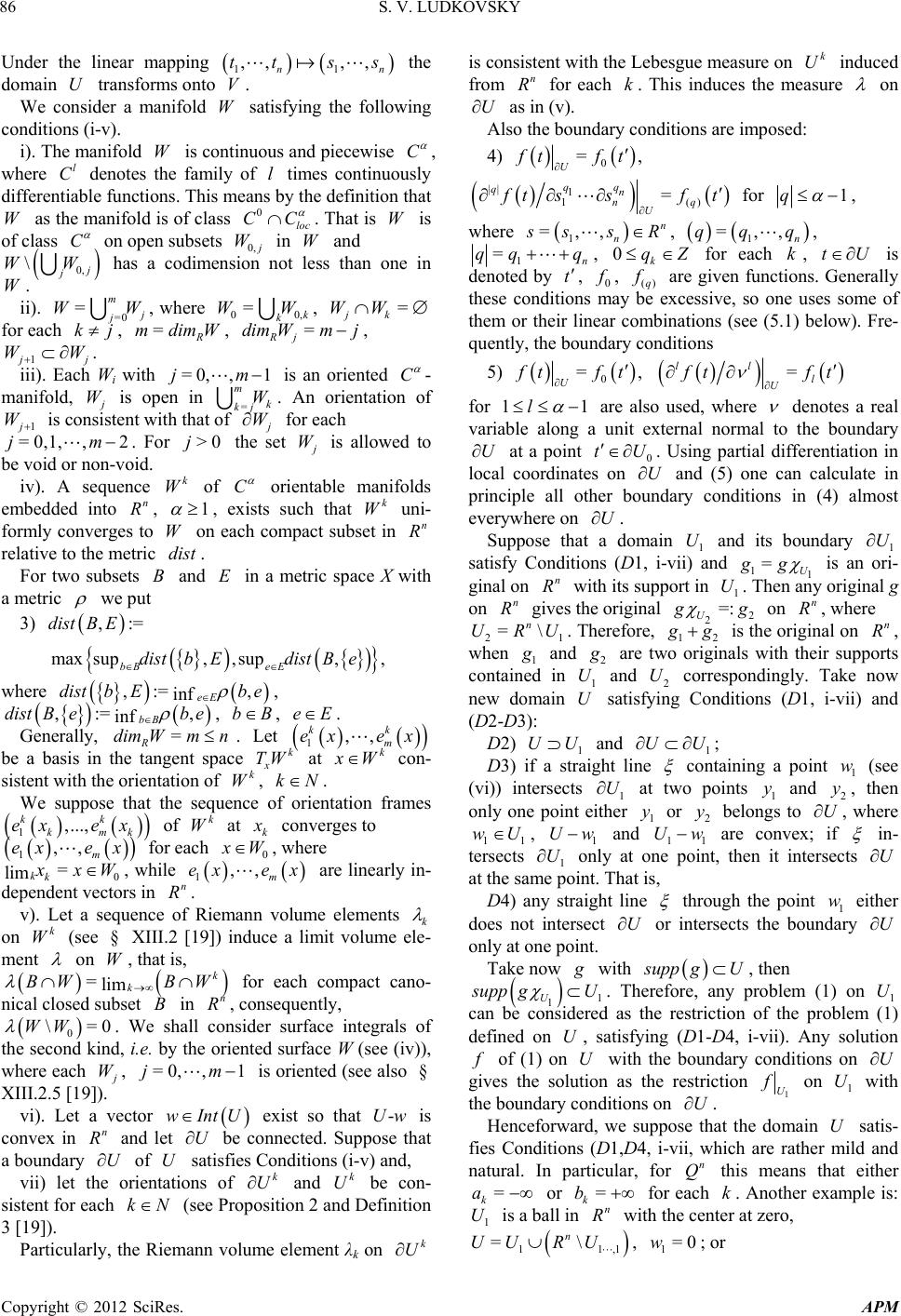 S. V. LUDKOVSKY Copyright © 2012 SciRes. APM 86 Under the linear mapping 11 ,, ,, nn tt ss the domain U transforms onto V. We consider a manifold W satisfying the following conditions (i-v). i). The manifold W is continuous and piecewise C , where l C denotes the family of l times continuously differentiable functions. This means by the definition that W as the manifold is of class 0 loc CC . That is W is of class C on open subsets 0, W in W and 0, \ j WW has a codimension not less than one in W. ii). =0 =m j WW , where 00, =k k WW , = jk WW for each kj, =R mdimW, = Rj dim Wmj, 1 j WW . iii). Each Wi with =0, ,1jm is an oriented C - manifold, W is open in = m k kj W . An orientation of 1 W is consistent with that of W for each =0,1, ,2jm. For >0j the set W is allowed to be void or non-void. iv). A sequence k W of C orientable manifolds embedded into n R, 1 , exists such that k W uni- formly converges to W on each compact subset in n R relative to the metric dist . For two subsets B and E in a metric space X with a metric we put 3) ,:=distBE max, ,,, sup sup bB eE distbEdistBe where ,:= , inf eE distbEb e , ,:= , inf bB distBebe , bB, eE. Generally, = R dim Wmn. Let 1,, kk m ex ex be a basis in the tangent space k x TW at k W con- sistent with the orientation of k W, kN. We suppose that the sequence of orientation frames 1,..., kk kmk exex of k W at k converges to 1,, m exe x for each 0 W , where 0 = limkk xW, while 1,, m exex are linearly in- dependent vectors in n R. v). Let a sequence of Riemann volume elements k on k W (see § XIII.2 [19]) induce a limit volume ele- ment on W, that is, =lim k k BW BW for each compact cano- nical closed subset B in n R, consequently, 0 \=0WW . We shall consider surface integrals of the second kind, i.e. by the oriented surface W (see (iv)), where each W, =0,,1jm is oriented (see also § XIII.2.5 [19]). vi). Let a vector wIntU exist so that -Uw is convex in n R and let U be connected. Suppose that a boundary U of U satisfies Conditions (i-v) and, vii) let the orientations of k U and k U be con- sistent for each kN (see Proposition 2 and Definition 3 [19]). Particularly, the Riemann volume element λk on k U is consistent with the Lebesgue measure on k U induced from n R for each k. This induces the measure on U as in (v). Also the boundary conditions are imposed: 4) 0 =, U tft || 1 1() = q q qn nq U ts sft for 1q , where 1 =,, n n ssR, 1 =,, n qq q, 1 =n qq q , 0k qZ for each k, tU is denoted by t , 0 , ()q are given functions. Generally these conditions may be excessive, so one uses some of them or their linear combinations (see (5.1) below). Fre- quently, the boundary conditions 5) 0 =, U tft = ll l U tft for 11l are also used, where denotes a real variable along a unit external normal to the boundary U at a point 0 tU . Using partial differentiation in local coordinates on U and (5) one can calculate in principle all other boundary conditions in (4) almost everywhere on U . Suppose that a domain 1 U and its boundary 1 U satisfy Conditions (D1, i-vii) and 11 =U gg is an ori- ginal on n R with its support in 1 U. Then any original g on n R gives the original 2 2=: U g on n R, where 21 =\ n URU . Therefore, 12 g is the original on n R, when 1 and 2 are two originals with their supports contained in 1 U and 2 U correspondingly. Take now new domain U satisfying Conditions (D1, i-vii) and (D2-D3): D2) 1 UU and 1 UU ; D3) if a straight line containing a point 1 w (see (vi)) intersects 1 U at two points 1 y and 2 y, then only one point either 1 y or 2 y belongs to U , where 11 wU , 1 Uw and 11 Uw are convex; if in- tersects 1 U only at one point, then it intersects U at the same point. That is, D4) any straight line through the point 1 w either does not intersect U or intersects the boundary U only at one point. Take now with upp gU, then 1 1 U upp gU . Therefore, any problem (1) on 1 U can be considered as the restriction of the problem (1) defined on U, satisfying (D1-D4, i-vii). Any solution of (1) on U with the boundary conditions on U gives the solution as the restriction 1 U on 1 U with the boundary conditions on U. Henceforward, we suppose that the domain U satis- fies Conditions (D1,D4, i-vii, which are rather mild and natural. In particular, for n Q this means that either = k a or = k b for each k. Another example is: 1 U is a ball in n R with the center at zero, 11,1 =\ n UU RU, 1=0w; or  S. V. LUDKOVSKY Copyright © 2012 SciRes. APM 87 1 =: n n UU tRt with a marked number 0< <12 . But subsets ()l U in U can also be spe- cified, if the boundary conditions demand it. The complex field has the natural realization by 22 real matrices so that 0 1 =1 0 i , 21 0 = 0 1 i . The qua- ternion skew field, as it is well-known, can be realized with the help of 22 complex matrices with the gene- rators 10 = 01 I , 01 =1 0 J , 0 =0 i Ki , 0 =0 i Li , or equivalently by 44 real matrices. Considering matrices with entries in the Cayley-Dickson algebra v one gets the complexified or quaternionified Cayley-Dickson algebras vC or v A with elements =zaIbi or = zaIbJcKeL , where ,,,v abce A, such that each v aA commutes with the generators i, , , K and L. When =2r, and have values in 2= H and 24n and coefficients of differential operators belong to 2 , then the multiparameter noncommutative transform operates with the associative case so that = nn afaFf for each aH . The left linearity property = nn afaFf for any ,, KL aH is also accom- plished for either operators with coefficients in R or = i RCIR iR or ,, = JKL IR JR KRLR and with values in v with 121 v n ; or vice versa with values in i C or ,, KL H and coefficients a in v but with 14n . Thus all such variants of ope- rator coefficients a and values of functions can be treated by the noncommutative transform. Henceforward, we suppose that these variants take place. We suppose that t is an original function, that is satisfying Conditions 1(1-4). Consider at first the case of constant coefficients a on a quadrant domain n Q. Let n Q be oriented so that = k a and = k b for each kn ; either = k a or = k b for each >kn , where 0n is a marked integer number. If conditions of Theorem 25 are satisfied, then 6) 12 12 || ,; ;=,; ; j jj n n n je een nQ j FAftupaRpR pR pFfttup 1|()|; =; 0; 0; =(); =0=0,=1,...,; (){0,1,2} |( )|12 |()| ||()()1 1 12 () 1,; ; = kkkkkkkkk kkkn ljmqhjmqhsignljqforl jforeachknl m mm n lj q q nhljqljljn ee enn nQlj n RpR pRpFftttt up Fgt ,; ; n Qtup for ,;upt in the r spherical or r Cartesian coordinates, where the operators j e Rp are given by Formulas 25(1.1) or 25(1.2). Here l enumerates faces () n l Q in 1 n k Q for =1hlk, so that 1() |()|= = nn kl hl k QQ , ()() = nn lm QQ for each lm in accordance with § 25 and the notation of this section. Therefore, Equation (6) shows that the boundary con- ditions are necessary: || ()1 1 () q q ql n nn Ql fttt for j , 1lj , 0 j a, =0 k q for =0 kk lj , = kkkk mqh j, = kkk hsignlj , =1, ,kn, () () ln l tQ. But =1 n R dim Qn for n Q, consequently, || ()1 1 () q q ql n nn Ql fttt can be calculated if know || ()1 (1)( ) () lm mn Ql ft tt for =q , where 1 =,, m , =mhl, a number k corres- ponds to ()>0 k l , since =0 k q for =0 k l and >0 k q only for >0 kk lj and > kn . That is, (1)( ) ,,m tt are coordinates in n R along unit vectors orthogonal to () n l Q. Take a sequence k U of sub-domains 1kk UUU for each kN so that each () , =1 =mk kn kl l UQ is the finite union of quadrants , n kl Q, mkN . We choose them so that each two different quadrants may intersect only by their borders, each k U satisfies the same conditions as U and 7) ,=0 lim k kdistU U . Therefore, Equation (6) can be written for more gen- eral domain U also. For U instead of n Q we get a face ()l U instead of () n l Q and local coordinates (1)() ,,m orthogo- nal to ()l U instead of (1)( ) ,,m tt (see Conditions (i-iii) above). Thus the sufficient boundary conditions are: 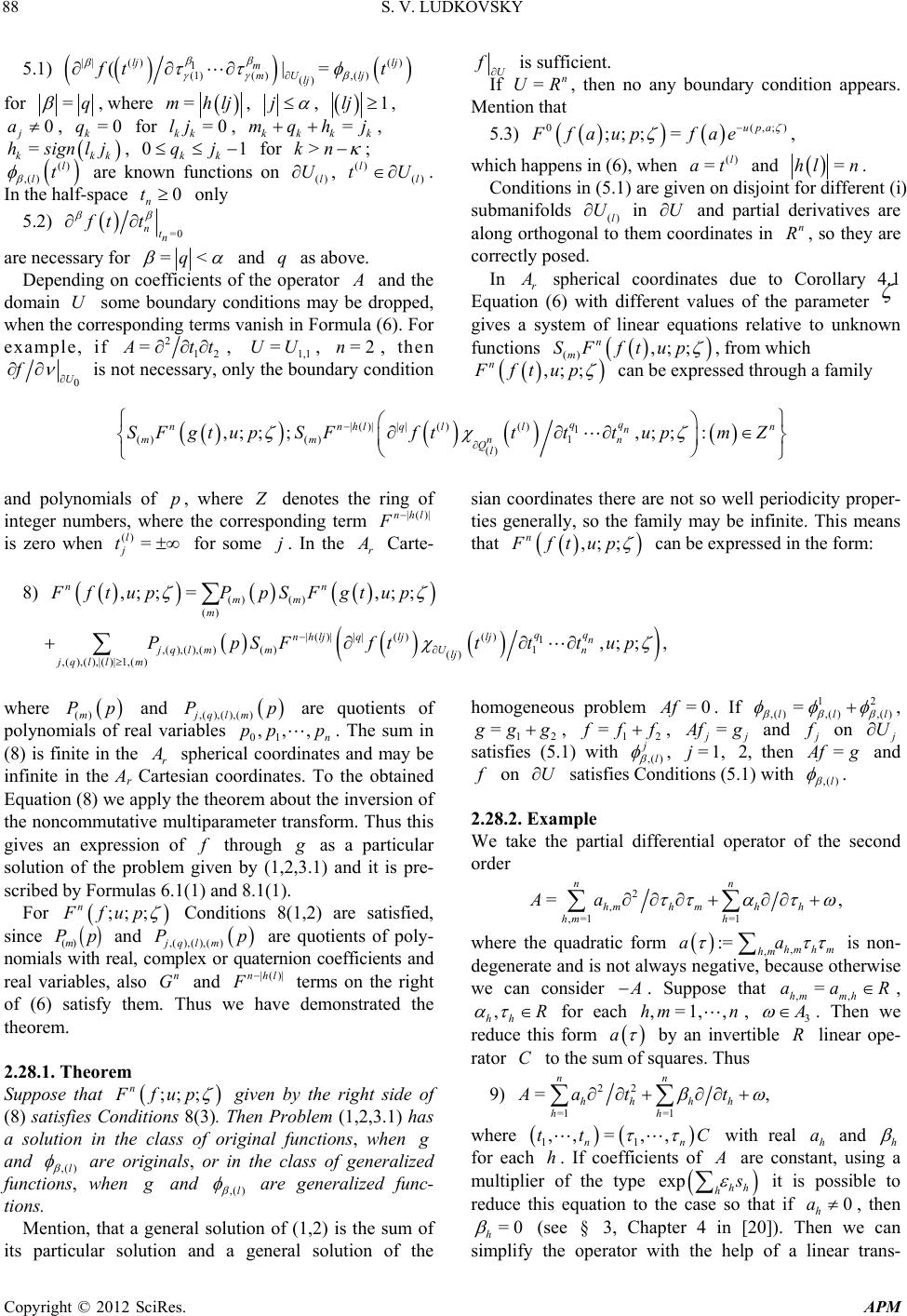 S. V. LUDKOVSKY Copyright © 2012 SciRes. APM 88 5.1) || ()() 1 (1)(),( ) () (|= lj lj m mU lj lj tt for =q , where =mhlj, j , 1lj , 0 j a, =0 k q for =0 kk lj , = kkkk mqh j , = kkk hsign lj, 01 kk qj for >kn ; () ,() l lt are known functions on ()l U, () () l l tU. In the half-space 0 n t only 5.2) =0 ntn ft t are necessary for =<q and q as above. Depending on coefficients of the operator and the domain U some boundary conditions may be dropped, when the corresponding terms vanish in Formula (6). For example, if 2 12 = tt, 1,1 =UU, =2n, then 0 U f is not necessary, only the boundary condition U is sufficient. If =n UR, then no any boundary condition appears. Mention that 5.3) 0(,;) ;; ;=upa Ffaup fae , which happens in (6), when () =l at and =hln. Conditions in (5.1) are given on disjoint for different (i) submanifolds ()l U in U and partial derivatives are along orthogonal to them coordinates in n R, so they are correctly posed. In r spherical coordinates due to Corollary 4.1 Equation (6) with different values of the parameter gives a system of linear equations relative to unknown functions () ,; ; n m SF ftup , from which ,; ; n Fftup can be expressed through a family | ()|| |()()1 ()()1 () ,;;; ,;;: q q nnhlqll n n mm nn Ql SFgtupSFftttt upmZ and polynomials of p, where denotes the ring of integer numbers, where the corresponding term |()|nhl is zero when () = l j t for some j. In the r Carte- sian coordinates there are not so well periodicity proper- ties generally, so the family may be infinite. This means that ,; ; n Fftup can be expressed in the form: 8) ()() () ,; ;=,;; nn mm m FftupPpSFgtup |()| ||()()1 ,(),(),()()1 () ,(),( ),|( )|1,() ,; ;, q q nhljqljljn jq l mmUn lj jq llm PpSF fttttup where ()m Pp and ,(),(),()jq lm Pp are quotients of polynomials of real variables 01 ,,, n pp p. The sum in (8) is finite in the r spherical coordinates and may be infinite in the Ar Cartesian coordinates. To the obtained Equation (8) we apply the theorem about the inversion of the noncommutative multiparameter transform. Thus this gives an expression of through as a particular solution of the problem given by (1,2,3.1) and it is pre- scribed by Formulas 6.1(1) and 8.1(1). For ;;; n Ffup Conditions 8(1,2) are satisfied, since ()m Pp and ,(),(),()jq lm Pp are quotients of poly- nomials with real, complex or quaternion coefficients and real variables, also n G and |()|nhl terms on the right of (6) satisfy them. Thus we have demonstrated the theorem. 2.28.1. Theorem Suppose that ;;; n Ffup given by the right side of (8) satisfies Conditions 8(3). Then Problem (1,2,3.1 ) has a solution in the class of original functions, when and ,( )l are originals, or in the class of generalized functions, when and ,( )l are generalized func- tions. Mention, that a general solution of (1,2) is the sum of its particular solution and a general solution of the homogeneous problem =0Af . If 12 ,( ),( ),( ) = lll , 12 = gg , 12 = ff , = j fg and on U satisfies (5.1) with ,() j l , =1,j 2, then = fg and on U satisfies Conditions (5.1) with ,( )l . 2.28.2. Example We take the partial differential operator of the second order 2 , ,=1 =1 =, nn hmh mhh hm h Aa where the quadratic form , , := hm hm hm aa is non- degenerate and is not always negative, because otherwise we can consider . Suppose that ,, = hm mh aaR , , hh R for each ,=1,,hmn, 3 . Then we reduce this form a by an invertible R linear ope- rator C to the sum of squares. Thus 9) 22 =1 =1 =, nn hh hh hh Aa tt where 11 ,,=,, nn tt C with real h a and h for each h. If coefficients of are constant, using a multiplier of the type exp hh h it is possible to reduce this equation to the case so that if 0 h a , then =0 h (see § 3, Chapter 4 in [20]). Then we can simplify the operator with the help of a linear trans-  S. V. LUDKOVSKY Copyright © 2012 SciRes. APM 89 formation of coordinates and consider that only n may be non-zero if =0 n a. For with constant coeffi- cients as it is well-known from algebra one can choose a constant invertible real matrix ,,=1,, hm hmk c corresponding to C so that =1 h a for hk and =1 h a for >hk , where 0< kn . For =kn and =0 the operator is elliptic, for =1kn with =0 n a and 0 n the operator is parabolic, for 0< <kn and =0 the operator is hyperbolic. Then Equation (6) simplifies: 10) 2 =1 ,; ;=,; ; n nn hen hQ h FAftupaR pF fttup 1()()1 ()() () () {1,2};( )= ,2 ,1 1;,2,21; ,1,1 2 1,;;( ,;; ,; ;,; ; lnllnll h nh en h Q Q l l llle hhh nn ntnnnt nn nn n QQ ee nn Fft ttupRpFft tup FfttupFft tup R ,;;,;; =,;; nnn en n nQQ pFfttupFft tupFgtup in the r spherical or r Cartesian coordinates, where = 0,,0,1,0,,0n h eR with 1 on the h-th place, 0=SI is the unit operator, the operators eh Rp are given by Formulas 25(1.1) or 25(12) respectively. We denote by S the delta function of a con- tinuous piecewise differentiable manifold S in n R satisfying conditions (i-vi) so that d= d nSm RS xxyy for a continuous integrable function on n R, where =<dimSmn, d m denotes a volume ele- ment on the m dimensional surface S (see Condition (v) above). Thus we can consider a non-commutative mul- tiparameter transform on U for an original on U given by the formula: 11) 1; ,; ; nt UU Fft tup . ; =,;; nt U Fft tup Therefore, terms like 1n in (10) correspond to the boundary n Q . They can be simplified: 12) ,2 ,1 1;,21; ,1 2 ,; ;,; ; nn ntnnt n nn n QQ ee nn FfttupFf ttup 1; =,;;, nt nn QQ Ftfttup where t is a piecewise constant function on n Q equal to n on the corresponding faces of n Q ortho- gonal to n e given by condition: either = nn ta or = nn tb; =0t is zero otherwise. If = k a or = k b, then the corresponding term disappears. If n R embed into r with 1 221 rr n as 1n Ri Ri , then this induces the corresponding embedding of n Q or U into r . This permits to make further simplification: 12.1) 1 ()()1()() () () =1{1,2};( )= 1,;;,;; nlnl lnl l h hen nh hQQ ll hl lle hhh aRpFfttupFft ttup 1 1 0 0 =,,;;;,;;, n n nn nn QQ QQ Fatftt uptpFPtfttup where =t denotes a real coordinate along an ex- ternal unit normal t to U at t , so that t is a purely imaginary Cayley-Dickson number, at is a piecewise constant function equal to h a for the corresponding t in the face n le hh Q with >0 h l; ,:= := eh tpPtRp for n le hh tQ , =1, ,hn, since sin π=sin and cos π=cos for each R . Certainly the operator-valued function Pt has a piecewise conti- nuous extension Pt on n Q. That is 13) 1,,;;; n UU Ftft tuptp :=exp, ;d nU Rtft tupt t 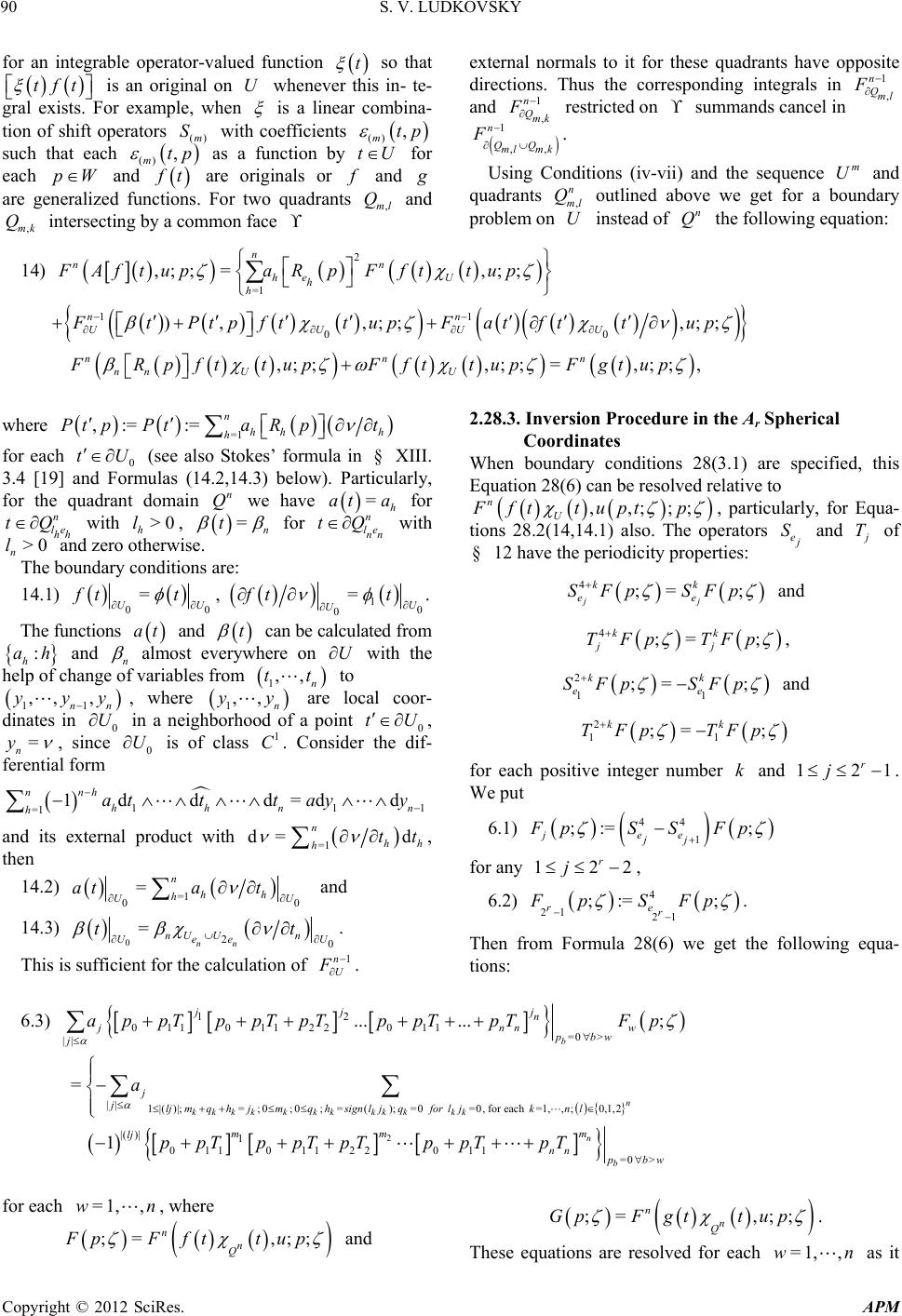 S. V. LUDKOVSKY Copyright © 2012 SciRes. APM 90 for an integrable operator-valued function t so that tft is an original on U whenever this in- te- gral exists. For example, when is a linear combina- tion of shift operators ()m S with coefficients () , mtp such that each () , mtp as a function by tU for each pW and t are originals or and are generalized functions. For two quadrants ,ml Q and ,mk Q intersecting by a common face external normals to it for these quadrants have opposite directions. Thus the corresponding integrals in 1 , n Qml F and 1 , n Qmk F restricted on summands cancel in 1 ,, n QQ ml mk F . Using Conditions (iv-vii) and the sequence m U and quadrants , n ml Q outlined above we get for a boundary problem on U instead of n Q the following equation: 14) 2 =1 ,; ;=,; ; n nn he U h h FAftupaR pFfttup 1 1 00 ), ,;;,;; ,;;,;;=,;;, n n UUUU nnn nn UU FtPtpf ttupFatf ttup FRpfttupFfttup Fgtup where =1 ,:=:=n hh h h Pt pPtaRpt for each 0 tU (see also Stokes’ formula in § XIII. 3.4 [19] and Formulas (14.2,14.3) below). Particularly, for the quadrant domain n Q we have =h at a for n le hh tQ with >0 h l, =n t for n le nn tQ with >0 n l and zero otherwise. The boundary conditions are: 14.1) 1 00 0 0 =, = UU U U fttftt . The functions at and t can be calculated from : h ah and n almost everywhere on U with the help of change of variables from 1,, n tt to 11 ,,, nn yy , where 1,, n y are local coor- dinates in 0 U in a neighborhood of a point 0 tU , = n y , since 0 U is of class 1 C. Consider the dif- ferential form 111 =1 1d dd=dd nh n hhn n hattt ayy and its external product with =1 d= d n hh htt , then 14.2) =1 00 = n hh h UU ata t and 14.3) 020 = nn nU Un UU ee tt . This is sufficient for the calculation of 1n U . 2.28.3. Inversion Procedure in the Ar Spherical Coordinates When boundary conditions 28(3.1) are specified, this Equation 28(6) can be resolved relative to ,,;;; n U Ffttupt p , particularly, for Equa- tions 28.2(14,14.1) also. The operators e S and T of § 12 have the periodicity properties: 4;=; jj kk ee SFp SFp and 4;= ; kk jj TFp TFp , 2 11 ;=; kk ee SFp SFp and 2 11 ;= ; kk TFp TFp for each positive integer number k and 121 r j . We put 6.1) 44 1 ;:= ; jee jj FpS SFp for any 122 r j , 6.2) 4 21 21 ;:= ; re r Fp SFp . Then from Formula 28(6) we get the following equa- tions: 6.3) 12 01101122011=0 > || ...... ; b jjj n jnnw pbw j ap pTp pTpTp pTpTFp 2 || 1|()|; =; 0; 0; =(); =0=0, foreach=1,,; 0,1,2 |( )|1 011 01122011=0 > = 1 n kkkkkkkkk kkk n b j jljmqhjmqhsign ljqfor ljknl mm m lj nn bw a ppT ppTpTppTpT for each =1, ,wn , where ;= ,;; n n Q FpFftt up and ;= ,;; n n Q GpFgtt up . These equations are resolved for each =1,,wn as it 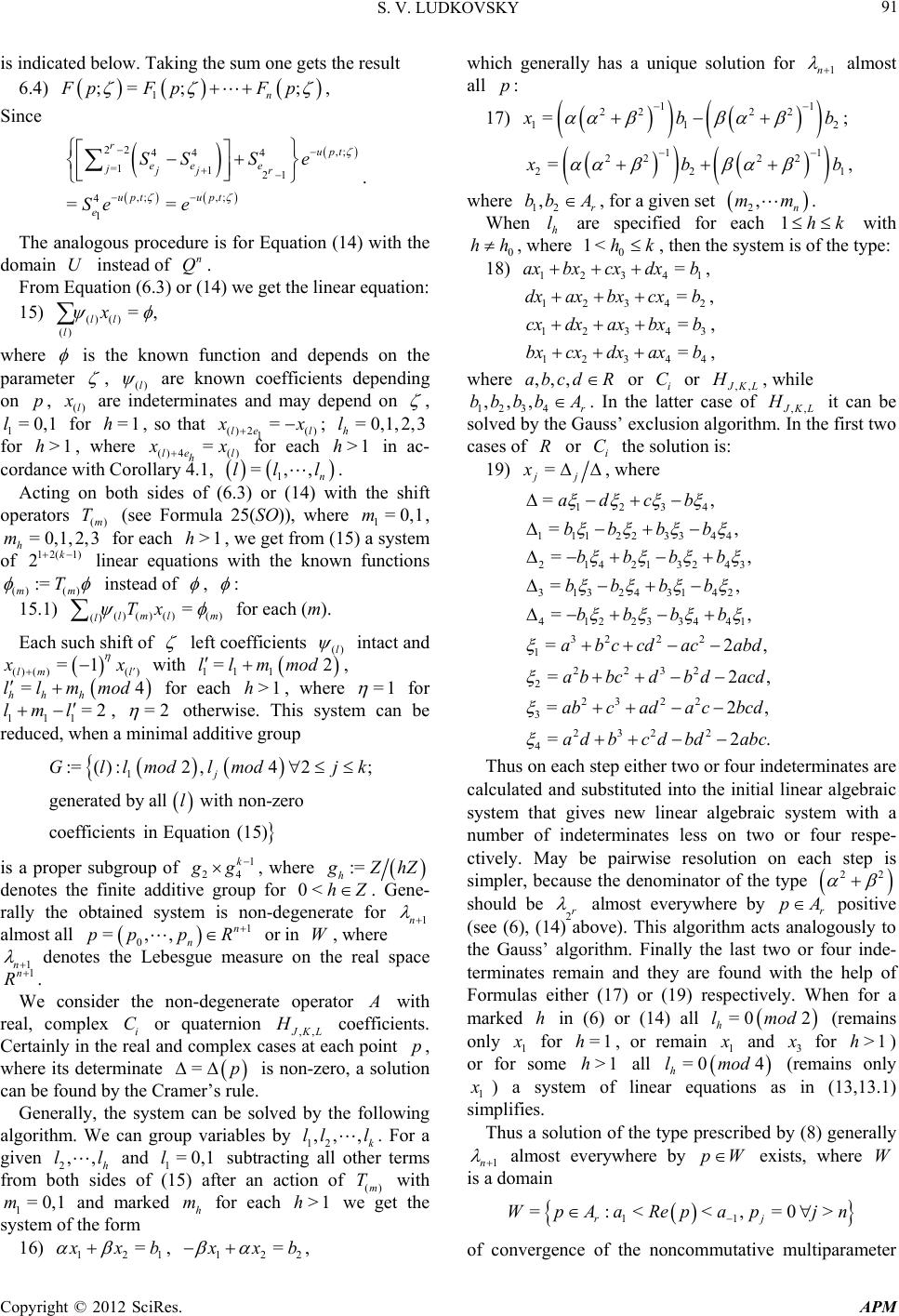 S. V. LUDKOVSKY Copyright © 2012 SciRes. APM 91 is indicated below. Taking the sum one gets the result 6.4) 1 ;= ;; n FpF pFp , Since 22 ,; 444 =1 121 ,; ,; 4 1 == rupt ee e jjjr uptupt e SSSe Se e . The analogous procedure is for Equation (14) with the domain U instead of n Q. From Equation (6.3) or (14) we get the linear equation: 15) () () () =, ll l x where is the known function and depends on the parameter , ()l are known coefficients depending on p, ()l are indeterminates and may depend on , 1=0,1l for =1h, so that () 2() 1= le l x ; =0,1,2,3 h l for >1h, where () 4() = le l h x for each >1h in ac- cordance with Corollary 4.1, 1 =,, n lll. Acting on both sides of (6.3) or (14) with the shift operators ()m T (see Formula 25(SO)), where 1=0,1m, =0,1,2,3 h m for each >1h, we get from (15) a system of 12(1) 2k linear equations with the known functions () () := mm T instead of , : 15.1) ()()()( ) () = lml m lTx for each (m). Each such shift of left coefficients ()l intact and () ()( ) =1 lm l x with 11 1 = 2llmmod , = 4 hh h llmmod for each >1h, where =1 for 111 =2lml , =2 otherwise. This system can be reduced, when a minimal additive group 1 :=(): 2, 4 2; generated by allwith non-zero coefficientsin Equation(15) j Gllmodlmod jk l is a proper subgroup of 1 24 k g , where := h ZhZ denotes the finite additive group for 0<hZ. Gene- rally the obtained system is non-degenerate for 1n almost all 1 0 =,,n n ppp R or in W, where 1n denotes the Lebesgue measure on the real space 1n R. We consider the non-degenerate operator with real, complex i C or quaternion ,, KL H coefficients. Certainly in the real and complex cases at each point p, where its determinate =p is non-zero, a solution can be found by the Cramer’s rule. Generally, the system can be solved by the following algorithm. We can group variables by 12 ,, , k ll l. For a given 2,, h ll and 1=0,1l subtracting all other terms from both sides of (15) after an action of ()m T with 1=0,1m and marked h m for each >1h we get the system of the form 16) 121 = xb , 122 = xb , which generally has a unique solution for 1n almost all p: 17) 11 2222 112 = bb ; 11 22 22 221 = bb , where 12 ,r bb A , for a given set 2,n mm. When h l are specified for each 1hk with 0 hh , where 0 1< hk , then the system is of the type: 18) 12341 =axbxcxdxb , 12342 =dxaxbxcxb , 12343 =cx dxaxbxb , 12344 =bx cxdxaxb , where ,,,abcd R or i C or ,, KL H, while 1234 ,,, r bb bbA . In the latter case of ,, KL H it can be solved by the Gauss’ exclusion algorithm. In the first two cases of R or i C the solution is: 19) = jj x , where 1234 111223344 2 14213243 313243142 4 12233441 3222 1 2232 2 2322 3 2322 4 =, =, =, =, =, =2, =2, =2, =2 ad cb bbbb bbbb bb bb bbbb abccd acabd ab bcdbdacd abcada cbcd ad bcd bd .abc Thus on each step either two or four indeterminates are calculated and substituted into the initial linear algebraic system that gives new linear algebraic system with a number of indeterminates less on two or four respe- ctively. May be pairwise resolution on each step is simpler, because the denominator of the type 22 should be 2r almost everywhere by r pA positive (see (6), (14) above). This algorithm acts analogously to the Gauss’ algorithm. Finally the last two or four inde- terminates remain and they are found with the help of Formulas either (17) or (19) respectively. When for a marked h in (6) or (14) all =0 2 h lmod (remains only 1 for =1h, or remain 1 and 3 for >1h) or for some >1h all =0 4 h lmod (remains only 1 ) a system of linear equations as in (13,13.1) simplifies. Thus a solution of the type prescribed by (8) generally 1n almost everywhere by pW exists, where W is a domain 11 =:<<, =0 > rj WpAaRepap jn of convergence of the noncommutative multiparameter  S. V. LUDKOVSKY Copyright © 2012 SciRes. APM 92 transform, when it is non-void, 1 221 rr n , 0 =Repp, 00 =nn ppi pi. This domain W is caused by properties of and initial conditions on U and by the domain U also. Generally U is worthwhile to choose with its interior nt U non-intersecting with a characteristic surface 1,, =0 n xx , i.e. at each point of it the condition is satisfied 1 1 ||= =0 j jn jn j CSat xxx and at least one of the partial derivatives 0 k x is non-zero. In particular, the boundary problem may be with the right side = f in (2,2.1,14), where is a real or complex i C or quaternion ,, KL H multiplier, when boundary conditions are non-trivial. In the space either , n r DR A or , n r BR A (see § 19) a partial diff- erential problem simplifies, because all boundary terms disappear. If ,, n r BR A then : 0 rf pARep W. For , n r DR A certainly = r WA (see also § 9). 2.28.4. Examples Take partial differential equations of the fourth order. In this subsection the noncommutative multiparameter trans- forms in r spherical coordinates are considered. For 20) 3344 1=2 =n j j ss with constants ,, \0 jJKL H on the space either , n r DR A or , n r BRA, where 2n, Equation (6) takes the form: 21) 4 2 2 00 1 1=2 ,; ;=3,; ; n n n ejje j j FAftuppppSpS Fftup 2 2 101 11 3,;; =,;; nn ee pp pSSFftupFgtup due to Corollary 4.1. In accordance with (16,17) we get: 22) 1 22 ;= ; ww Fp Gp 1 22 1; w TGp for each =1, ,wn, where 22 4 00 1=2 =0 > 22 101=0 > == 3, == 3. n wjj j bw b wpbw b pp pp ppp From Theorem 6, Corollary 6.1 and Remarks 24 we infer that: 23) =2π; n n R ftFa p 1 exp, ;ddn uptpp supposing that the conditions of Theorem 6 and Cor- ollary 6.1 are satisfied, where ;= ,;; n FpFftup . If on the space either , k r DR A or , k r BR A an operator is as follows: 24) 422 44 12 =3 =, n j j ss s where ,, \0 jJKL H , where 3n, then (6) reads as: 25) 2 22 2 20 1 12 ,; ;=,; ; nn ee FAft uppppSSFftup 4 22 012 =3 12 2,;; ,;;=,;; n nnn eej je jj pppSSFf tuppSFf tupFgtup If on the same spaces an operator is: 26) 3244 12 =3 =, n j j ss s where 3n, then (6) takes the form: 27) 22 02 2 ,; ;=,; ; nn e FAft upppSFftup 4 22 12 12 =3 ,;;,;;=,;; . n nnn eejje j j ppSSFftuppSFftupFgtup To find ,; ; n Fftup in (23) or (27) after an action of suitable shift operators (0,2,0, ,0) T, (1,0, ,0) T and (1,2,0, ,0) T we get the system of linear algebraic equa- tions: 28) 1341 =ax bxcxb , 1232 =bx cxaxb , 2343 =axcx bxb , 1244 =cx bxaxb 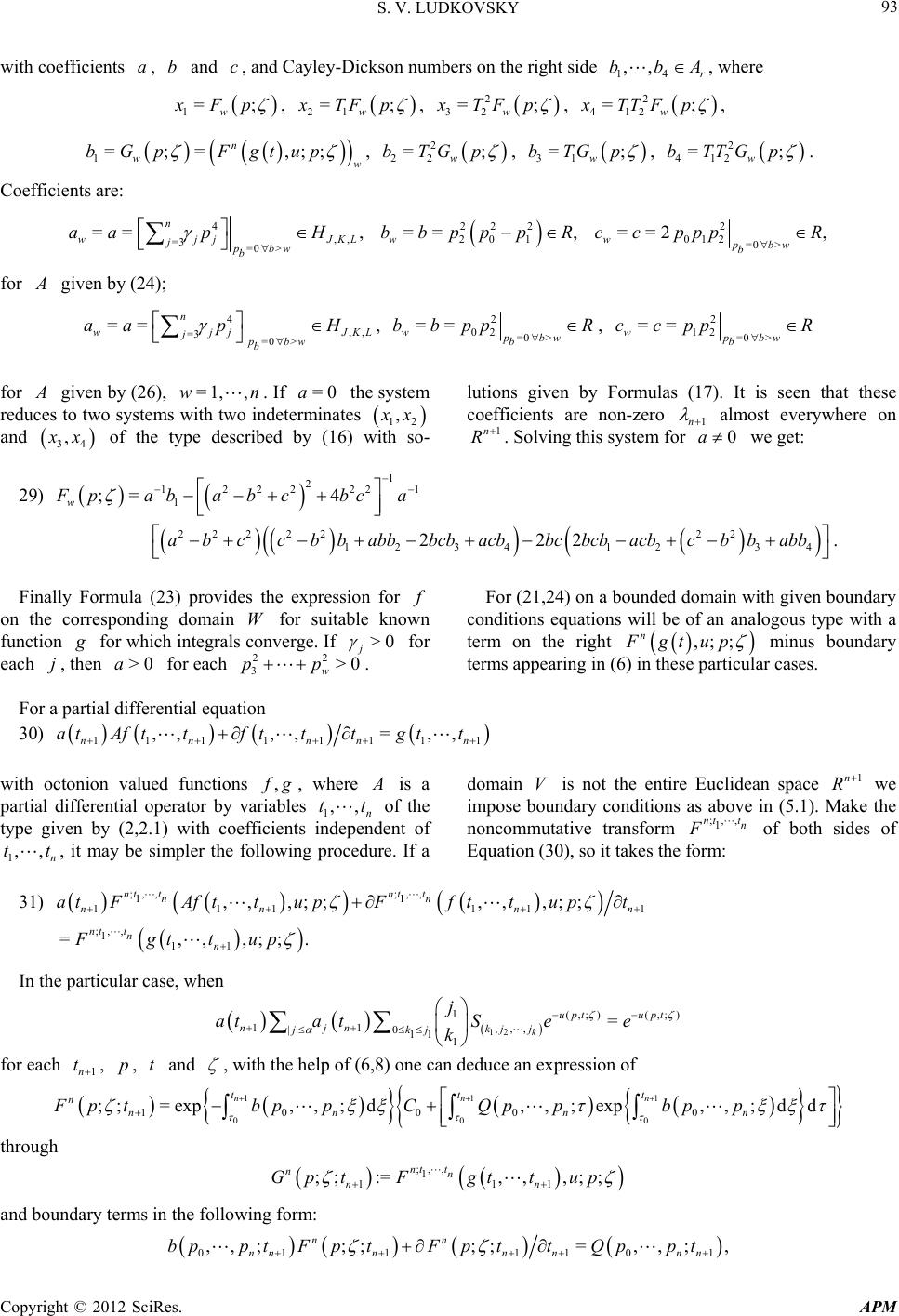 S. V. LUDKOVSKY Copyright © 2012 SciRes. APM 93 with coefficients a, b and c, and Cayley-Dickson numbers on the right side 14 ,, r bbA , where 1=; w xFp , 21 =; w xTFp , 2 32 =; w xTFp , 2 412 =; w xTTFp , 1=;= ,;; n ww bGpFgtup , 2 22 =; w bTGp , 31 =; w bTGp , 2 412 =; w bTTGp . Coefficients are: 4 ,, =3 =0 > == , n wjj JKL jpbw b aa pH 22 2 20 1 == , w bbpppR 2 012 =0 > ==2 , wpbw b cc pppR for given by (24); 4 ,, =3 =0 > == n wjj JKL jpbw b aa pH , 2 02 =0 > == wpbw b bbppR , 2 12 =0 > == wpbw b ccpp R for given by (26), =1,,wn. If =0a the system reduces to two systems with two indeterminates 12 , x and 34 , x of the type described by (16) with so- lutions given by Formulas (17). It is seen that these coefficients are non-zero 1n almost everywhere on 1n R . Solving this system for 0a we get: 29) 1 2 1222221 1 ;= 4 w pababc bca 2222222 12 341234 222abccb babbbcbacbbcbcbacbcb babb . Finally Formula (23) provides the expression for f on the corresponding domain W for suitable known function for which integrals converge. If >0 j for each j, then >0a for each 22 3>0 w pp. For (21,24) on a bounded domain with given boundary conditions equations will be of an analogous type with a term on the right ,; ; n Fgtup minus boundary terms appearing in (6) in these particular cases. For a partial differential equation 30) 11 11 1111 ,,,,= ,, nn nnn atAfttft ttgt t with octonion valued functions ,fg, where is a partial differential operator by variables 1,, n tt of the type given by (2,2.1) with coefficients independent of 1,, n tt, it may be simpler the following procedure. If a domain V is not the entire Euclidean space 1n R we impose boundary conditions as above in (5.1). Make the noncommutative transform ;,, 1 ntt n of both sides of Equation (30), so it takes the form: 31) ;, ,;, , 11 111 111 ,, ,;;,, ,;; nt tnt t nn nn nn atFAftt upFftt upt ;, , 1 11 =,,,;;. nt t n n Fgttup In the particular case, when 12 1(,;) (,;) 11 ,,, ||0 11 1 = k uptupt njn kj j jkj j atatSee k for each 1n t, p, t and , with the help of (6,8) one can deduce an expression of 111 000 1000 0 ;; =exp,,;d,,;exp,,;dd nnn ttt n nn nn FptbppC Qppbpp through ;, , 1 111 ;;:=,,,;; nt t nn nn Gp tFgttup and boundary terms in the following form: 01 11101 ,,;;;;;=,,; , nn nnnn nnn bpp tFptFpttQpp t 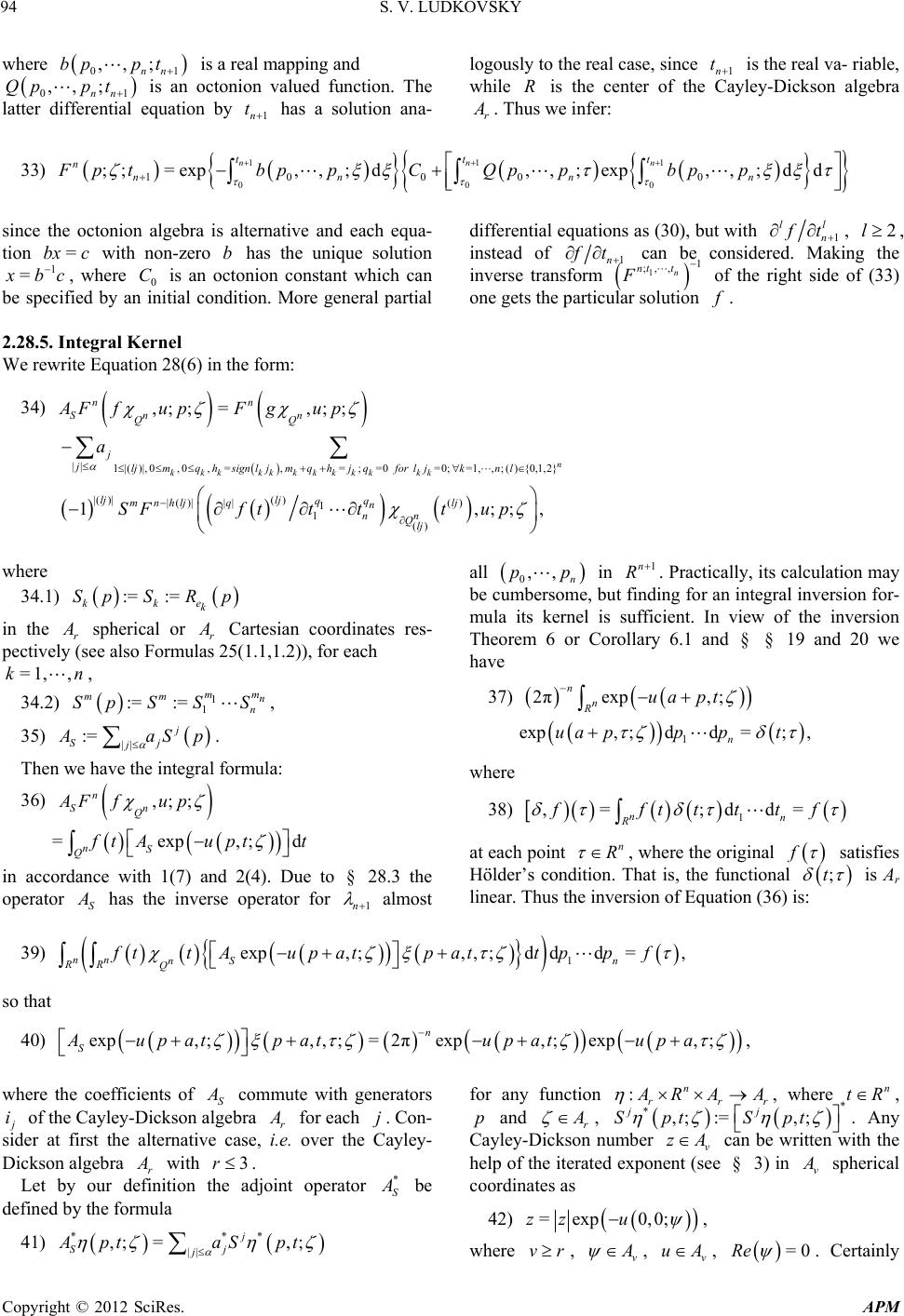 S. V. LUDKOVSKY Copyright © 2012 SciRes. APM 94 where 01 ,,; nn bpp t is a real mapping and 01 ,,; nn Qp pt is an octonion valued function. The latter differential equation by 1n t has a solution ana- logously to the real case, since 1n t is the real va- riable, while R is the center of the Cayley-Dickson algebra r . Thus we infer: 33) 111 000 1000 0 ;; =exp,,;d,,;exp,,;dd nnn ttt n nn nn FptbppCQppbpp since the octonion algebra is alternative and each equa- tion =bxc with non-zero b has the unique solution 1 = bc , where 0 C is an octonion constant which can be specified by an initial condition. More general partial differential equations as (30), but with 1 ll n t , 2l, instead of 1n ft can be considered. Making the inverse transform 11 ;,, n nt t F of the right side of (33) one gets the particular solution f. 2.28.5. Integral Kernel We rewrite Equation 28(6) in the form: 34) ,; ;=,; ; nn Snn QQ AFfupFgup || 1|( )|, 0, 0, =, =; =0=0; =1,,; (){0,1,2} |( )|( ) |()|||() 1 1 () 1,;;, n kkkkkkkkkkkk j jljmqhsignljmqhjqforl jknl ljlj q q mnhlj qlj n nn Qlj a SFftttt up where 34.1) := := kke k SpSR p in the r spherical or r Cartesian coordinates res- pectively (see also Formulas 25(1.1,1.2)), for each =1, ,kn, 34.2) 1 1 := :=m m mm n n Sp SSS, 35) || := j Sj j aSp . Then we have the integral formula: 36) ,; ; n Sn Q AFfup =exp,;d nS Qft Auptt in accordance with 1(7) and 2(4). Due to § 28.3 the operator S has the inverse operator for 1n almost all 0,, n pp in 1n R . Practically, its calculation may be cumbersome, but finding for an integral inversion for- mula its kernel is sufficient. In view of the inversion Theorem 6 or Corollary 6.1 and § § 19 and 20 we have 37) 2πexp, ; n n Rua pt 1 exp, ;dd=;, n ua pppt where 38) 1 ,= ;dd= nn R ffttttf at each point n R , where the original f satisfies Hölder’s condition. That is, the functional ;t is Ar linear. Thus the inversion of Equation (36) is: 39) 1 exp, ;, ,;ddd=, nn nS n RR Q fttAup atp attppf so that 40) exp, ;, ,;=2πexp,;exp,; n S Aup atp atup atup a , where the coefficients of S commute with generators i of the Cayley-Dickson algebra r for each j. Con- sider at first the alternative case, i.e. over the Cayley- Dickson algebra r with 3r . Let by our definition the adjoint operator * S be defined by the formula 41) *** || ,; =,; j Sj j ptaS pt for any function :n rrr RA A , where n tR, p and r , * *,;:=,; jj Spt Spt . Any Cayley-Dickson number v zA can be written with the help of the iterated exponent (see § 3) in v spherical coordinates as 42) = exp0,0;zz u , where vr, v , v uA , =0Re . Certainly 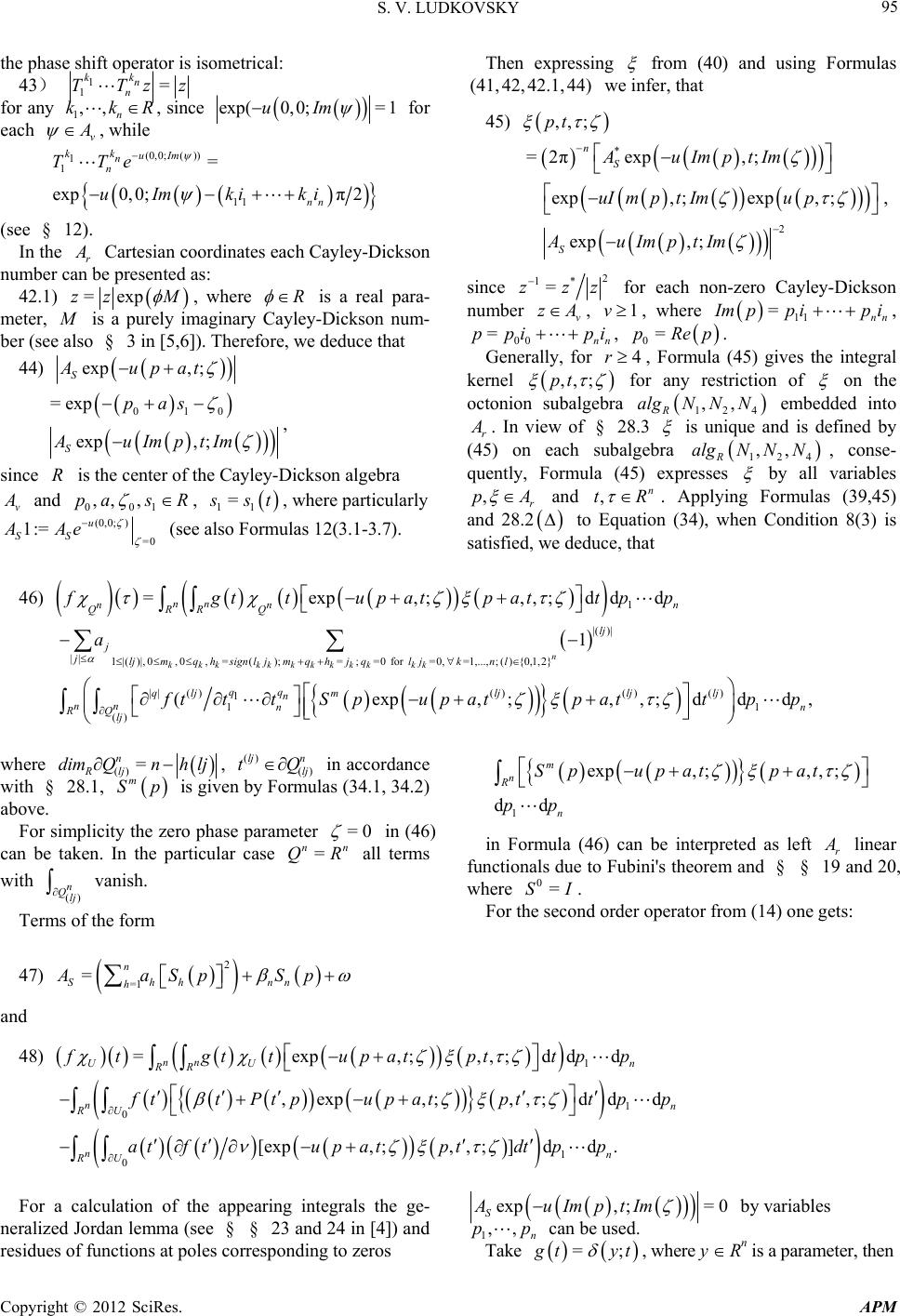 S. V. LUDKOVSKY Copyright © 2012 SciRes. APM 95 the phase shift operator is isometrical: 43) 1 1= k kn n TTzz for any 1,, n kkR, since exp(0, 0;= 1uIm for each v , while (0,0;( )) 1 1 11 = exp0, 0;π2 k kuIm n n nn TTe uIm kiki (see § 12). In the r Cartesian coordinates each Cayley-Dickson number can be presented as: 42.1) =expzz M , where R is a real para- meter, is a purely imaginary Cayley-Dickson num- ber (see also § 3 in [5,6]). Therefore, we deduce that 44) exp, ; S Aupat 010 =exp exp,; S pas AuImpt Im , since R is the center of the Cayley-Dickson algebra v and 001 , , , pas R , 11 = st, where particularly (0,0; ) =0 1:=u SS AAe (see also Formulas 12(3.1-3.7). Then expressing from (40) and using Formulas (41, 42,42.1, 44) we infer, that 45) ,, ;pt * 2 =2πexp,; exp,;exp,; exp,; n S S AuImptIm uImpt Imup AuImptIm , since 2 1* =zzz for each non-zero Cayley-Dickson number v zA , 1v, where 11 =nn mp pipi, 00 =nn ppi pi , 0=pRep . Generally, for 4r, Formula (45) gives the integral kernel ,, ;pt for any restriction of on the octonion subalgebra 124 ,, R algN NN embedded into r . In view of § 28.3 is unique and is defined by (45) on each subalgebra 124 ,, R algNNN, conse- quently, Formula (45) expresses by all variables ,r pA and , n tR . Applying Formulas (39,45) and 28.2 to Equation (34), when Condition 8(3) is satisfied, we deduce, that 46) 1 =exp,;,,;ddd nn nn n RR QQ gttup atp attpp |( )| || 1|()|, 0, 0, =(); =; =0for=0, =1,...,; (){0,1,2} || ()()()() 1 1 1 () 1 (exp,;,,;dd n kkkkkkkkkkkk lj j jljmqhsignl jmqhjql jknl q q q ljmljljlj n nn n RQ lj a ftttSpup atp attp d, n p where ()= n Rlj dimQnh lj , () () lj n lj tQ in accordance with § 28.1, m Sp is given by Formulas (34.1, 34.2) above. For simplicity the zero phase parameter =0 in (46) can be taken. In the particular case = nn QR all terms with () n Qlj vanish. Terms of the form 1 exp, ;, ,; dd m n R n Sp upatpat pp in Formula (46) can be interpreted as left r linear functionals due to Fubini's theorem and § § 19 and 20, where 0=SI. For the second order operator from (14) one gets: 47) 2 =1 =n Shhnn h AaSp Sp and 48) 1 =exp,;,,;ddd nn UU n RR tgttupatpttpp 1 0 1 0 ,exp,;,,;dd d [exp, ;,,;]dd. nn RU nn RU ttPtp upatpttpp atf tu patptdtpp For a calculation of the appearing integrals the ge- neralized Jordan lemma (see § § 23 and 24 in [4]) and residues of functions at poles corresponding to zeros exp,;= 0 S AuImptIm by variables 1,, n pp can be used. Take =; tyt , where y Rn is a parameter, then 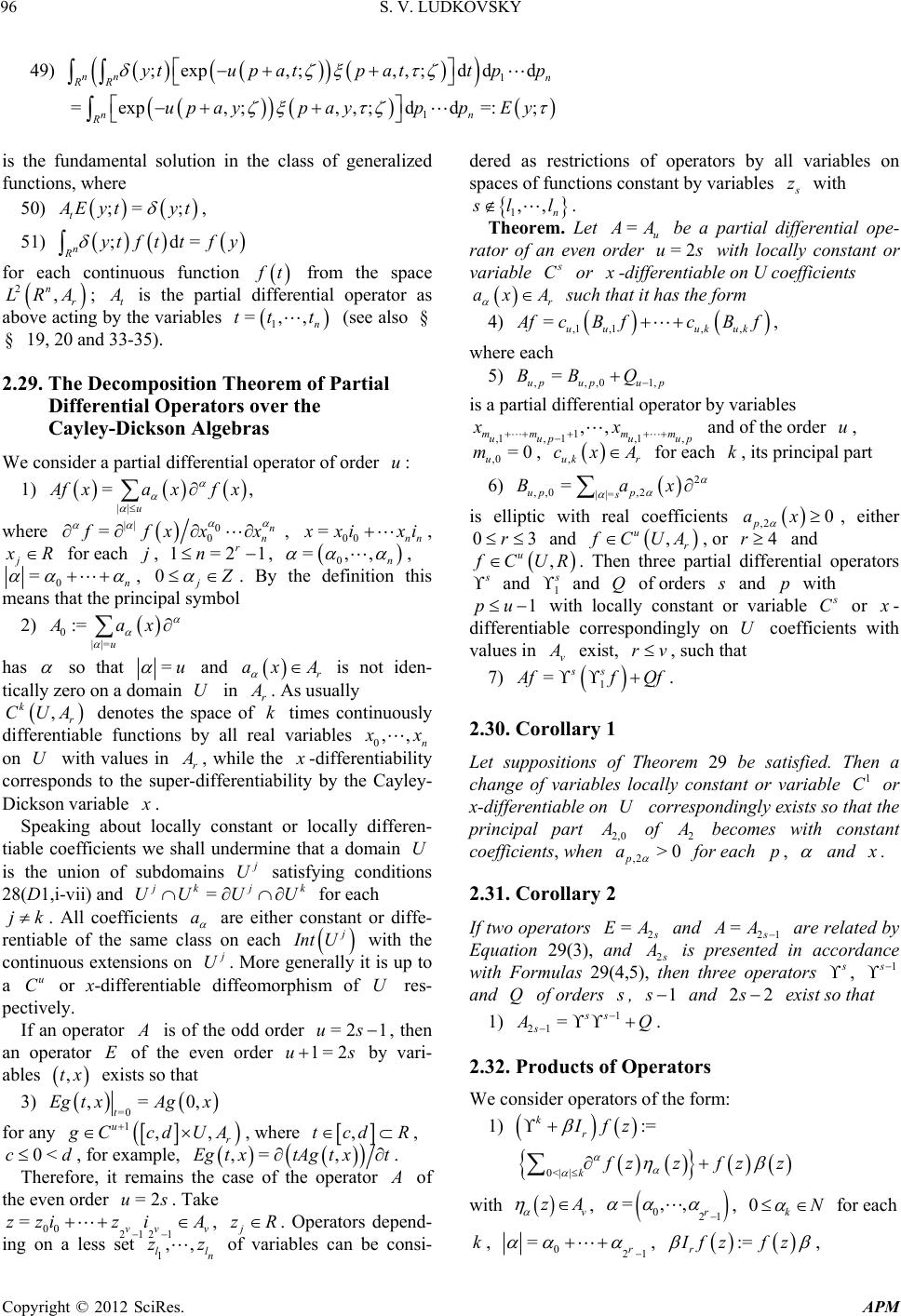 S. V. LUDKOVSKY Copyright © 2012 SciRes. APM 96 49) 1 ;exp,;,,; ddd nn n RR ytup atpattpp 1 =exp ,;,,;dd=:; nn Rup ayp ayppEy is the fundamental solution in the class of generalized functions, where 50) ;=; t Eyt yt , 51) ;d= n Ryt f ttfy for each continuous function t from the space 2, n r LRA; t is the partial differential operator as above acting by the variables 1 =,, n tt t (see also § § 19, 20 and 33-35). 2.29. The Decomposition Theorem of Partial Differential Operators over the Cayley-Dickson Algebras We consider a partial differential operator of order u: 1) || =, u fxa xfx where || 0 0 =n n fx xx , 00 =nn xi xi , j R for each j, 1=21 r n, 0 =,, n , 0 =n , 0j . By the definition this means that the principal symbol 2) 0 ||= := u Aax has so that =u and r ax A is not iden- tically zero on a domain U in r . As usually , k r CUA denotes the space of k times continuously differentiable functions by all real variables 0,, n x on U with values in r , while the -differentiability corresponds to the super-differentiability by the Cayley- Dickson variable . Speaking about locally constant or locally differen- tiable coefficients we shall undermine that a domain U is the union of subdomains U satisfying conditions 28(D1,i-vii) and = kjk UU U U for each jk. All coefficients a are either constant or diffe- rentiable of the same class on each nt U with the continuous extensions on U. More generally it is up to a u C or x-differentiable diffeomorphism of U res- pectively. If an operator is of the odd order =2 1us , then an operator E of the even order 1=2us by vari- ables ,tx exists so that 3) =0 ,=0, t Egt xAgx for any 1,, u r CcdUA , where ,tcd R, 0<cd, for example, ,= ,EgtxtAgt xt. Therefore, it remains the case of the operator of the even order =2us. Take 00 2121 =vvv zziz iA , j zR. Operators depend- ing on a less set 1,, ll n zz of variables can be consi- dered as restrictions of operators by all variables on spaces of functions constant by variables z with 1,, n ll. Theorem. Let =u A be a partial differential ope- rator of an even order =2us with locally constant or variable C or -differentiable on U coefficients r ax A such that it has the form 4) ,1 ,1,, =uu ukuk fcBfc Bf, where each 5) ,,,01, = upupu p BB Q is a partial differential operator by variables 1 ,1,1,1, ,, mmmm uup uup xx and of the order u, ,0 =0 u m, ,uk r cxA for each k, its principal part 6) 2 ,,0 ,2 ||= = up p s Bax is elliptic with real coefficients ,2 0 p ax , either 03r and , u r CUA, or 4r and , u CUR. Then three partial differential operators and 1 and Q of orders and p with 1pu with locally constant or variable C or - differentiable correspondingly on U coefficients with values in v exist, rv , such that 7) 1 =ss ffQf . 2.30. Corollary 1 Let suppositions of Theorem 29 be satisfied. Then a change of variables locally constant or variable 1 C or x-differentiable on U correspondingly exists so that the principal part 2,0 of 2 becomes with constant coefficients, when ,2 >0 p a for each p, and . 2.31. Corollary 2 If two operators 2 = EA and 21 = A are related by Equation 29( 3), and 2 is presented in accordance with Formulas 29(4,5), then three operators , 1 and Q of orders , 1 and 22 exist so that 1) 1 21 =ss s Q . 2.32. Products of Operators We consider operators of the form: 1) := k r Ifz 0<|| k zzfzz with v zA , 021 =,, r , 0kN for each k, 021 =r , := r fz fz , 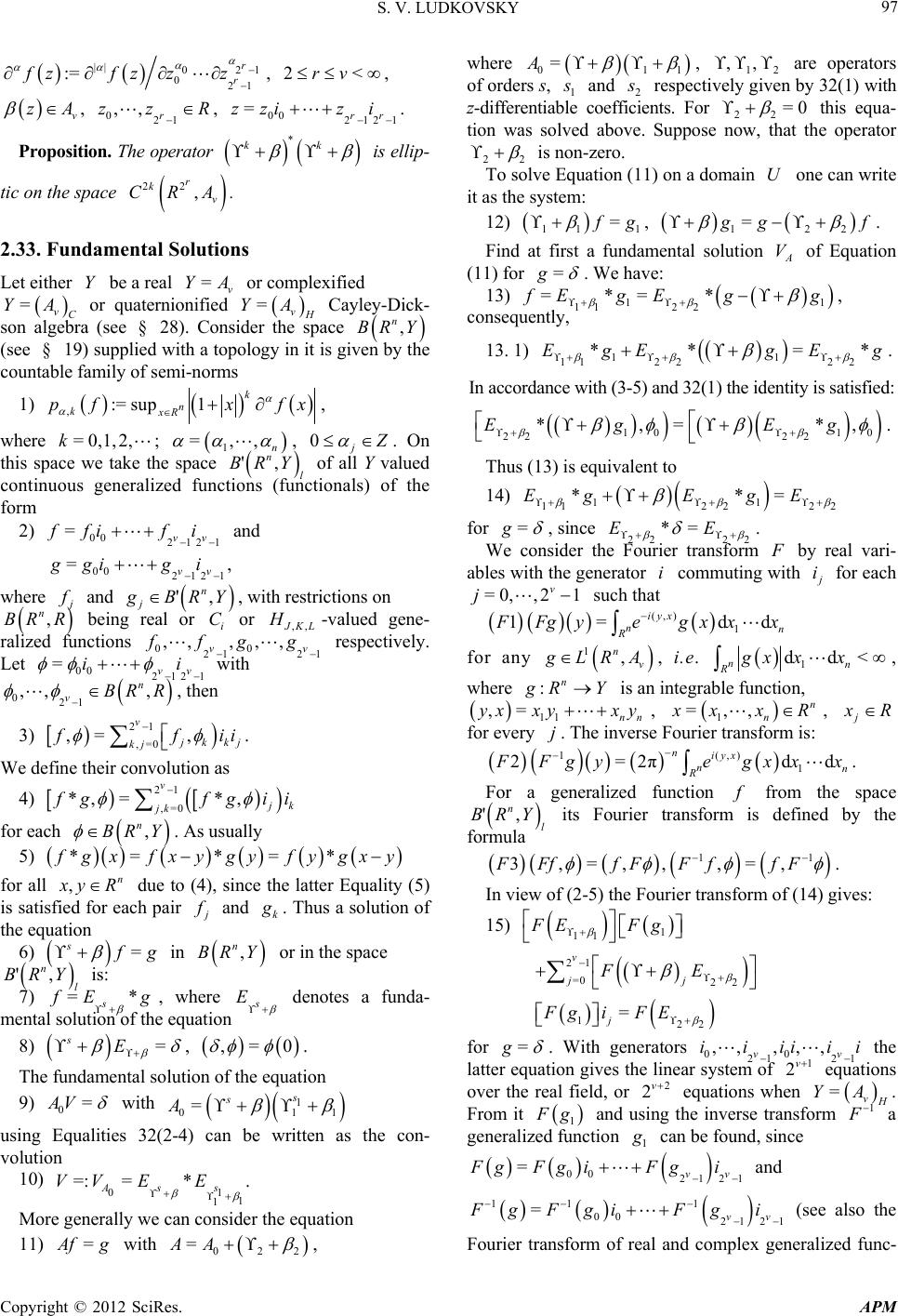 S. V. LUDKOVSKY Copyright © 2012 SciRes. APM 97 || 021 021 := r r fzfz zz , 2<rv , v zA , 021 ,, r zz R , 002121 =rr zziz i . Proposition. The operator * kk is ellip- tic on the space 22 , r k v CRA . 2.33. Fundamental Solutions Let either Y be a real =v YA or complexified =vC YA or quaternionified =v YA Cayley-Dick- son algebra (see § 28). Consider the space , n BR Y (see § 19) supplied with a topology in it is given by the countable family of semi-norms 1) ,:= 1 sup k n kxR pfx fx , where =0,1,2,k; 1 =,, n , 0j . On this space we take the space ', n l BRY of all Y valued continuous generalized functions (functionals) of the form 2) 00 2121 =vv fifi and 00 2121 =vv gig i , where and ', n j BRY, with restrictions on , n BRR being real or i C or ,, KL H-valued gene- ralized functions 00 21 21 ,, ,,, vv ffgg respectively. Let 00 2121 =vv ii with 021 ,, , n vBR R , then 3) 21 ,=0 ,= , v kkj kj fii . We define their convolution as 4) 21 ,=0 *, =*, v k jk gfgii for each , n BR Y . As usually 5) *= *=* gxfxy gyfy gxy for all ,n yR due to (4), since the latter Equality (5) is satisfied for each pair and k . Thus a solution of the equation 6) = s g in , n BR Y or in the space ', n l BRY is: 7) =* s Eg , where s E denotes a funda- mental solution of the equation 8) = sE , ,=0 . The fundamental solution of the equation 9) 0=AV with 1 011 =s s A using Equalities 32(2-4) can be written as the con- volution 10) 01 1 1 =: =*. As s VV EE More generally we can consider the equation 11) = fg with 022 =AA , where 011 =A , 12 , , are operators of orders s, 1 and 2 respectively given by 32(1) with z-differentiable coefficients. For 22 =0 this equa- tion was solved above. Suppose now, that the operator 22 is non-zero. To solve Equation (11) on a domain U one can write it as the system: 12) 11 1 = g , 122 = gf . Find at first a fundamental solution A V of Equation (11) for =g . We have: 13) 11 112 2 =*= * EgE gg , consequently, 13. 1) 11 112 22 2 ** =*EgEgE g . In accordance with (3-5) and 32(1) the identity is satisfied: 10 10 22 22 *,= *,Eg Eg . Thus (13) is equivalent to 14) 11 112 22 2 **=EgE gE for =g , since 2222 *=EE . We consider the Fourier transform by real vari- ables with the generator i commuting with i for each =0, ,21 v j such that (,) 1 1= dd iyx nn R Fgyeg xxx for any 1, n v LR A, i.e. 1 dd< nn Rgx xx , where :n RY is an integrable function, 11 ,= nn xxy xy, 1 =,, n n xxR, j R for every j. The inverse Fourier transform is: 1(,) 1 2=2πdd niyx nn R Fgyegx xx . For a generalized function from the space ', n l BRY its Fourier transform is defined by the formula 11 3,=,,,=,FFffFFffF . In view of (2-5) the Fourier transform of (14) gives: 15) 1 11 EFg 21 =0 22 122 = v jj j FE Fg iFE for =g . With generators 00 2121 ,, ,,, vv iiiiii the latter equation gives the linear system of 1 2v equations over the real field, or 2 2v equations when =v YA. From it 1 g and using the inverse transform 1 a generalized function 1 can be found, since 00 2121 =vv gFgiFg i and 11 1 00 21 21 =vv gFgiFgi (see also the Fourier transform of real and complex generalized func- 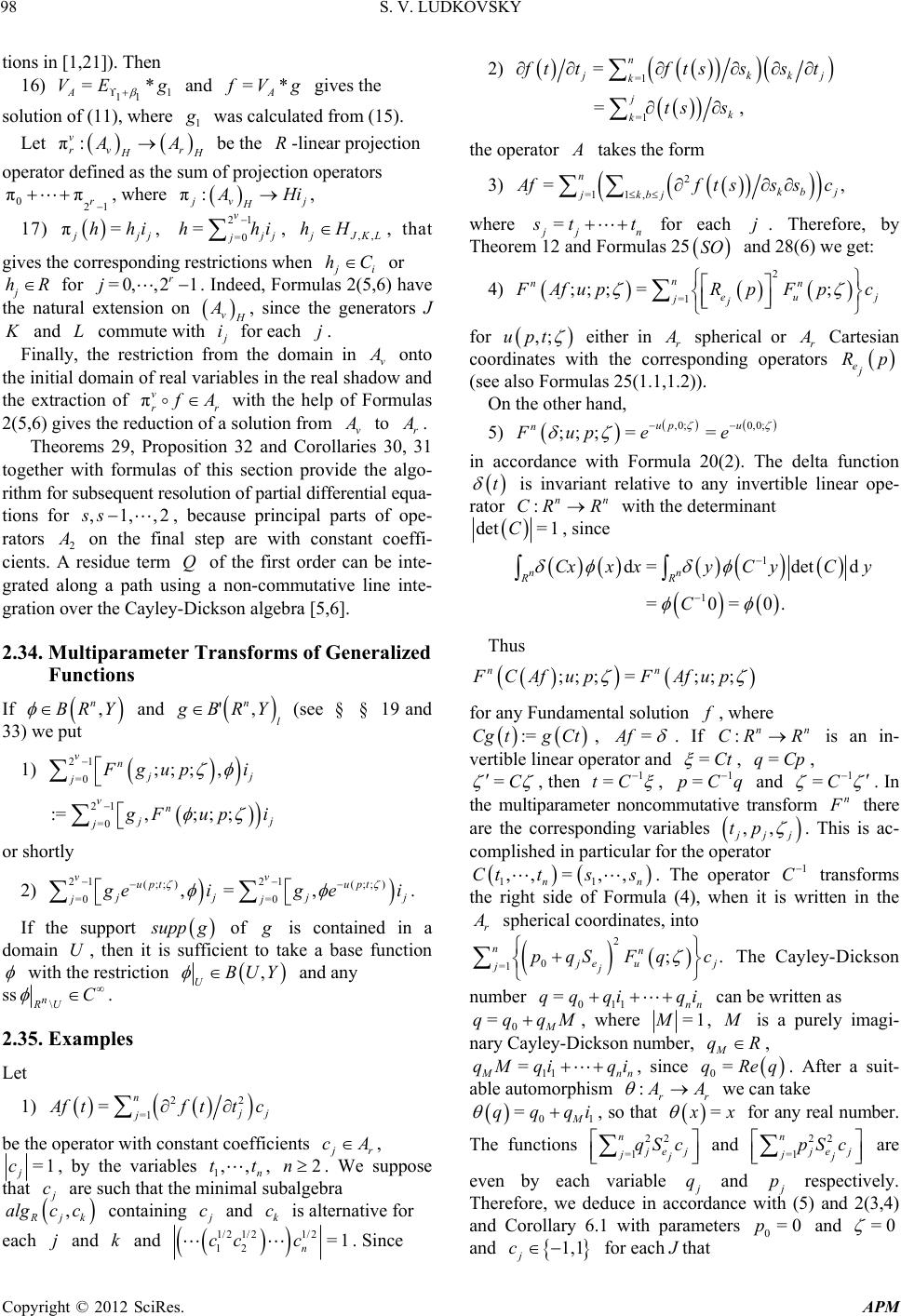 S. V. LUDKOVSKY Copyright © 2012 SciRes. APM 98 tions in [1,21]). Then 16) 1 11 =* A VE g and =* A Vg gives the solution of (11), where 1 was calculated from (15). Let π: v rv r H AA be the R-linear projection operator defined as the sum of projection operators 021 ππ r , where π: vj H Hi, 17) π= jj hhi, 21 =0 = v j j hhi , ,, JKL hH, that gives the corresponding restrictions when i hC or j hR for =0,,21 r j. Indeed, Formulas 2(5,6) have the natural extension on v A, since the generators J and L commute with i for each j. Finally, the restriction from the domain in v onto the initial domain of real variables in the real shadow and the extraction of πv rr A with the help of Formulas 2(5,6) gives the reduction of a solution from v to r . Theorems 29, Proposition 32 and Corollaries 30, 31 together with formulas of this section provide the algo- rithm for subsequent resolution of partial differential equa- tions for ,1,,2ss, because principal parts of ope- rators 2 on the final step are with constant coeffi- cients. A residue term Q of the first order can be inte- grated along a path using a non-commutative line inte- gration over the Cayley-Dickson algebra [5,6]. 2.34. Multiparameter Transforms of Generalized Functions If , n BR Y and ', n l BRY (see § § 19 and 33) we put 1) 21 =0 ;; ;, vn j j gup i 21 =0 :=,; ;; vn j j Fupi or shortly 2) 21 21 (;;) (;;) =0 =0 ,=, vv uptupt jj j jj ei gei . If the support upp g of is contained in a domain U, then it is sufficient to take a base function with the restriction , UBUY and any ss \ n RU C . 2.35. Examples Let 1) 22 =1 =n j j ftftt c be the operator with constant coefficients r cA, =1 j c, by the variables 1,, n tt, 2n. We suppose that c are such that the minimal subalgebra , jk algc c containing c and k c is alternative for each j and k and 1/2 1/21/2 12 =1 n cc c. Since 2) =1 =n kkj k ttftss st =1 =j k kts s , the operator takes the form 3) 2 =11 , =, n kb j jkbj fftsssc where = jn tt for each j. Therefore, by Theorem 12 and Formulas 25 SO and 28(6) we get: 4) 2 =1 ;; ;=; n nn eu j jj Afu pRpFpc for ,;upt either in r spherical or r Cartesian coordinates with the corresponding operators ej Rp (see also Formulas 25(1.1,1.2)). On the other hand, 5) ,0; 0,0; ;; ;== up u n Fupee in accordance with Formula 20(2). The delta function t is invariant relative to any invertible linear ope- rator :nn CR R with the determinant det= 1C, since 1 1 d=det d =0=0. nn RR CxxxyC yCy C Thus ;; ;=;; ; nn FCAfupFAfup for any Fundamental solution , where :=Cg tg Ct, =Af . If :nn CR R is an in- vertible linear operator and =Ct , =qCp, =C , then 1 =tC , 1 =pCq and 1 =C . In the multiparameter noncommutative transform n there are the corresponding variables ,, jj tp . This is ac- complished in particular for the operator 11 ,,= ,, nn Ct tss. The operator 1 C transforms the right side of Formula (4), when it is written in the r spherical coordinates, into 2 0 =1 ;. nn euj jj pqS Fqc The Cayley-Dickson number 011 =nn qq qiqi can be written as 0 =M qq qM , where =1M, is a purely imagi- nary Cayley-Dickson number, M qR, 11 = nn qM qiqi , since 0=qReq . After a suit- able automorphism :rr A we can take 01 =M qqqi , so that = x for any real number. The functions 22 =1 n ej jj qS c and 22 =1 n ej jj pS c are even by each variable q and p respectively. Therefore, we deduce in accordance with (5) and 2(3,4) and Corollary 6.1 with parameters 0=0p and =0 and 1,1 j c for each J that  S. V. LUDKOVSKY Copyright © 2012 SciRes. APM 99 6) 1 n F =11 , ([ ],[ ]) 1/;;; =, n ke bej jkbj kb Nyq pS pScuy ge in the r spherical coordinates, where 2 =1 =1/n j j qc , or 6.1) 122 =1 1/; ; ; n n je j jj FpScuy 122 =1 1/; ; ; n n je j jj FpScuy in the r Cartesian coordinates, where 2 =1 =1/n j j pc , =Nyy for 0y, 1 =Ni for =0y, 11 =nn r yyiyiA , 1,, n n yy yR, =1 [],[]= n j j yq yq , since 2cos= cosπ=cos ek kk k S and 2sin= sinπ=sin ek kk k S for each k. Particularly, we take =1 j c for each =1, ,jk and =1 j c for any =1,,jk n , where 1kn . Thus the inverse Laplace transform for 0=0q and =0 in accordance with Formulas 2(1-4) reduces to 7) 1 =11 , 1;;; n n ke bej jkbj kb FpSpScuy 22 11 1 =1= 1 =2πexp1dd nkn nnnjjn jjk Riqyqyqq qq in the r spherical coordinates and 7.1) 122 22 11 1 =1=1= 1 1;;;=2πexp...1d d n nkn n n ejnnjjn jjjk jR pS cuyipypypppp in the Ar Cartesian coordinates, since for any even func- tion its cosine Fourier transform coincides with the Fou- rier transform. The inverse Fourier transform 1=2π=: n n Fg xFgx of the functions 2 =1 =1 n j z for 3n and 22 =1 1j j Pz for =2n in the class of the generalized functions is known (see [21] and § § 9.7 and 11.8 [1]) and gives 8) 1/2 2 1=1 ,, = n n nnnj j zzC z for 3n, where =12 nn Cn , /2 =4π21 n nn denotes the surface of the unit sphere in n R, denotes Euler’s gamma-function, while 9) 22 212 2=1 ,=ln j zz Cz for =2n, where 2=14πC. Thus the technique of § 2 over the Cayley-Dickson algebra has permitted to get the solution of the Laplace operator. For the function 10) 22 =1=1 =kn j jjk Px xx with 1<kn the generalized functions 0Px i and 0Px i are defined for any =CRiR (see Chapter 3 in [21]). The function P has the cone surface 1,, =0 n Pz z of zeros, so that for the correct definition of generalized functions corresponding to P the generalized functions 11) /2 22 0< ,0 0= lim c Px ciPx exp iargPx ic with either =1c or =1c were introduced. There- fore, the identity 12) ,knk x 2 22 , =1=1 =kn jjknk jjk xFx or 13) =1 0 Px ci follows, where =1c or =1c. The inverse Fourier transform in the class of the ge- neralized functions is: 14) 1 1 0,, n Px cizz 2/2 /2) 1/2 1 =exp π22 π2 ,,0 nn n n cn kin QzzciD for each C and 3n (see § IV.2.6 [21]), where , =det k Dg denotes a discriminant of the quadratic form , ,=1 =n kjk jk Pxgxx , while 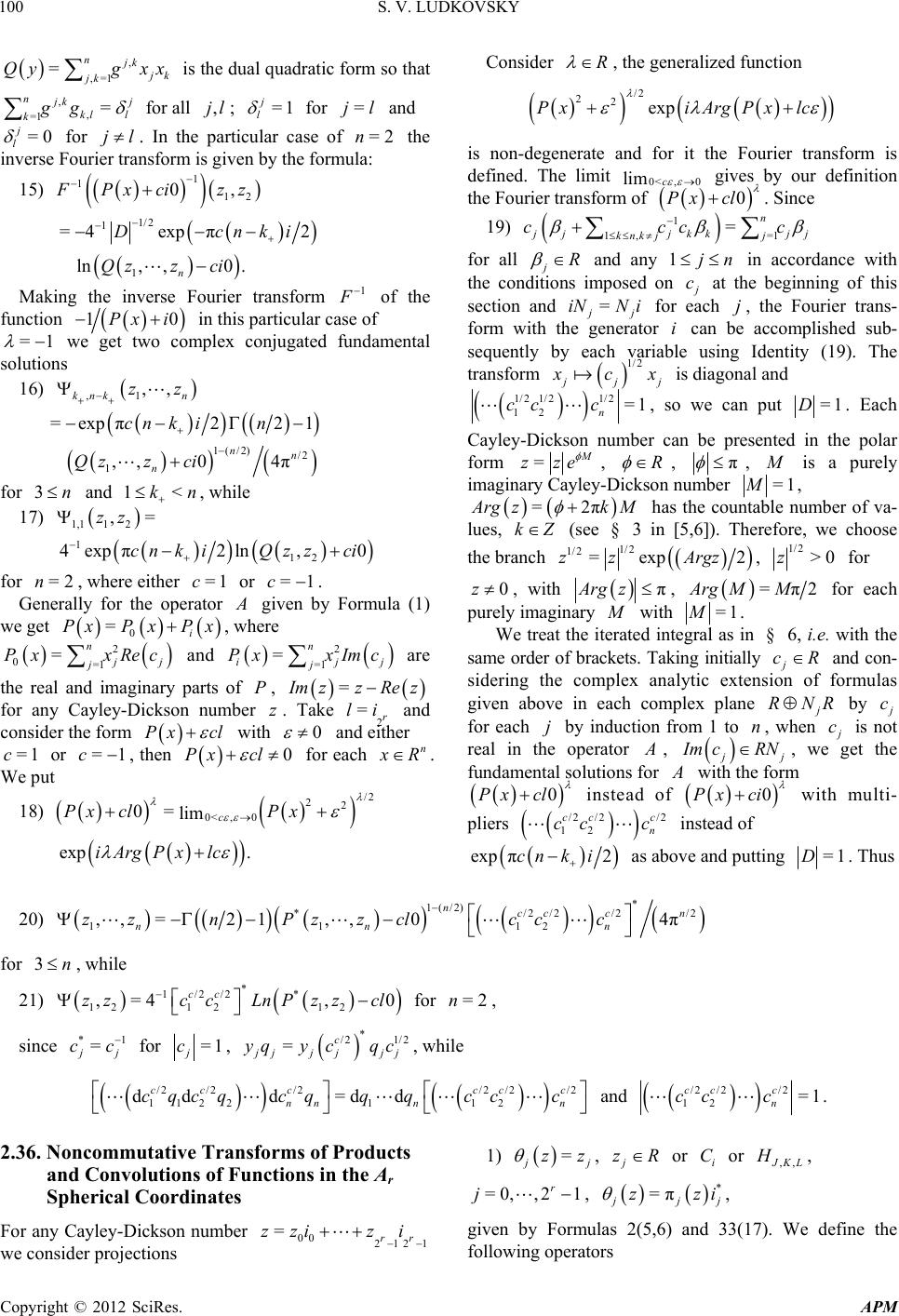 S. V. LUDKOVSKY Copyright © 2012 SciRes. APM 100 , ,=1 =njk k jk Qyg xx is the dual quadratic form so that , , =1 = n kj kl l kgg for all ,jl; =1 j l for =jl and =0 j l for jl. In the particular case of =2n the inverse Fourier transform is given by the formula: 15) 1 1 12 0, Pxciz z 1/2 1 1 =4exp π2 ln,,0. n Dcnki Qzz ci Making the inverse Fourier transform 1 of the function 10Px i in this particular case of =1 we get two complex conjugated fundamental solutions 16) ,1 ,, knk n zz 1(/2) /2 1 =expπ221 ,,04π nn n cn kin Qzzci for 3n and 1<kn , while 17) 1,11 2 ,=zz 1 12 4expπ2ln ,0cnkiQz zci for =2n, where either =1c or =1c. Generally for the operator given by Formula (1) we get 0 =i PxPxP x, where 2 0=1 =n j j Px xRec and 2 =1 =n ijj j Px xImc are the real and imaginary parts of P, = mzz Rez for any Cayley-Dickson number z. Take 2 =r li and consider the form Px cl with 0 and either =1c or =1c, then 0Pxcl for each n R. We put 18) /2 22 0< ,0 0= lim c Px clPx exp .iArgPx lc Consider R , the generalized function /2 22expPxi ArgPxlc is non-degenerate and for it the Fourier transform is defined. The limit 0< ,0 lim c gives by our definition the Fourier transform of 0Pxcl . Since 19) 1 1, =1 =n jjkkjj knk jj cccc for all jR and any 1jn in accordance with the conditions imposed on c at the beginning of this section and = j iNNi for each j, the Fourier trans- form with the generator i can be accomplished sub- sequently by each variable using Identity (19). The transform 1/2 jj cx is diagonal and 1/2 1/21/2 12 =1 n cc c, so we can put =1D. Each Cayley-Dickson number can be presented in the polar form = zze , R , π , is a purely imaginary Cayley-Dickson number =1M, =2π rg zk M has the countable number of va- lues, kZ (see § 3 in [5,6]). Therefore, we choose the branch 1/2 1/2 =exp 2zz Argz, 1/2 >0z for 0z , with πArg z , =π2Arg MM for each purely imaginary with =1M. We treat the iterated integral as in § 6, i.e. with the same order of brackets. Taking initially j cR and con- sidering the complex analytic extension of formulas given above in each complex plane RNR by c for each j by induction from 1 to n, when c is not real in the operator , j mc RN, we get the fundamental solutions for with the form 0Pxcl instead of 0Px ci with multi- pliers /2 /2/2 12 cc c n cc c instead of exp π2cnki as above and putting =1D. Thus 20) * 1(/2) */2/2/2/2 1112 ,, =21,,04π ncc cn nnn zznPzzclcc c for 3n, while 21) * 1/2/2 * 121 212 ,=4, 0 cc zzc cLnP zzcl for =2n, since *1 = j cc for =1 j c, * /2 1/2 =c jjj jj yqy cqc, while /2/2/2/2 /2/2 11221 12 ddd =dd ccccc c nn nn cqcqcqqqccc and /2 /2/2 12 =1 cc c n cc c. 2.36. Noncommutative Transforms of Products and Convolutions of Functions in the Ar Spherical Coordinates For any Cayley-Dickson number 00 2121 =rr zziz i we consider projections 1) = j zz , j zR or i C or ,, KL H, =0, ,21 r j , * =π jj zzi , given by Formulas 2(5,6) and 33(17). We define the following operators  S. V. LUDKOVSKY Copyright © 2012 SciRes. APM 101 2) 11 , ,011 , ;:=,1,,1, nn jjn j j n RFpFppp 11 , 2011 112 ,,,, ,;,1/2,,1π2,,, jjn njjjn jn jn jnjn pp on images n , 1 221 rr n , =0,,jn. For and {0,1} j their sum j is considered by ( 2)mod, i.e. in the ring 2=2 ZZ , for two vectors and 21 {0,1} r their sum is considered com- ponentwise in 2 . Let 3) 21 =0 =0 ;; ;=;; ;, r n nn kkj jk fupFf upii also 21 =0 ;:=;;; r nn jkk k pFfupi for an original , where ,;upt is given by For- mulas 2(1,2,2.1). If is real or i C or ,, KL H-valued, then = nn jj F . Theorem. If and are two originals, then 4) (1 ) 11, ,0 ,00 =0, {0,1} ;; ;=1;*(;, n nnn jjn n jjjj j fg upRFpqRGpqpi 4.1) (1 ) 11, ,, =0,{0,1} *;;; =1;;, n nnn jjn n jjjj j fgupRFpRG pi whenever n fg , n f, n g exist, where 121 r n , 2r; =1 ( 2) kk mod for kj or =1=kjn, =0 ( 2) kk mod for =1<kj n and ==0 kk for >1kj in the J-th addendum on the right of Formulas (4,4.1); the convolution is by 1,, n pp in (4), at the same time 0 qR and r are fixed. Proof. The product of two originals can be written in the form: 5) 21 =0,: = = r klj jkliii klj tgtftgti . The functions k and l are real or i C or ,, KL H valued respectively. The non-commutative trans- form of g is: 6) 01 111 0 ;=exp,; d=cosd ps n nn RR fgpf tgtupttftgtepsit 1 01 1111 111 =2 01 11 1 sin sincosd sinsind . nps njjjjj jj R j ps nnnn n R tgtepspspsit ftgtepspsi t On the other hand, 7) 010 001() 1 =1=1 =1 d=dd d, kkk ps ipspqsipqsqs iqs jjjjjjjj jjjj jj jjj nnn n RRR R tgtetf tetgtetq where =1,2, ,kn, {1,1} j . Therefore, using Euler’s formula =cos sin i ei and the trigo- nometric formulas cos= coscossinsin , sin= sincoscossin for all , R , and Formulas (6,7), we deduce ex- pressions for n j fg . We get the integration by 1,, n qq, which gives convolutions by the 1,, n pp variables. Here 0 qR and r are any marked numbers. Thus from Formulas (5-7) and 2(1,2,2.1,4) we deduce Formula (4). Moreover, one certainly has 8) 01 0101 () () =1 =1=1 *d=dd kk k ps ipspsipspsips jj jjjj jjjjjjj jj j nnn RRR gtetftet gtet 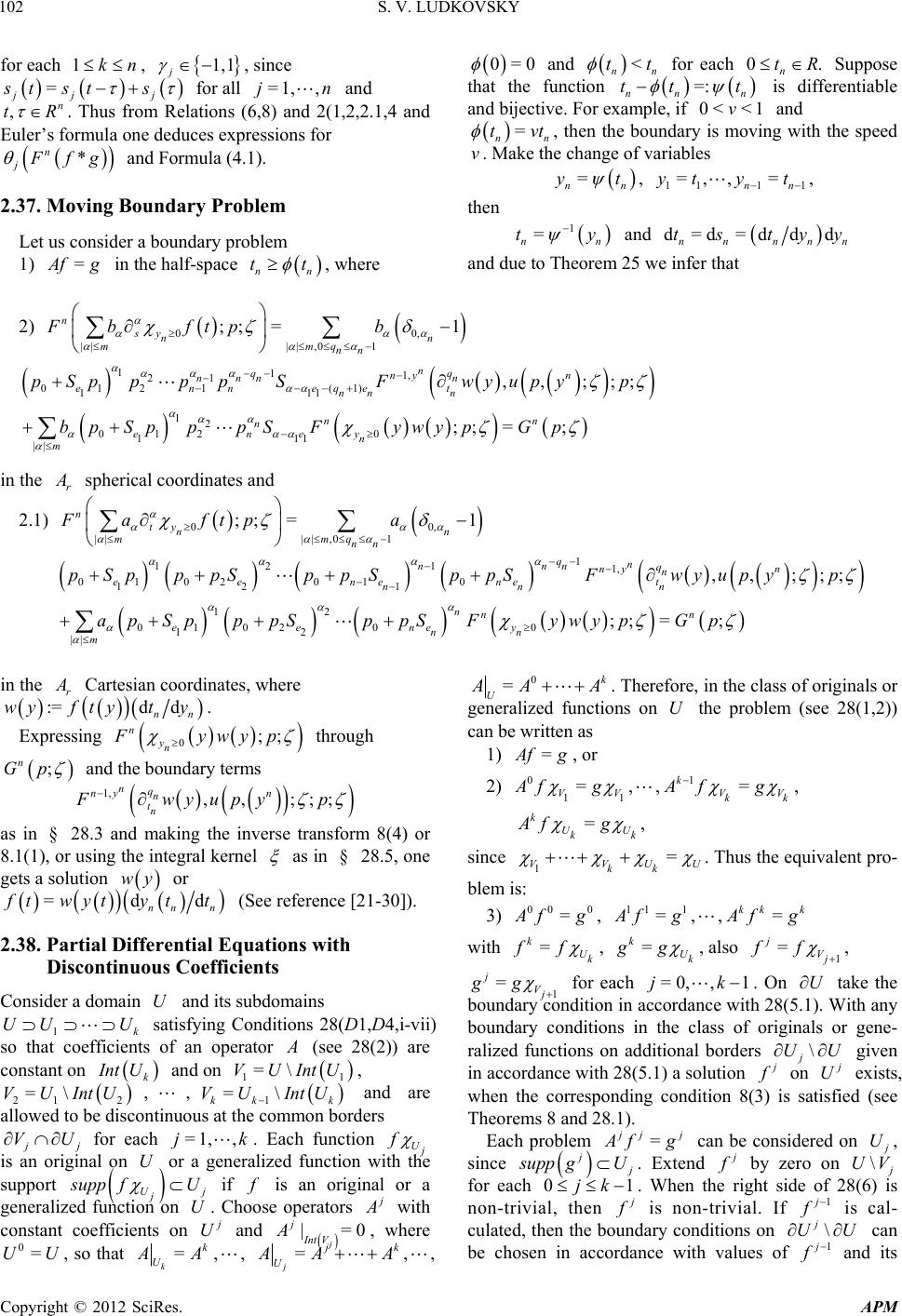 S. V. LUDKOVSKY Copyright © 2012 SciRes. APM 102 for each 1kn, 1,1 j , since = jjj st sts for all =1, ,jn and , n tR . Thus from Relations (6,8) and 2(1,2,2.1,4 and Euler’s formula one deduces expressions for * n j fg and Formula (4.1). 2.37. Moving Boundary Problem Let us consider a boundary problem 1) = fg in the half-space nn tt , where 0=0 and < nn tt for each 0. n tR Suppose that the function =: nn n ttt is differentiable and bijective. For example, if 0< <1v and = nn tvt , then the boundary is moving with the speed v. Make the change of variables = nn t , 111 1 =, ,= nn yt y t , then 1 = nn ty and d=d=d dd nn nnn ts tyy and due to Theorem 25 we infer that 2) 00, |||| ,01 ;; =1 n sy nn mmq nn Fb ftpb 111, 1 2 012 1(1) 111 12 0120 111 || ,, ;;; ;; =; nq qny n n nnn enneqe t nn n nn n eney n m pSppp pSFwyupyp bp SpppSFywypGp in the r spherical coordinates and 2.1) 00, ||||,01 ;; =1 n ty nn mmq nn Fa ftpa 1 1 12 1, 0102 010 12 1 12 0102 00 12 || ,, ;;; ;; =; qn nnn q ny n n eenene t nn n nnn eeney nn m pSpppSppSp pSFwyupyp ap SpppSppSFywypGp in the r Cartesian coordinates, where :=d d nn wyftyty. Expressing 0;; n yn Fywyp through ; n Gp and the boundary terms 1, , ,;;; nq ny n n tn Fwyupyp as in § 28.3 and making the inverse transform 8(4) or 8.1(1), or using the integral kernel as in § 28.5, one gets a solution wy or =dd nnn twytyt t (See reference [21-30]). 2.38. Partial Differential Equations with Discontinuous Coefficients Consider a domain U and its subdomains 1k UU U satisfying Conditions 28(D1,D4,i-vii) so that coefficients of an operator (see 28(2)) are constant on k nt U and on 11 =\VUIntU , 21 2 =\VUIntU ,, 1 =\ kk k VU IntU and are allowed to be discontinuous at the common borders j VU for each =1, ,jk. Each function U f is an original on U or a generalized function with the support Uj j upp fU if is an original or a generalized function on U. Choose operators with constant coefficients on U and |=0 j j Int V A, where 0=UU, so that = k k U A,, = j k U AA,, 0 =k U AA . Therefore, in the class of originals or generalized functions on U the problem (see 28(1,2)) can be written as 1) = fg, or 2) 0 11 = VV fg ,,1= k VV kk Af g , =, k UU kk Afg since 1= VVUU kk . Thus the equivalent pro- blem is: 3) 00 0 = fg, 11 1 = fg,,= kk k fg with = k Uk ff , = k Uk gg , also 1 = j V ff , 1 = j V gg for each =0,,1jk. On U take the boundary condition in accordance with 28(5.1). With any boundary conditions in the class of originals or gene- ralized functions on additional borders \ j UU given in accordance with 28(5.1) a solution on U exists, when the corresponding condition 8(3) is satisfied (see Theorems 8 and 28.1). Each problem = jj fg can be considered on U, since j upp gU. Extend by zero on \ UV for each 01jk . When the right side of 28(6) is non-trivial, then is non-trivial. If 1 is cal- culated, then the boundary conditions on \ j UU can be chosen in accordance with values of 1 and its 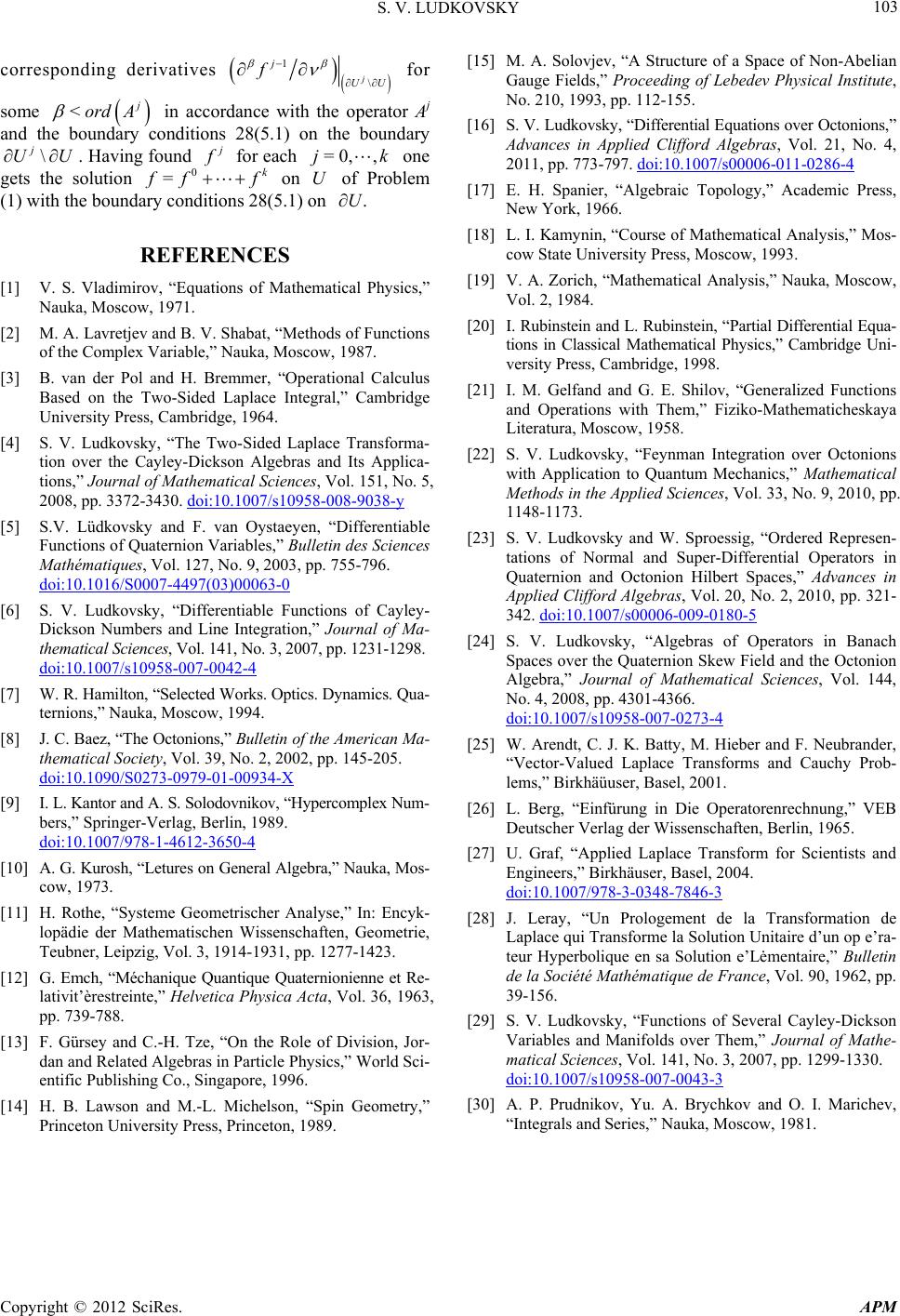 S. V. LUDKOVSKY Copyright © 2012 SciRes. APM 103 corresponding derivatives 1 \ j j UU f for some < ord A in accordance with the operator Aj and the boundary conditions 28(5.1) on the boundary \ j UU. Having found for each =0, ,jk one gets the solution 0 =k ff on U of Problem (1) with the boundary conditions 28(5.1) on .U REFERENCES [1] V. S. Vladimirov, “Equations of Mathematical Physics,” Nauka, Moscow, 1971. [2] M. A. Lavretjev and B. V. Shabat, “Methods of Functions of the Complex Variable,” Nauka, Moscow, 1987. [3] B. van der Pol and H. Bremmer, “Operational Calculus Based on the Two-Sided Laplace Integral,” Cambridge University Press, Cambridge, 1964. [4] S. V. Ludkovsky, “The Two-Sided Laplace Transforma- tion over the Cayley-Dickson Algebras and Its Applica- tions,” Journal of Mathematical Sciences, Vol. 151, No. 5, 2008, pp. 3372-3430. doi:10.1007/s10958-008-9038-y [5] S.V. Lüdkovsky and F. van Oystaeyen, “Differentiable Functions of Quaternion Variables,” Bulletin des Sciences Mathématiques, Vol. 127, No. 9, 2003, pp. 755-796. doi:10.1016/S0007-4497(03)00063-0 [6] S. V. Ludkovsky, “Differentiable Functions of Cayley- Dickson Numbers and Line Integration,” Journal of Ma- thematical Sciences, Vol. 141, No. 3, 2007, pp. 1231-1298. doi:10.1007/s10958-007-0042-4 [7] W. R. Hamilton, “Selected Works. Optics. Dynamics. Qua- ternions,” Nauka, Moscow, 1994. [8] J. C. Baez, “The Octonions,” Bulletin of the American Ma- thematical Society, Vol. 39, No. 2, 2002, pp. 145-205. doi:10.1090/S0273-0979-01-00934-X [9] I. L. Kantor and A. S. Solodovnikov, “Hypercomplex Num- bers,” Springer-Verlag, Berlin, 1989. doi:10.1007/978-1-4612-3650-4 [10] A. G. Kurosh, “Letures on General Algebra,” Nauka, Mos- cow, 1973. [11] H. Rothe, “Systeme Geometrischer Analyse,” In: Encyk- lopädie der Mathematischen Wissenschaften, Geometrie, Teubner, Leipzig, Vol. 3, 1914-1931, pp. 1277-1423. [12] G. Emch, “Méchanique Quantique Quaternionienne et Re- lativit’èrestreinte,” Helvetica Physica Acta, Vol. 36, 1963, pp. 739-788. [13] F. Gürsey and C.-H. Tze, “On the Role of Division, Jor- dan and Related Algebras in Particle Physics,” World Sci- entific Publishing Co., Singapore, 1996. [14] H. B. Lawson and M.-L. Michelson, “Spin Geometry,” Princeton University Press, Princeton, 1989. [15] M. A. Solovjev, “A Structure of a Space of Non-Abelian Gauge Fields,” Proceeding of Lebedev Physical Institute, No. 210, 1993, pp. 112-155. [16] S. V. Ludkovsky, “Differential Equations over Octonions,” Advances in Applied Clifford Algebras, Vol. 21, No. 4, 2011, pp. 773-797. doi:10.1007/s00006-011-0286-4 [17] E. H. Spanier, “Algebraic Topology,” Academic Press, New York, 1966. [18] L. I. Kamynin, “Course of Mathematical Analysis,” Mos- cow State University Press, Moscow, 1993. [19] V. A. Zorich, “Mathematical Analysis,” Nauka, Moscow, Vol. 2, 1984. [20] I. Rubinstein and L. Rubinstein, “Partial Differential Equa- tions in Classical Mathematical Physics,” Cambridge Uni- versity Press, Cambridge, 1998. [21] I. M. Gelfand and G. E. Shilov, “Generalized Functions and Operations with Them,” Fiziko-Mathematicheskaya Literatura, Moscow, 1958. [22] S. V. Ludkovsky, “Feynman Integration over Octonions with Application to Quantum Mechanics,” Mathematical Methods in the Applied Sciences, Vol. 33, No. 9, 2010, pp. 1148-1173. [23] S. V. Ludkovsky and W. Sproessig, “Ordered Represen- tations of Normal and Super-Differential Operators in Quaternion and Octonion Hilbert Spaces,” Advances in Applied Clifford Algebras, Vol. 20, No. 2, 2010, pp. 321- 342. doi:10.1007/s00006-009-0180-5 [24] S. V. Ludkovsky, “Algebras of Operators in Banach Spaces over the Quaternion Skew Field and the Octonion Algebra,” Journal of Mathematical Sciences, Vol. 144, No. 4, 2008, pp. 4301-4366. doi:10.1007/s10958-007-0273-4 [25] W. Arendt, C. J. K. Batty, M. Hieber and F. Neubrander, “Vector-Valued Laplace Transforms and Cauchy Prob- lems,” Birkhäüuser, Basel, 2001. [26] L. Berg, “Einfürung in Die Operatorenrechnung,” VEB Deutscher Verlag der Wissenschaften, Berlin, 1965. [27] U. Graf, “Applied Laplace Transform for Scientists and Engineers,” Birkhäuser, Basel, 2004. doi:10.1007/978-3-0348-7846-3 [28] J. Leray, “Un Prologement de la Transformation de Laplace qui Transforme la Solution Unitaire d’un op e’ra- teur Hyperbolique en sa Solution e’Lėmentaire,” Bulletin de la Société Mathématique de France, Vol. 90, 1962, pp. 39-156. [29] S. V. Ludkovsky, “Functions of Several Cayley-Dickson Variables and Manifolds over Them,” Journal of Mathe- matical Sciences, Vol. 141, No. 3, 2007, pp. 1299-1330. doi:10.1007/s10958-007-0043-3 [30] A. P. Prudnikov, Yu. A. Brychkov and O. I. Marichev, “Integrals and Series,” Nauka, Moscow, 1981.
|